- Search Please fill out this field.
- Newsletters
- Destinations

Walking Tour of Intramuros
This is where Manila was Born
:max_bytes(150000):strip_icc():format(webp)/mike_borobudur-5b6d3ea446e0fb0025fcb683.jpg)
Michael Runkel / Getty Images
For hundreds of years, the walled city of Intramuros was Manila : the nerve center of the Spanish occupation in the Philippines , home to several thousand Spanish colonists, their families, and their Filipino servants.
Intramuros was erected on the ruins of a Malay settlement at the mouth of the Pasig River. Its strategic location attracted the attention of the conquistador Miguel Lopez de Legazpi, who took over the area in 1571 and proclaimed it as the Philippine colony's new capital.
For 400 years, Intramuros was the center of Spanish political, religious, and military power in the region. (Read about churches in the Philippines .) The walled city suffered grievously through World War II; only San Agustin Church was left standing by war's end.
In the 1980s, the government led a major restoration effort that reconstructed Intramuros to its present state. Today, Intramuros is a prominent tourist spot where visitors can experience Spanish-era Manila through the walled city's churches, restaurants, and museums.
Beginning Your Intramuros Walking Tour
Begin at the Intramuros Visitors' Center at the restored Baluartillo de San Francisco Javier in Fort Santiago ( Google Maps ). This is an ideal jumping-off point for many walking tours through Intramuros, or independent visits to Intramuros' top sights .
At the Center, you can pick up brochures on the places you plan to see or find out about scheduled cultural events in the Walled City.
Fort Santiago is easily accessible via taxi, jeepney, or LRT (the Central Terminal Station is the closest stop). Read about Manila's commuter rail system for more details.
The tour will take about two hours and involves a fair amount of walking. We recommend you avoid walking in the middle of the day; limit your trips to before 9am, or after 4pm to avoid sunstroke or sunburn .
To fully enjoy your trip, you'll need:
- a carry bag for souvenirs
- comfortable shoes
- bottled water
First Stop: Fort Santiago
Fort Santiago ( Google Maps ) was built by Spanish conquistadors in 1571, replacing the destroyed fortress belonging to the last datu (king) of pre-Hispanic Manila.
Over the years, Fort Santiago served as a fortress against marauding Chinese pirates, a prison for Spanish-era political prisoners, and a Japanese torture chamber in World War II. American bombs deployed during the Battle for Manila almost succeeded in destroying the Fort altogether.
A postwar government initiative helped restore Fort Santiago and clean its bad juju away. Today, Fort Santiago is a relaxing place to visit and an enlightening portal into the Philippines' colonial past. It contains a peaceful park, battlements overlooking the Pasig River, and a memorial museum to the Philippines' national hero Jose Rizal.
For more information, read our overview of Fort Santiago in the Philippines .
Next Stop: Manila Cathedral
Exit the main gate of Fort Santiago and make a five- to ten-minute walk southeast down General Luna Street, past the Plaza Moriones and the Palacio del Gobernador. The Cathedral will be visible to your left.
The Manila Cathedral (Cabildo cor. Beaterio Streets, Intramuros; Google Maps ) is the ecclesiastical seat of the Archdiocese of Manila. In Spanish colonial times, this was the seat of the Spanish Archbishop of Manila, who had jurisdiction over the entire archipelago .
This structure is actually the sixth church to occupy the site. The first one, built in 1581, was razed to the ground two years after it was built. The present structure was completed in 1958.
The Cathedral's crypts serve as a final resting place for former Archbishops of Manila, just as the crypts of St. Peter's in the Vatican do for the bodies of former Popes. Among those interred in the Cathedral's crypts is Jaime Cardinal Sin, one of the ringleaders of the 1986 Edsa Revolution that ousted the dictator Ferdinand Marcos.
Next Stop: Walls of Intramuros/Puerta de Santa Lucia
A further five-minute walk down General Luna Street in the same direction; after two blocks, turn right and walk down Calle Real until you reach Puerta de Sta. Lucia.
Facing the former Malecon Drive (now Bonifacio Drive), Puerta de Santa Lucia ( Google Maps ) is one of several gates passing through the Intramuros walls. First built in 1603, Puerta de Santa Lucia (when open) leads out to Malecon, once a waterfront promenade before reclamation transformed the shores in front of the walls into the present-day Port Area.
Passersby get a close-up look at the thick stone walls and moats that skirt Intramuros' borders, as the walls can actually be climbed for a commanding view of the streets within Intramuros and the golf course beyond the wall.
During Manila's colonial heyday, no one could enter Intramuros but the Spanish, their servants, and mestizos (half-Spanish Filipinos). Outside Manila lived Filipinos and Chinese merchants. The latter were forced to live in a ghetto that was conveniently located within range of Intramuros' cannons, in case the Chinese revolted against Spanish rule.
Next Stop: San Agustin Church and Museum
Go back up Calle Real, turn right on Gen. Luna Street and enter the parking lot of San Agustin Church immediately on your right.
The San Agustin Church (Calles Gen Luna and Real, Intramuros; Google Maps ) is the first European stone church designed along Spanish lines in Manila. It has 14 side chapels, hand-carved hardwood pews dating back to the 17th century, an 18th-century pipe organ, and a beautiful trompe l'oeil ceiling. Beside the church is a small museum featuring Spanish-era vestments, furniture, and religious artwork.
Along with three other ancient Philippine churches, San Agustin Church was designated a UNESCO World Heritage Site in 1993.
Its walls have stood as a mute witness to Philippine history. Three Spanish conquistadors are buried here. In its vestry, Spanish and American commanders discussed the city's terms of surrender during the Spanish-American War. Japanese soldiers massacred 140 people on the premises during World War II, as the American troops approached Intramuros.
For the bloody details, read our overview of San Agustin Church .
Next and Final Stop: Casa Manila
Go back the way you came, through the parking lot—cross the street to get to the Plaza San Luis Complex.
Plaza San Luis (Calle Real del Palacio, Intramuros; Google Maps ) was a pet project of Imelda Marcos (she of the 7,000 shoes): its centerpiece is Casa Manila , a reconstruction of a Spanish colonial home of the 19th century. (The whole structure itself dates back only to 1981.)
Each room in Casa Manila is decorated in period style, complete with antique furniture, fixtures, and artwork.
Beyond Casa Manila, the Plaza San Luis Complex contains several other stops that will hold any tourist's interest: the White Knight Intramuros budget hotel; Puesto Manila , a creative hub and cafe; Barbara's, a Filipino restaurant; and Bambike Ecotours , which takes guests on tours of top Manila stops using bamboo bikes.
Related Articles
More related articles.

Take a DIY tour of Intramuros with the help of these free colorful maps

We recently went on a walking tour in Binondo with the rest of our editorial team where we explored some of the best spots to eat, contemplate, get a glimpse of history, and of course, take Instagram-worthy photos in the historic Chinatown.
But that was just a fraction of the rest of Manila which is begging to be explored by locals. South of Binondo is Escolta with its historied architecture and houses where the elite once resided.
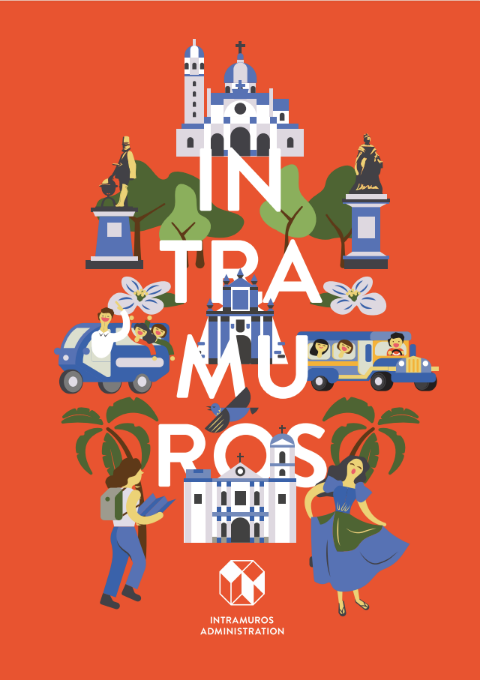
Even further south are the fortifications of Intramuros which once housed the colonial powers. Nowadays, people merely know the complex for its historical value and the universities inside it.
However, Intramuros has so much more to offer, which one can glimpse with the help of their newly released walking tour brochures.
Vibrant as they are educational, these five-fold brochures are updated versions of the existing ones distributed by the Intramuros Administration. All four maps were designed by The Public School Manila who manages most of the creative side of the rebranding of Intramuros.
Apart from the main map which covers the entirety of Intramuros, there are also three supplementary ones of the three other sites managed by the Intramuros Administration: Casa Manila, Baluarte de San Diego, and Fort Santiago.
According to Vince Africa of The Public School Manila, who together with Reymart Cerin created the maps, one of the considerations they had when they designed it was how to make it look vibrant and colorful, and at the same time, functional as a walking map.
“We also wanted the map to be as compact as possible, hence we came up with a smaller 5-fold main map compared to the old brochure,” Africa said.
The maps chart out the attractions inside and outside the walled city, as well as places of leisure: where to eat, shop, and stay.
You can download all four maps free here .
Header photo courtesy of Intramuros Administration
Intramuros, Fort San Antonio Abad named National Cultural Treasures
Construction of Binondo-Intramuros bridge threatens heritage sites in Manila
Instituto Cervantes finds new home in Intramuros
Carlos Celdran tells us what to expect at the first Manila Biennale
Writer: CHRISTIAN SAN JOSE
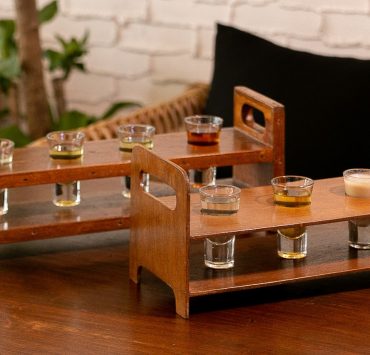
New bar in Eastwood serves shots infused with native plants and fruits
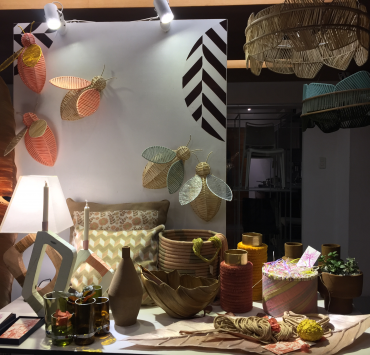
What to expect at the 68th Manila Fame
3 intramuros cafes for your mid-tour breaks.
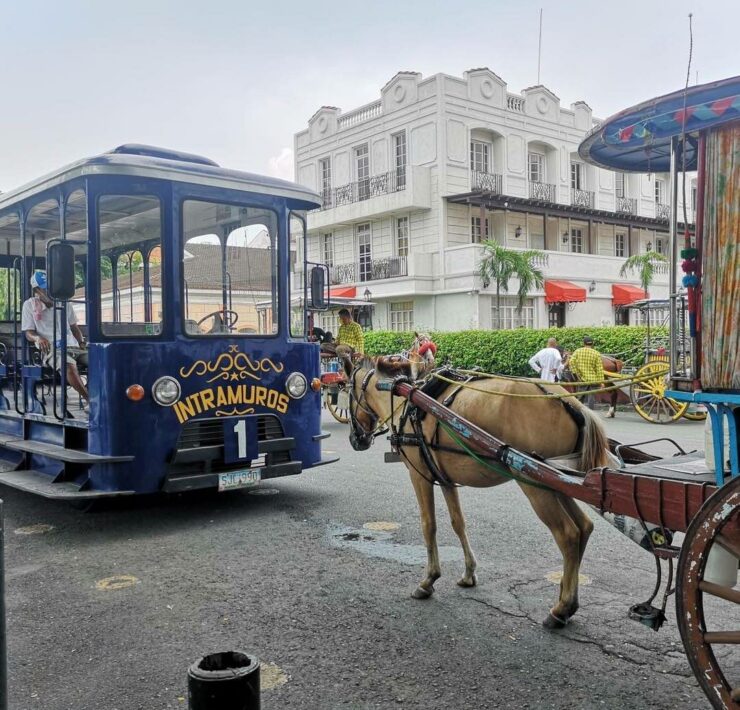
Dust off your ternos and top hats for this costumed tour around Intramuros
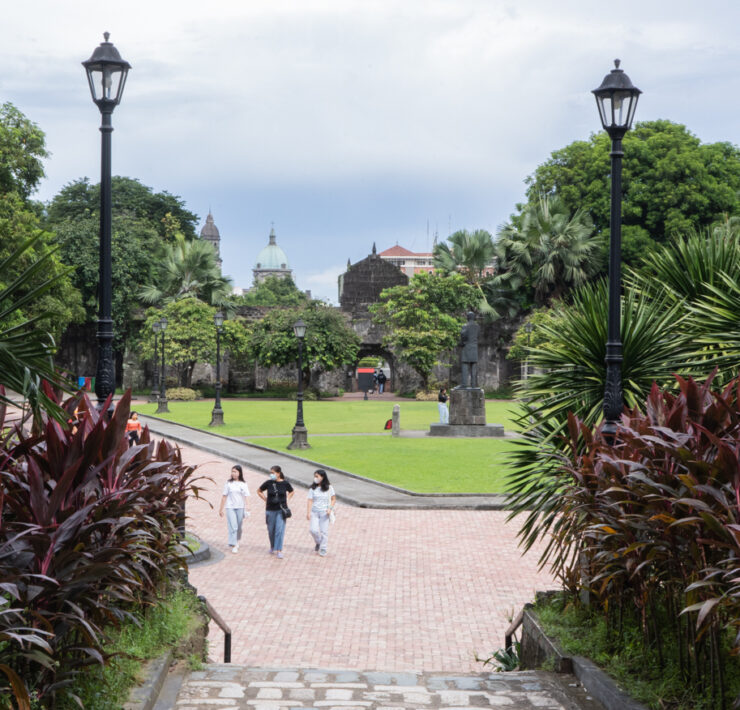
What to do in Intramuros: Ride a bike or go museum hopping—drinking optional
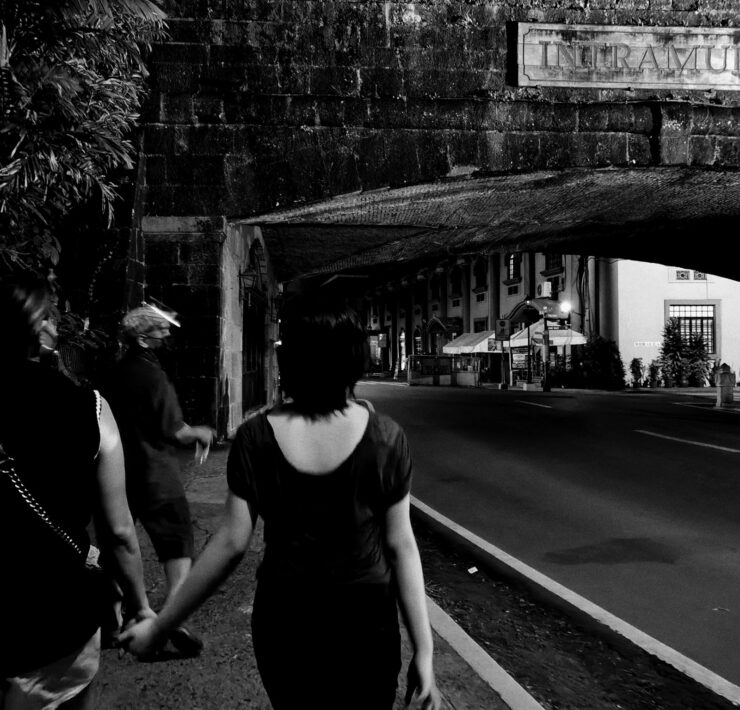
Are there ghosts in Intramuros? Find out for yourself at this night walking tour
- INQUIRER.NET
Nolisoli.ph © 2020. Hinge Inquirer Publications, Inc.
FAQS ✻ SUBMISSION GUIDELINES ✻ LINK POLICY
akun Slot88 slot jackpot terbesar situs slot88 terpercaya Slot Paling Gacor Hari Ini slot pulsa Slot Terbaru Gampang Menang
12 Best INTRAMUROS Tourist Spots (Walled City of Manila)
Manila. There’s no other place in the country as historic and vibrant as this one. The capital city of the Philippines has been through a lot of things during its rich history. Many Filipinos lived and died to protect the freedom of our country and they are the reason why we get to enjoy every bit of beautiful things Manila has to offer.
For many years, Manila has been considered one of the world’s premier destinations given its wide array of attractions, diversity of culture, and richness of history. From a plethora of entertainment hubs to world-class hotels, gigantic malls, museums, and parks, there’s still an important piece of the city’s history that tourists from all over the world love to visit. And that is the famous “Walled City” of Intramuros.
For almost 500 years, Intramuros served as one of Manila’s most important locations. During the Spanish Era, the Walled City became the government’s center of operations, it is where the significant government offices were located and some of them are still standing to this date.
Fast forward to the future, Intramuros is still one of Manila City’s renowned landmarks. I have been to Intramuros many times. When I was still working as a Sales Representative during my stint in a Shipping company, I regularly visited Intramuros as many of my client’s offices are located here.
For many wonderful reasons, Intramuros still and will always be a perfect combination of nostalgia and modernism. So, join me in this article as we discover the 12 best tourist spots in Intramuros!
1. Manila Cathedral
First on the list and certainly one of the most important is no other than the Minor Basilica and Metropolitan Cathedral of the Immaculate Conception also known as the Manila Cathedral.

Credit: Wikimedia Commons
Just like the beautiful city of Manila, Manila Cathedral has also experienced countless wars and catastrophes throughout its entire existence. The church was initially built in 1571, when it was still made of ordinary materials like nipa and bamboo. Moreover, the cathedral also hosted numerous historical events such as the famous Papal Visits of Pope John Paul II in 1981 and Pope Francis in 2015.
Aside from its rich history, the Manila Cathedral is also hailed as one of the country’s top tourist destinations because of its majestic architecture. Designed by the great Architect Fernando H. Ocampo, the breathtaking Neo-Romanesque style of the building easily captures the hearts of tourists. Making the cathedral the perfect spot to appreciate our country’s history and architectural masterpiece. No wonder why Manila Cathedral is also one of the country’s premier wedding venues. So, don’t forget to take pictures during your visit! CHECK THE BEST HOTELS IN INTRAMUROS HERE
2. Fort Santiago
Next up on the list is another significant part of our country’s history, Fort Santiago. It is a citadel built by the Spanish government in 1593. The fortress was designed to protect the then-newly established city of Manila. Many lives were lost and imprisoned in this very fortress and one of those people is the country’s national hero, Dr. Jose Rizal .

Credit: Intramuros Administration FB
Fort Santiago is one of the best places to escape from the hustle and bustle of Manila City. The nostalgic vibe of the fortress together with its beautifully landscaped grounds along the banks of Pasig River makes a perfect relaxing destination for everyone.
READ THE BLOG POST: 15 Best MANILA TOURS in 2023 (Food Tours, Nature & More)
3. Explore Sites with a Bamboo Bike
Intramuros is full of countless historical sites as well as dozens of nostalgic restaurants and cafes offering exceptionally delicious menus. So, it seems unlikely that you’ll be able to fully enjoy everything the Walled City has to offer while riding a car. But don’t worry! You can always opt to tour around Intramuros while riding the famous Bamboo Bikes!
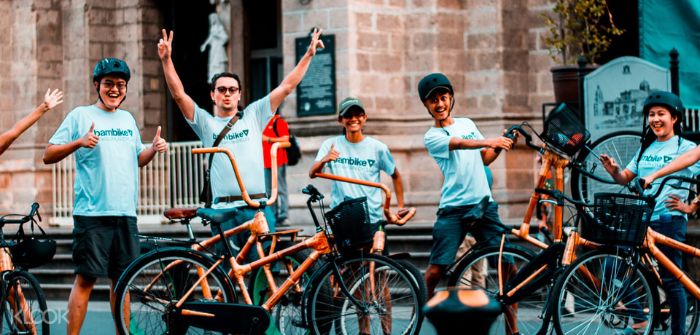
Credit: Klook – BamBike Experience
Bambike Ecotours recently introduced a new and wonderful way to explore Intramuros. For as low as P200 per hour, you can already go on a guided tour around the significant landmarks of the Walled City and you can also choose from several designs of their bikes. Amazing, isn’t it? Make sure to check out the official website of Bambike Ecotours for more information!
4. San Agustin Church
Another important part of our country’s history and religion is the Archdiocesan Shrine of Nuestra Senora de la Consolacion y Correa or widely known as San Agustin Church. To this date, this San Agustin Church is considered to be the country’s oldest stone church, being completed in 1607.

Credit: Wikimedia Commons
The church’s Medieval style in architecture easily captures the hearts of many as it perfectly depicts the classic way of life our ancestors lived. The style and grandeur of the structure itself are already a sight to see for many, but wait until you see the interior! San Agustin Church was built to display the greatness of the Spanish Era that’s why countless elegant features were installed such as chandeliers from Paris, the 18th-century pipe organ, the antechoir, and many more!
San Agustin Church is definitely a must-visit destination in the city and it will always be for many years to come.
5. Baluarte de San Diego
Yet another beautiful historical landmark located in Intramuros is the famous Baluarte de San Diego. It is a bastion, which is a sturdy and strategic structure to repel invasion. The structure is incorporated with several curtain walls so that soldiers will have a clearer view of incoming invaders, giving them much time to counterattack.
Just like all of the surrounding landmarks in Intramuros, many lives were lost and protected in the very location of Baluarte de San Diego. So before you explore its magnificent beauty, don’t forget to pay respects to all the brave souls that once walked around it. CHECK THE BEST HOTELS IN INTRAMUROS HERE
6. Casa Manila
Next on the list is probably one of the most aesthetically pleasing locations you can ever witness in Intramuros. Casa Manila is a popular museum within the Walled City depicting the classy colonial lifestyle of Filipinos during the golden era of the Spanish government.

Credit: Wikimedia Commons
Casa Manila Museum is actually a reproduction of a 19th-century grand mansion that is fully decorated and furnished to perfectly depict what it was like to live as a highly-respected Filipino in the 19th century. As I’ve said, the museum contains a countless collection of several significant pieces of history including antique furniture from China and Europe. Tourists can also witness what typical affluent Filipinos’ houses would look like.
Make the most of this time to take countless Instagrammable photos as much as you can! I’m sure every corner of Casa Manila Museum has a nostalgic vibe to it. So don’t miss the chance to check it out!
7. Museo de Intramuros
Another hidden gem you can find in Intramuros and certainly, one of the new ones is Museo de Intramuros. It is a legacy project created and managed by the Intramuros Administration. The museum contains an extensive collection of religious images and relics which played crucial roles in the evangelization of Filipinos throughout the Spanish colonial era.

Credit: Esquire PH
Museo de Intramuros is built on top of the location of San Ignacio Church Ruins. The majestic design of the museum is based on the original vision of the famous Filipino architect Felix Roxas. As I’ve mentioned, the museum houses an extensive collection of religious items over the almost 500 years Christianity has taken over the country. Spread throughout three (3) stories, you can find religious sculptures, colonial paintings, and historical representations of Intramuros.
Despite its already massive display of collections, officials have said that the Museo de Intramuros only shows 30% of its entire collection. There are still a lot more to come so make sure to support and appreciate our history and culture even more!
8. Silahis Center
It is always a delight for us Filipinos to appreciate art and culture. And one of the best places in our country to do that is no other than Intramuros. The Walled City has been a haven for everyone who wanted to witness massive collections of historical artworks and masterpieces.

Credit: Primer
Silahis Center is the main showroom of Silahis Arts and Artifacts whose main goal is to protect and promote the beautiful heritage of Philippine culture. Countless wonderful Filipino products and handcrafts were manufactured, sold, and retailed by Silahis throughout the years. Enabling them to not only promote the appreciation of our local handicrafts but also create jobs as the Silahis Center also features beautiful indigenous designs from the provinces.
The Silahis Center is divided into four (4) departments where you can witness an extensive display of traditional and cultural artifacts that are also being sold. So aside from being mesmerized by them, you can also opt to buy them as souvenirs! The 4 departments are the Silahis Arts and Artifacts, Chang Rong Antique Gallery, Tradewind Books, and Galleria de Las Alas.
To know more about their interesting collections and displays, just visit the official website of Silahis Arts and Artifacts!
READ THE BLOG POST: 15 Best 5-Star Hotels in Manila (For Luxury Travelers)
9. Barbara’s Heritage Restaurant
Ah, finally! No trip is ever complete without food, am I right? Well, for our next destination, let me introduce you to the famous Barbara’s Heritage Restaurant. Aside from bringing you the best-tasting gastronomic traditional Filipino-Spanish dishes, the restaurant is also known for elevating your dining experience through beautiful cultural music and dance performances!

Barbara’s is located inside the Casa Manila Museum so guests can also explore the beautiful artifacts displayed around. There’s also a separate Attic Museum and Gallery in the restaurant so it’s safe to say that you’ll both be entertained and have your cravings satisfied at the same time!
This hidden gem of a restaurant offers a delicious buffet of Filipino and Spanish foods so I suggest that you make the most out of your experience and taste them all! Barbara’s Heritage Restaurant also serves as a bed and breakfast so for those who want to enjoy a little bit more of Intramuros, you can always book a reservation at the official website of Barbara’s Heritage Restaurant.
10. Light and Sound Museum
Oh, so you thought we’re done exploring the rich and beautiful history of Filipinos? Well, not quite yet because another hidden gem of spectacular displays of culture and history is the Light and Sound Museum.

Credit: Reynelandrozie
One of the museum’s signature shows is the one retracing the footsteps of our very own national hero, Dr. Jose Rizal, towards his heroic demise. In the Light and Sound Museum, visitors are guaranteed to experience a recreation history with the masterful touch of light and sound. Feel free to be mesmerized with tons of artwork, visuals, and sounds for as low as P150 per hour! Not bad, right?
11. Bahay Tsinoy
Of course, Intramuros isn’t all about the contributions of the Spanish Colonial Era in our country. It has been standing for almost 500 years now so it’s safe to say that it came across other countries too like the Europeans, other Asian countries, and most importantly, China. China has been a massive influence on our country whether we talk about culture, economy, and history.

Credit: MoleInTheFoot
Bahay Tsinoy has long been a museum in Manila that houses several collections of the different contributions of the Chinese in our history, culture, tradition, and economy. It houses the recognized Kaisa-Angelo King Heritage Center which is responsible for collecting such important artifacts of our culture.
You can always come and appreciate these beautiful pieces of history in Intramuros so go ahead and check them out!
READ MORE : 15 Best Hostels in Manila
12. Aduana Ruins
Lastly, we have the beautiful Ruins of the Aduana Building. This Spanish colonial structure is also known as the Aduana de Manila or Intendencia. For centuries, this establishment housed several important government offices that played a huge role in our ancestors’ lives.

Credit: Ae goes around
To this day, the Aduana Ruins has become a popular tourist destination for its exceptionally beautiful design following a Neo-Classical touch of architecture. The appearance of the structure itself is already an attraction, but if you incorporate its historical significance, visiting the Aduana Ruins can always have a deeper meaning for some.
Intramuros has and always will be a massive part of our lives as Filipinos. It’s sort of a time capsule that enables us to go back to the past and have a look at how beautiful yet challenging life was back then. All of these while still being able to enjoy the present and appreciate the improvements taking place in our country.
Most of all, Intramuros serves as an ultimate reminder to everyone that the freedom we enjoy in the present came with a massive price. We should do our very best to appreciate it, protect it, and love it.
Intramuros Travel Guide 2024
How to get to intramuros.
Getting to Intramuros, the historic walled city in Manila, is easy with different transportation options. Here’s how you can get there:
By LRT 1 (Light Rail Transit)
- Fastest : Take the LRT 1 train and get off at Central Station. Then, just walk towards the entrance of Intramuros on Victoria Street, across from Manila City Hall. Intramuros is close to landmarks like the National Museum of the Philippines, Rizal Park, and the Manila Hotel.
- From Cubao : Take the LRT 2 at Cubao Araneta Station towards Recto Station. Get off at Recto Station and walk to Doroteo Jose Station LRT 1. Take the train bound for Baclaran and get off at Central Terminal. Walk towards Manila City Hall and use the underpass in front of the building to reach Intramuros.
- From SM City North EDSA : Ride a Jeepney or bus towards Balintawak and get off at Roosevelt LRT 1 Station. Take the LRT 1 train bound for Baclaran and get off at Central Station. Walk towards Manila City Hall, cross Taft Avenue using the underpass, and reach Padre Burgos Avenue, which leads to Intramuros.
By Jeepney
- From Monumento, Caloocan: Take the LRT 1 at Monumento Station and get off at Central Station. Walk towards Liwasang Bonifacio or Manila City Hall, cross Taft Avenue using the underpass, and follow Padre Burgos Avenue to reach the east side entrance of Intramuros.
- Take a Jeepney with a sign for Baclaran or Gil Puyat. Let the driver know you’re going to Intramuros. Usually, they’ll drop you off at the center island of the Manila City Hall underpass. From there, take the underpass to cross Taft Avenue and reach Padre Burgos Avenue. Follow C. Victoria Street to the east side entrance of Intramuros.
Of course, for faster travel time, you can always take a taxi, Grab, Joyride , Move It , Angkas or any ride-hailing app going straight to Intramuros.
More Manila Blog Posts:
- Best Staycations in Manila
- The woman I met at a Manila Park
- PITX to Lawton, Manila (Guide, Tips & More)
- Quiapo Church Mass Schedule
- MRT Schedule and Stations

previous
PURPLE OVEN MENU & Delivery 2024 (Freshly Baked, Flavorful Goodness)

newer
Supercat: CEBU TO ORMOC 2024 (v.v. Schedule, Fare & More)
You might also like.

MALACAÑANG OF THE NORTH: Tracing History in Ilocos Norte

Clark Pampanga Tourist Spots and Attractions

Kawit Cavite Heritage Tour and Attractions
Leave a reply cancel reply, privacy overview.
Intramuros Travel Guide for Kids
- May 7, 2019
Intramuros is a must visit place to learn and experience Philippine History. This Intramuros travel guide will help you navigate the streets of the 64-hectare walled city with historical sites, churches, monuments, and museums. It’s a travel guide for kids (and the kids at heart too!). Most, if not all, of the attractions have free admission fee.
Download and print this Intramuros Map so you can plan your tour easily. This is a map from the Intramuros Admin page. We added some labels of the sites we are interested to visit.

You can tour Intramuros in several ways.
1. Walking. No cost. Just be prepared with sunblock, umbrella and your drink. You can check our DIY Intramuros Walking Tour here.
2. Biking. There are bamboo bikes for rent. You can rent a bike for an hour or 2 for a DIY Intramuros Tour (Php 100/hour). They also offer a guided tour on bikes, cost ranges from Php 600- 1000, depending on the kind of tour.
3. Riding a kalesa (horse-drawn carriage). Riding a kalesa is quite an experience. Kalesa Tours in Intramuros offers a ride for Php 1000 per kalesa, per hour. Kalesa can accommodate up to 6 persons.
4. Riding a pedicab. The tour costs Php 350 per person for 30 minutes.
5. Riding an e-Trike. E-trike cost Php 25/ person/ ride. They also offer a group tour for Php 800/ hour per E-trike. The E-Trike can accommodate about 8 persons.
A day in a walled city may not be enough to cover all areas so check the attractions you want to prioritize. You can always come back another day and explore more.
View this post on Instagram Magandang araw! Intramuros walking tour video is up! . Check the full video in Gab Academy in YouTube. Make sure to see the post-credits! ? . #travel #travelph #exploringtheworld #forthegram #travelphotos #worldschooling #travel #travelph #travelphotographer #homeschool #homeschooling #homeeducation #homeed #travelschooling #worldschooling #theworldisourclassroom #intramuros #history #philippinehistory #fortsantiago #manila #philippines #lifewelltraveled #lifewelltravelled A post shared by The Filipino Homeschooler (@thefilipinohomeschooler) on May 6, 2019 at 7:02pm PDT

Historical Sites, Plaza, Puerta, Baluarte, Ruins
- Fort Santiago (Schedule: Open daily | Entrance: Php 75/ Php 50)
- Palacio Del Gobernador
- Ayuntamiento
- Aduana/ Intendencia
- Baluarte de San Diego (Schedule: Open daily | Entrance: Php 75/ Php 50)
- Baluarte de San Andres
- Baluarte De Dilao
- Baluartillo De San Jose
- Plazuela De Santa Isabel
- Plaza Espana
- Plaza Mexico
- Puerta Real & Revellin Real De Bagumbayan
- Puerta De Santa Lucia
- Puerta Del Parian & Revellin Del Parian (Schedule: Open daily | Entrance: Php 75/ Php 50)
- Maestra Curtail Wall and Plaza
- Cuartel De Santa Lucia
- Reducto De San Pedro
Churches/Museums
- San Agustin Church & Museum
- (Schedule: Open daily (8am-12nn, 1-6pm) | Entrance: Php 200/ Php 160)
- Manila Cathedral
- Casa Manila (Schedule: Open daily (9am-6pm) | Entrance: Php 75/ Php 50)
- Bahay Tsinoy (Schedule: Tue-Sun (1pm-5pm) | Entrance: Php 100/ Php 80/ Php 60)
- Rizal Shrine
- Bagumbayan Light & Sound Museum (Schedule: Open daily | Entrance: Php 150/ Php 120)
- Destileria Limtuaco Museum (Schedule: Tue-Sun (1pm-6pm) | Entrance: Php 100/ Php 50)
- Museo De Intramuros
Leave a Reply Cancel reply
Your email address will not be published. Required fields are marked *
This site uses Akismet to reduce spam. Learn how your comment data is processed .
Related Articles

Cinco De Noviembre History through Terracotta Art
- November 24, 2023

Gab Takes A High School Entrance Exam
- November 13, 2023

How to make Hand Shadow Puppets
- November 2, 2022

Intramuros: Travel Guide to the Historical Walled City of Manila
by Leslie | Dec 16, 2020 | Blog
Get a sense of what the old Manila was like during the Spanish colonial era – witness timeless beauty with its cobblestone streets, well-preserved Spanish colonial architecture, rustic mansions, Baroque churches and horse-drawn carriages (calesa). You’ll also be delighted to meet security personnel dressed like Guardia Civils (Spanish-era civil guards) in many parts of Intramuros.

2020’s World’s Leading Tourist Attraction | Source: DOT
Intramuros, Philippines: World’s Leading Tourist Attraction
Intramuros has quickly emerged as one of the top tourist attractions not only in the Philippines but of the world.
Declared as this year’s “ World’s Leading Tourist Attraction ”, Intramuros bested 15 other world-renowned attractions including the Great Wall of China, Taj Mahal of India, Acropolis of Greece, Machu Picchu of Peru and Burj Khalifa of Dubai among others.
Moreover, the Philippines was also recognized as the World’s Leading Dive Destination in the recently concluded 27th World Travel Awards.

Baluarte de San Diego in Intramuros | Photo by: imwaltersy | Shutterstock Photo ID: 1803568756
Intramuros Location
It is located in the bustling city of Metro Manila. It sits beside the national landmark, Rizal Park or Luneta Park and is just a few blocks away from the National Museum of the Philippines.
This historical site also puts you at the center of places like hotels, shopping malls, restaurants, religious sites and prominent schools in the country.
Intramuros Manila Map

From daytime to night-time, Intramuros offers classic charm which evokes feelings of patriotic admiration. You have 3 ways to tour the area:
Walking Tour
A walking tour can be self-organized or a guided tour.
Bamboo Bike Tour
Go on a historical, ecological and one-of-a-kind bamboo bike (also known as “bambike”) tour where you will be accompanied by a local guide to pedal and tour around its cobblestone streets.

Bamboo Bikes | Photo by: imwaltersy | Shutterstock Photo ID: 1387314050
Intramuros Night Tour
When the sun is gone, Intramuros transforms into a whole new dimension as lights illuminate old streets and structures creating a fancy, European, romantic vibe all over the place.
Intramuros Entrance Fee
There is no entrance fee to enter Intramuros, however, the sites found inside like the Fort Santiago, Casa Manila, Rizal Shrine, etc, charge a minimal entrance fee of Php 50 (child) to Php 75 (adult).
Intramuros Opening Hours
Intramuros is open from 8:00 AM to 11:00 PM. Although some sites like museums are only open at certain hours.
Intramuros Tour Guide
It is possible to tour the area on your own, however, it’s always a better tour experience when accompanied by a tour guide. In case you need one, then don’t hesitate to get in touch with us.
The bits and pieces of what you will see will become more meaningful when you have a knowledgeable tour guide narrating its story.
Attractions in Intramuros and Tourist Spots
There are many historical sites to see inside the walled city which are managed by Intramuros Administration (IA) . Pace, time and choices of sites to visit are of course flexible and according to your liking. Here is a guide list to some of its most famous sites:
Fort Santiago
It is one of the oldest and most fortresses in the country and was declared as a National Historical Landmark in 1951.

The main gate of Fort Santiago in Intramuros | Photo: Jorge Láscar | License: CC BY 2.0 | short
Rizal Shrine
It is a museum to honor the life of the great national hero, Dr. Jose P. Rizal. The museum stands at the exact location where Rizal spent his final moments before he was executed on December 30, 1896 at the nearby Luneta Park.
Church of San Agustin
San Agustin Church is a UNESCO World Heritage Site. This Spanish Baroque-style church is the oldest standing stone church in the country which was completed in 1607.
It is noteworthy that the first Spanish Governor-General of the Philippines Miguel López de Legazpi was actually buried in this church.

Church of San Agustin | Photo: Jun Acullador | License: CC BY-ND 2.0 | short
Manila Cathedral
The Manila Cathedral is the first cathedral in the Philippines.
It is the only one elevated to the rank of a Basilica by the Pope’s own initiative. His Holiness, Pope John Paul II, now a canonized Saint, raised the Manila Cathedral to the dignity of a Basilica (motu proprio) on April 27, 1981. As the Premier Church, Premier Cathedral and Premier Basilica, the Manila Cathedral-Basilica is the “Mother of all Churches, Cathedrals and Basilicas in the Philippines”.

The Manila Cathedral | Photo: Jorge Láscar | License: CC BY 2.0 | short
Museo de Intramuros
Museo de Intramuros exhibits treasured antiques and artifacts that pays homage to the story of evangelization in the Philippines from the perspective of Filipinos.
Casa Manila Museum
Casa Manila or Manila House is a lifestyle museum that offers glimpses of the life of upper class families (known as Ilustrados) who once lived there during the Spanish era. Discover aesthetic heritage through house decors, furnitures, artworks and artifacts found at the Casa.

Casa Manila Museum | Photo: Roberto Verzo | License: CC BY 2.0 | short
These are just a few of the important sights found at Intramuros.
There’s a lot more to explore. For instance, Palacio del Gobernador, Ayuntamiento de Manila, Bahay Tsinoy, Plaza Roma, Baluarte de San Diego and more.
Restaurants Intramuros
Barbara’s heritage restaurant.
Barbara’s is Spanish-Filipino inspired restaurant that serves lunch and dinner buffets with a 45-minute Cultural Show at night time. There’s no better place to dine than at Barbara’s. It is a must-try experience while at the walled city.
It is a premier restaurant located at the rooftop of Bayleaf Hotel which offers an unobstructed, 360-degree view of the city including the famous Manila sunset.
Hotel Near Intramuros
The bayleaf intramuros.
Bayleaf is conveniently located at the heart of the walled city of Intramuros. Its ideal location allows you easy access to the iconic site. They offer tastefully designed rooms and first-class restaurants, including the Sky Deck.
Rizal Park Hotel Manila
Considered as one of the most iconic boutique hotels in the country, Rizal Park Hotel’ s interiors and architecture are impressive, allowing you to fully immerse in the Filipino-colonial ambience.
Looking for an Intramuros Manila Tour?
Intramuros is a treasured attraction you certainly would want to include in your itinerary. This tour can be easily integrated in your Manila Tour and is available all year round.

Tour using a horse-drawn carriage (also known as Calesa)
If you like, we can customize an authentic Intramuros Tour or Manila Tour for you. Feel free to contact us or leave us a comment and we will be delighted to pick up your inquiry/request.
Go on a nostalgia trip and discover the “walled city” of Intramuros – the World’s Leading Tourist Attraction.
Another excellent destination for a historical tour is Cebu City. Find out more on this blog .
Philippines’ Leading Tour Operator Nominee

Recent Posts
- İddaa Spor Toto TJK At Yarışı
- Pin Upward Turkey Online On Line Casino Resmi Sitesi Giriş Ve Kayı
- Bets10 mobil indir Türkiye Bets10 apk iOS ve Android
Recent Comments
- bong on Whale Shark Philippines | Why Choose Donsol Over Oslob
- whoiscall on Devie’s Top 10 Hidden Gems in the Philippines
- Jm on Christmas in the Philippines: 10 Unique Filipino Christmas Traditions
- Anik sarma on Rice Cooker Recipes: Easy Quarantine Cooking
- Ian on Rice Cooker Recipes: Easy Quarantine Cooking


A Comprehensive Intramuros Travel Guide – Explore The History of The Past
Intramuros stands as a living testament to the country’s rich history and cultural heritage. This walled city, literally translating to “within the walls,” holds within its ancient fortifications a trove of historical landmarks, picturesque cobblestone streets, and immersive experiences. In this comprehensive travel guide, we will delve into the history of Intramuros, provide directions on how to get there, and highlight the must-visit places and activities that make exploring this historic enclave an unforgettable journey.
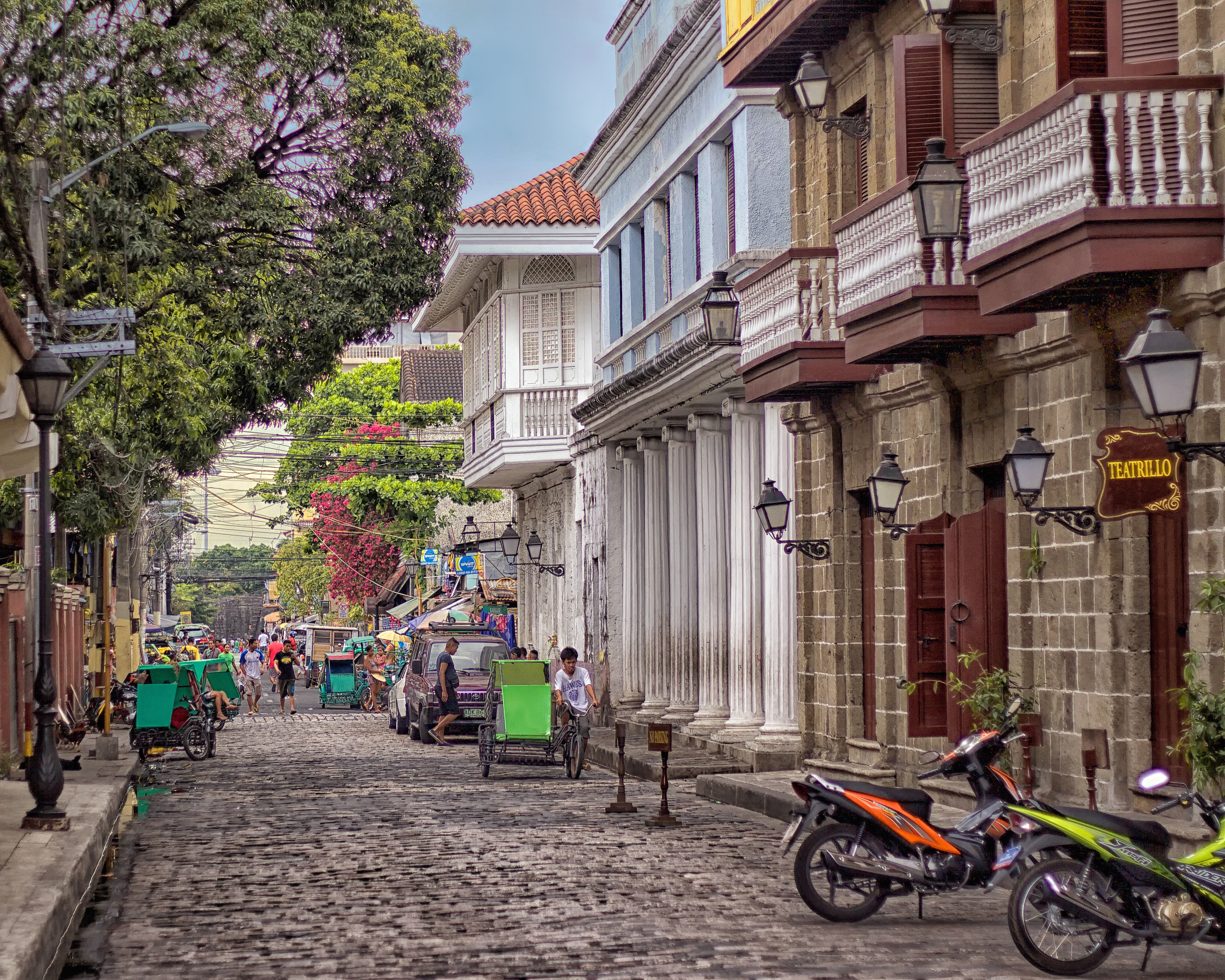
Table of Contents
History of Intramuros
This place is also known as the “City Within Walls,” was built by the Spanish colonial government in the late 16th century. Construction began in 1571 under the supervision of Miguel Lopez de Legazpi, the first Governor-General of the Philippines. The purpose of building Intramuros was to protect the newly established city of Manila from foreign invasions.
Throughout its history, It witnessed colonial rule, wars, and occupation. The city served as the center of political, religious, and economic activities during the Spanish colonial period. However, during World War II, Intramuros suffered severe damage, with many of its historical structures destroyed. In recent decades, concerted efforts have been made to restore and preserve its cultural heritage, allowing visitors to step back in time and explore its storied past.
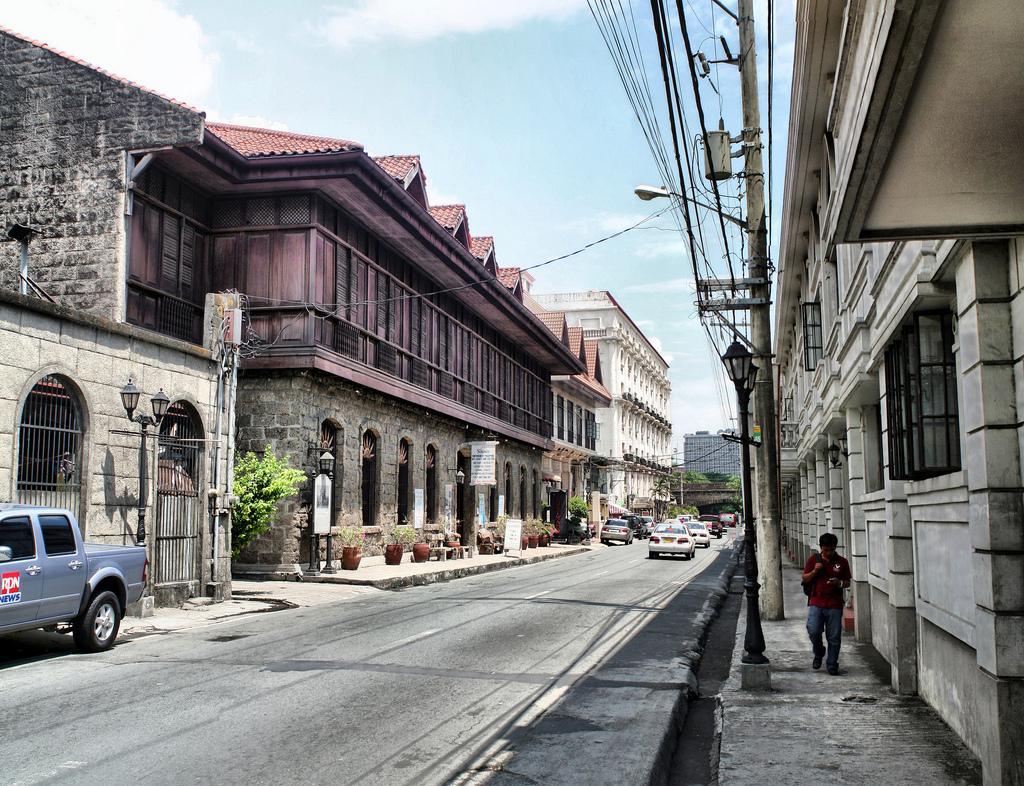
How to Get There
Intramuros is conveniently located in the heart of Manila, making it accessible for both locals and tourists. The Ninoy Aquino International Airport serves as the main gateway to Manila. From the airport, visitors can take a taxi or use rideshare services to reach Intramuros.
Public transportation, such as the LRT-1 and LRT-2 train lines, also provides easy access to Intramuros. Alight at the Central Terminal Station, and from there, it’s a short walk or a quick ride to the walled city. For those exploring Manila by car, several parking facilities are available near the entrances to Intramuros.
Places to Visit in Intramuros:
1. Fort Santiago: A citadel within Intramuros, Fort Santiago is an iconic historical site that played a crucial role during the Spanish colonial period. Visitors can explore its dungeons, walk along the walls, and appreciate the views of the Pasig River.
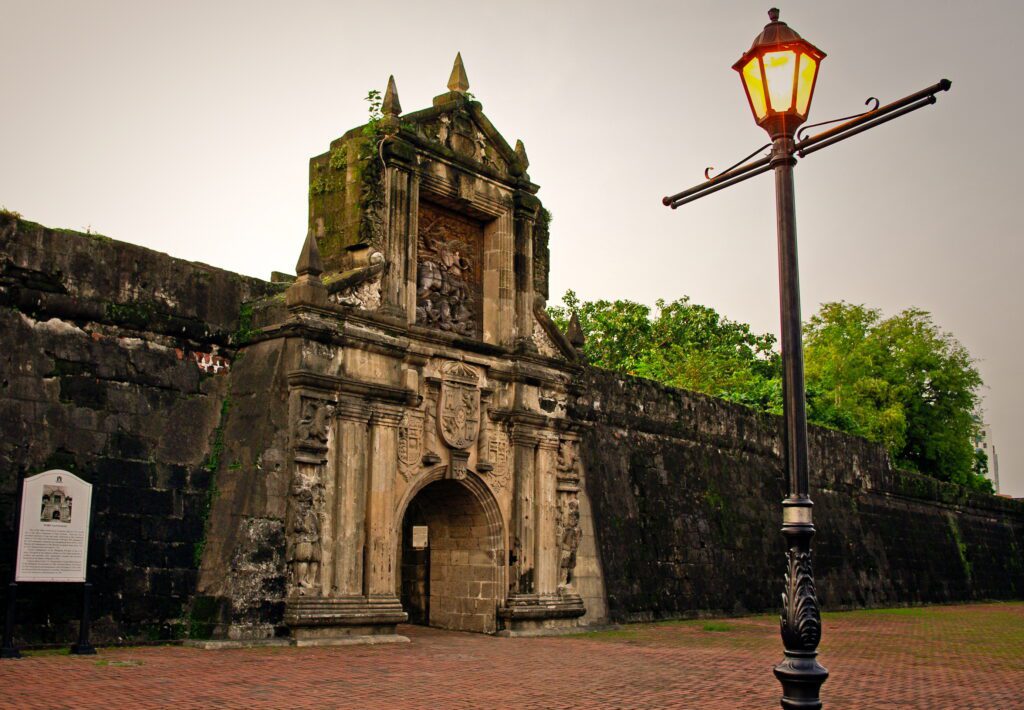
2. San Agustin Church: A UNESCO World Heritage Site , San Agustin Church is the oldest stone church in the Philippines. The church’s stunning architecture and rich history make it a must-visit destination within Intramuros.
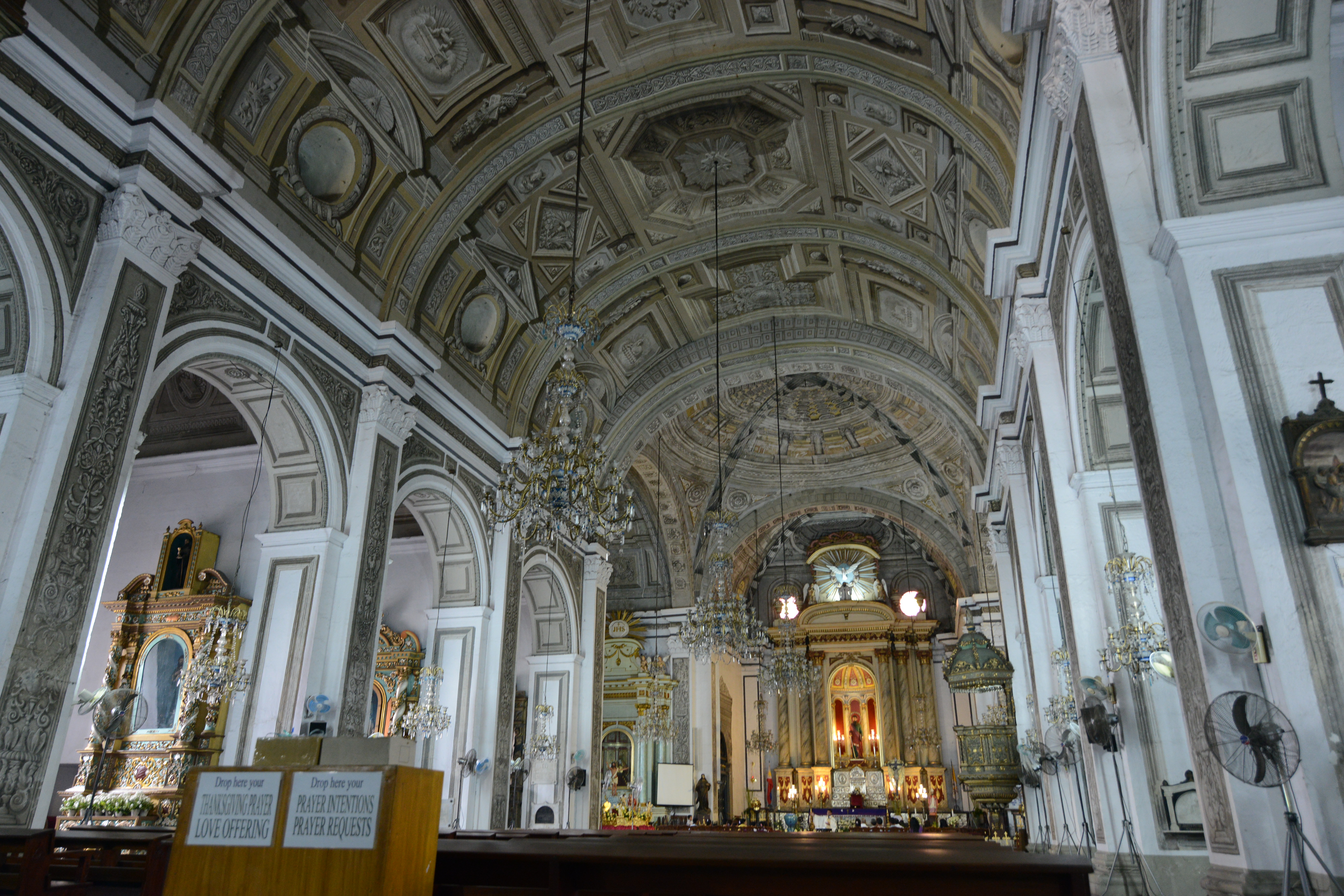
3. Manila Cathedral: Located just a stone’s throw away from Fort Santiago, the Manila Cathedral is another significant religious site. Its grand design and intricate details make it a captivating stop for history and architecture enthusiasts.
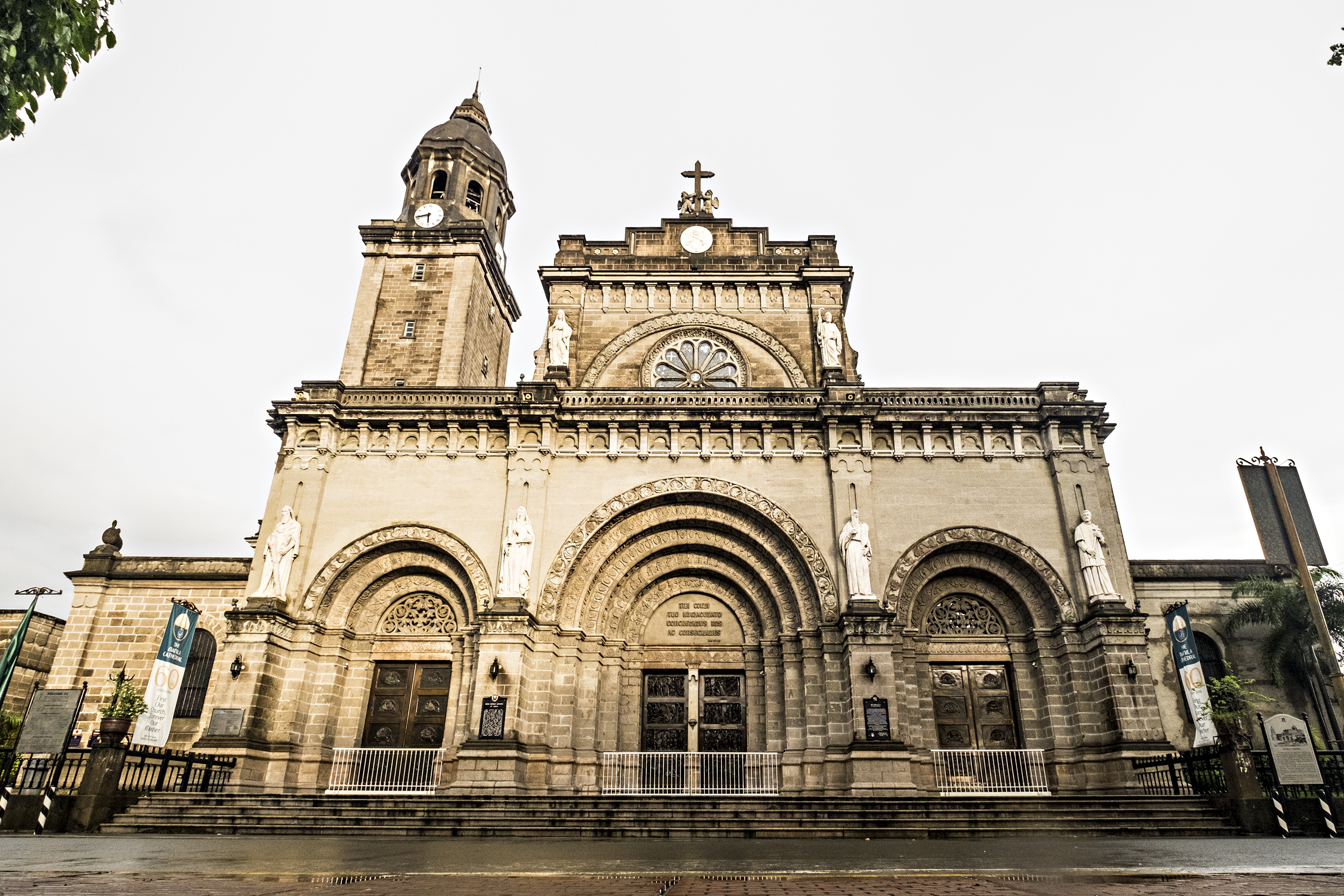
4. Baluarte de San Diego: This well-preserved bastion showcases the military architecture of Intramuros. Visitors can explore its ramparts and enjoy a panoramic view of the surrounding area.
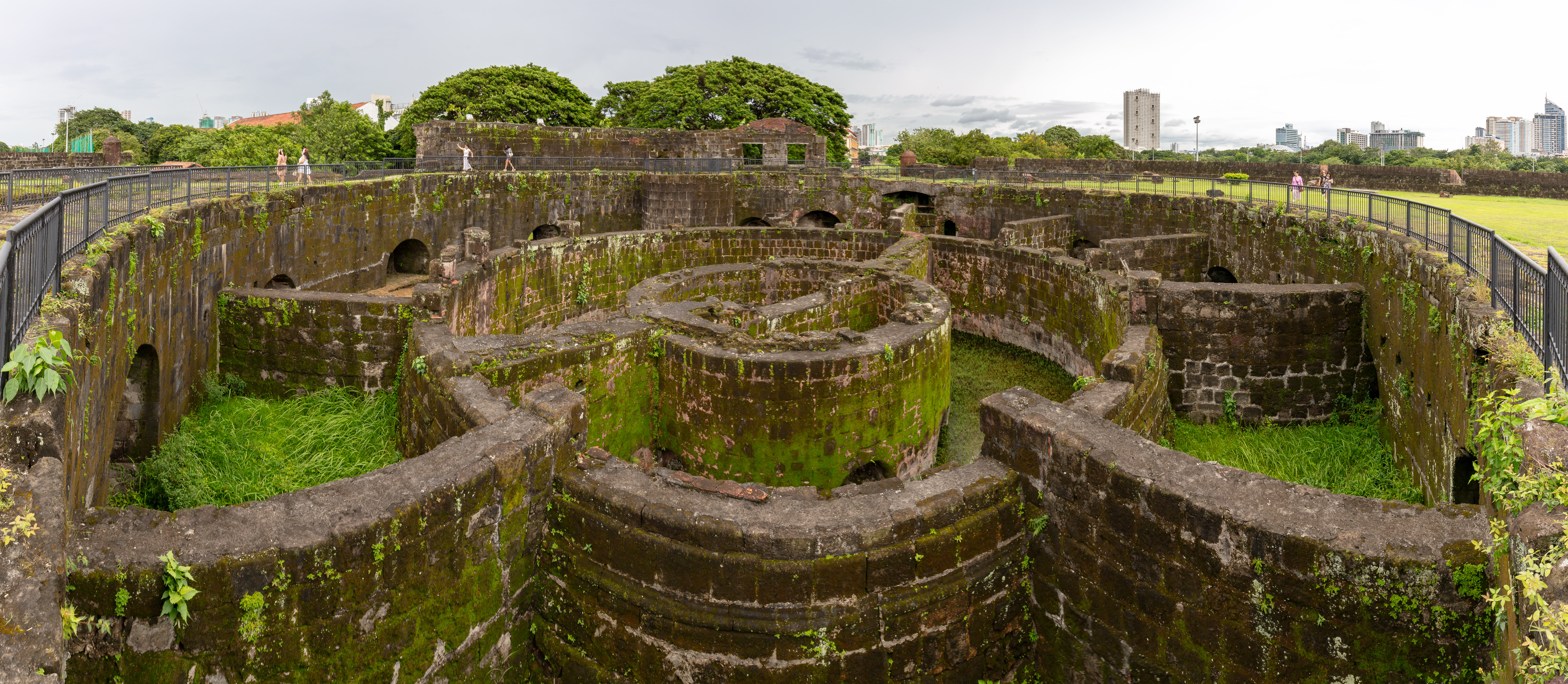
5. Plaza de Roma: Located in front of the Manila Cathedral, Plaza de Roma is a historic square surrounded by important structures like the Ayuntamiento and the Palacio del Gobernador. The plaza serves as a central gathering point and a scenic spot for taking in the ambiance of Intramuros.
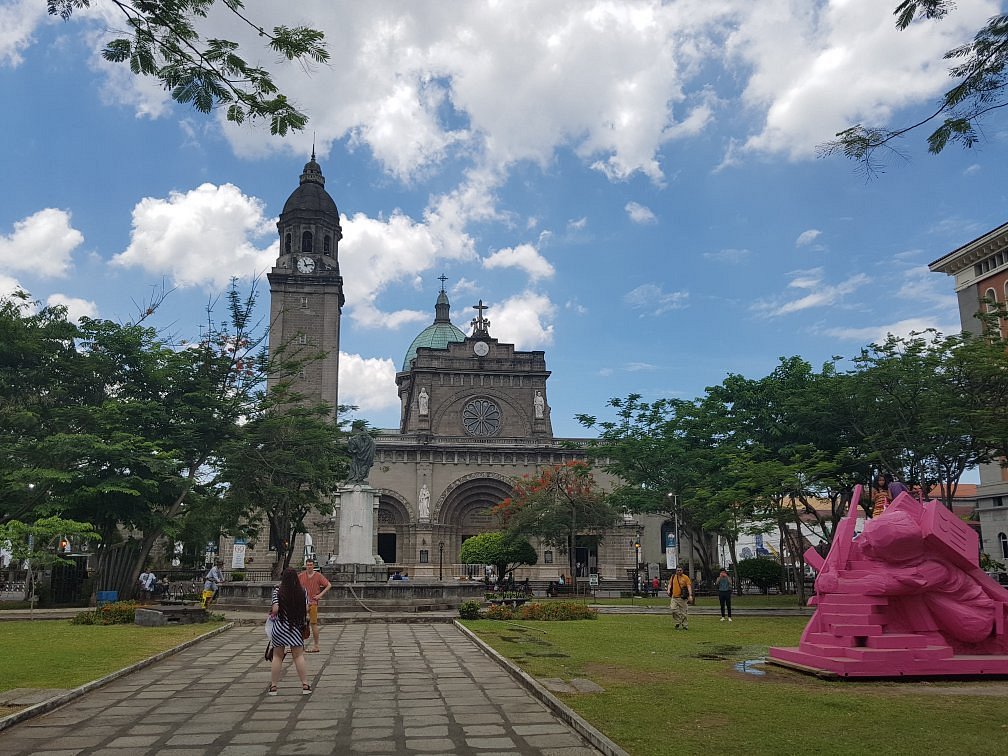
6. Casa Manila: Modeled after colonial houses during the Spanish era, Casa Manila provides a glimpse into the lifestyle of the Filipino elite during the 19th century. The museum features well-preserved furniture, art, and décor, offering a fascinating journey into the past.
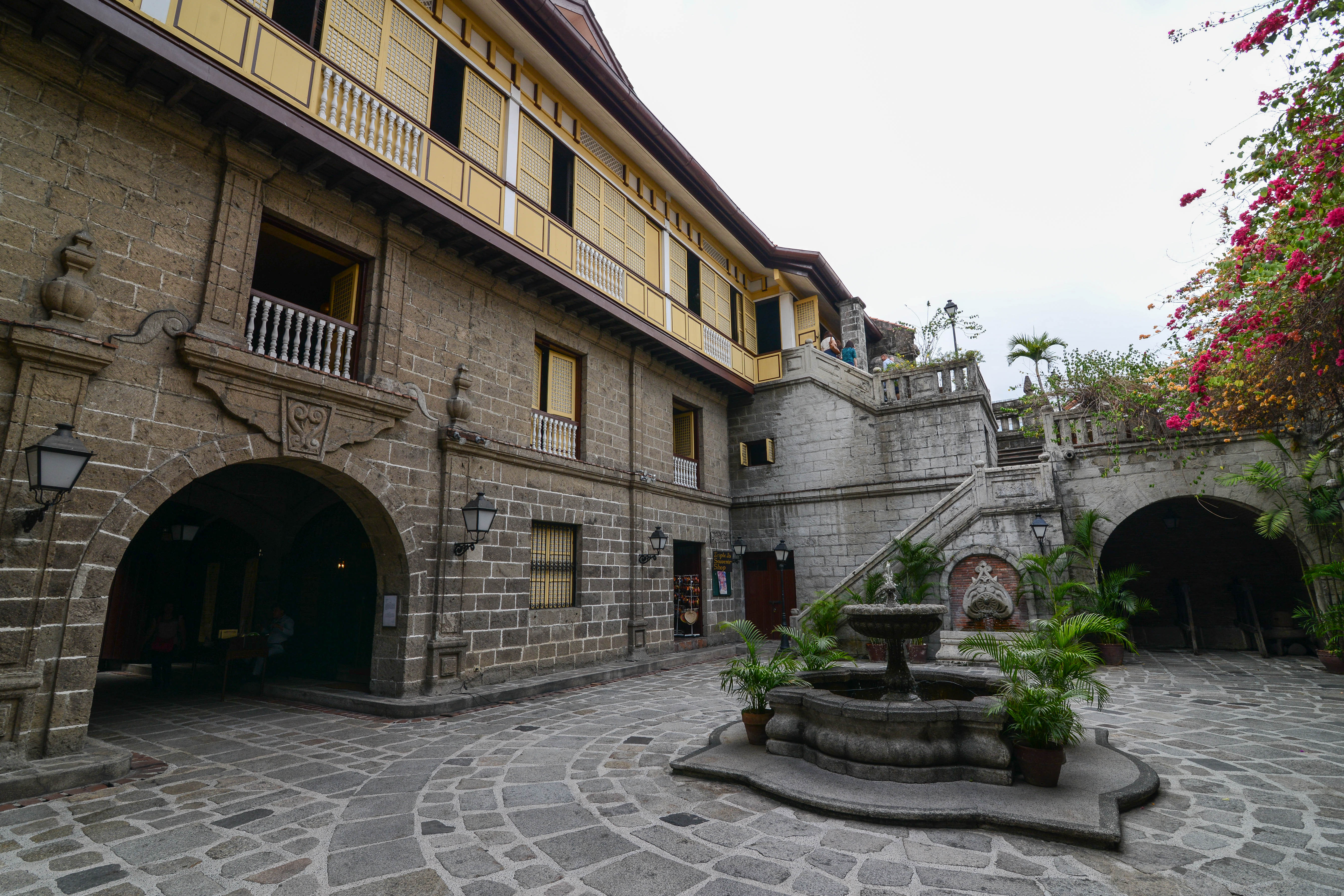
Things to Do There:
- Guided Walking Tours: To fully appreciate the historical significance of Intramuros, consider joining a guided walking tour. Knowledgeable guides provide insights into the city’s history, architecture, and cultural heritage.
- Horse-drawn Carriage (Kalesa) Rides: Experience the charm of Intramuros by taking a leisurely kalesa ride through its cobblestone streets. It’s a nostalgic way to explore the walled city and its historic landmarks.
- Visit the Rizal Shrine: Located within Fort Santiago, the Rizal Shrine is dedicated to the national hero, Dr. Jose Rizal. Explore the museum and gain insights into Rizal’s life and the role he played in Philippine history.
- Enjoy Local Cuisine: Intramuros offers a variety of dining options, ranging from quaint cafes to restaurants serving Filipino and international cuisine. Take a break from exploring and savor the flavors of the Philippines.
This place stands as a captivating blend of history, culture, and architecture, inviting visitors to step back in time and immerse themselves in the rich tapestry of the Philippines’ past. Whether you’re a history enthusiast, a cultural explorer, or someone seeking a unique travel experience, Intramuros has something to offer. From the imposing Fort Santiago to the serene courtyards of San Agustin Church, the walled city is a treasure trove waiting to be discovered by those eager to unravel the stories woven into its ancient walls. Plan your visit to Intramuros and embark on a journey through time in this remarkable destination.
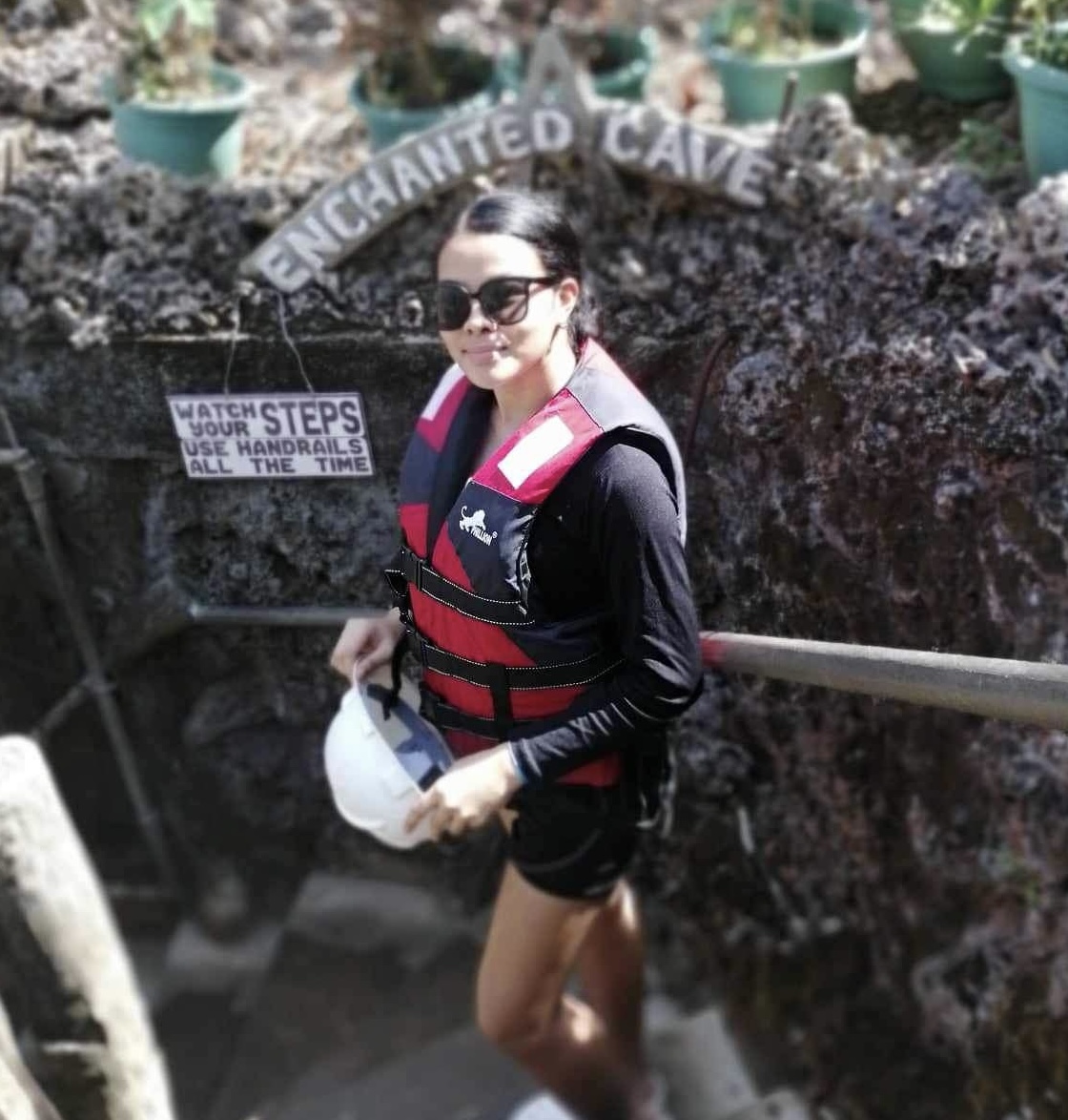
I’m Ken, an avid travel blogger and a nurse chronicling my adventures on “The Sneaky Traveller.” My journey in healthcare and travel enthusiast is driven by a desire to make a meaningful impact in both realms.
Leave a Comment Cancel Reply
Your email address will not be published. Required fields are marked *
Save my name, email, and website in this browser for the next time I comment.

Lucid Horizon
Adventure and Travel Blog
Fresh Buzzworthy Content!

Discovering Bana’s Coffee Shop in Sagada: A Must-Try for Coffee Lovers

Experiencing Sagada’s Honesty Wine Bar: A Refreshing Breath of Humanity

Breakfast at IsangWow Cafe by the Clouds, Sagada

Escape to Serenity: A Staycation at Zabin Pines Resort

Mt. Pinatubo: An Unforgettable Trek Through Nature’s Masterpiece

TOPS Lookout in Cebu: Where the Sky Meets the City
- National Capital Region - NCR
Time to Explore the Old Manila – INTRAMUROS DIY Tour

Intramuros: Where To Go And What To Do In Old Manila
We have been working in Manila ever since we graduated from college. Even so, we never really got the chance to explore what is known to be the home to the city’s historical landmarks built during the Spanish era. Guilty as charged, we didn’t find time to do so… not UNTIL NOW!
Intramuros is the Latin word that means “inside the walls” thus, calling it the “ Walled City ” located in the city of Manila, the capital of the Philippines. This was built in the late 16th century to protect the city from foreign invasions. This is a great place to revisit Manila’s rich history and see centuries-old establishments.
If you are looking for an Intramuros day trip itinerary, we got you covered. I’ll be sharing with you how we explored this place and how much we spent.
Intramuros Itinerary
How to go to intramuros.
Take the LRT-1 going to Central Terminal Station. From here you have 3 Options:
- Walk five minutes to Manila City Hall. From here, a pedestrian underpass takes you across Padre de Burgos Street. Immediately upon exiting the underpass, you’ll see Victoria Street, which curves right through the walls. ( Pros : cheaper way – Cons : can really be hot during day time and it will take you 10-15 minutes)
- Hail a Taxi – Outside the station, you can take a taxi. It should not cost you more than Php 200. Before going inside a taxi make sure you make it clear to the driver that you want the metered price otherwise there’s a possibility they will overcharge you especially if you are a foreigner.
- Take a Grab – Download the GRAB APP then book your ride to Intramuros. We tried booking a grab from Central Terminal Station going to San Agustin Church in Intramuros and the price is Php 178.
- Pedicabs – This is the option we took. They are bicycles with side compartments or motorized rickshaws. Similar to Thailand’s Tuk-tuk. Each trip costs about 50 Philippine pesos. (negotiable).
How to tour around Intramuros?
Information on the internet can be overwhelming. Before going, we really don’t know where to start. We didn’t have a final itinerary when we got there. I asked the pedicab driver to drop us off at San Agustin Church because I thought that was the best way to start. Here are the available options by the way.
- Ride from one historical monument to another on the Electric Chariot with your knowledgeable tour guide. The Budget Tour (30 minutes) costs Php 300 and the Grand Intramuros Tour (1 hour) costs Php 900.
2. Hop on a bamboo bike – Bambike . A guided tour costs Php 999. You can also rent a bike on-site for Php 200 per hour. They are located in Casa Manila just in front of San Agustin Church.
3. Calesa is a great way to experience touring in a horse-drawn carriage. Calesa accommodates 1 to 3 passengers on a 30-minute guided tour of Intramuros. The cost is Php 1,000. If you will take this option, you need to go to Manila Cathedral first. That is where you can find rental Calesa.
4 Pedicabs offers guided tours as well. It costs Php 350 for 30 minutes tour, for locals it’s Php 150 per 30 minutes. They have this laminated white paper where they have pictures of the historical places they will tour you. If you will take this option you can find them outside Manila Cathedral, San Agustin Church, or Fort Santiago.
12:30PM – San Agustin Church
We explore Intramuros’ DIY style. When we got out of Central LRT station, the original plan was to walk going to Intramuros but it was 12 noon that time. The sun is up and it’s so humid that’s why we tried to check how much will it cost us to book a grab – and it costs Php 178. We tried to look for a taxi but there were others who were in line waiting. Finally, we decided to take a pedicab. At first, they were charging us more than the price if we took a grab so we declined. They are very persistent and a little scary honestly. But when we said we would just take a grab one of them lowered it to Php 50.
San Agustin Church is the oldest stone church in the country. This church survived wars and natural calamities before it was hailed as a UNESCO World Heritage Site. It has a museum inside with its precious collection of Spanish artifacts, statues, church ornaments, and paintings. They are open from Wednesday to Sunday, from 8 a.m. to 12 p.m. and from 1 p.m. to 6 p.m.

01:00 PM – Casa Manila
Just in front of San Agustin Church is the Casa Manila or “ Manila House ”. It is a living museum that features the lifestyle of an affluent Filipino family during the late Spanish colonial period.
The first thing we noticed is the Bambike rental headquarters outside Casa Manila.

On the other side of it is Barbara’s Heritage Restaurant.

As we walked inside, we saw souvenir shops, a cafe, and another restaurant. There is a passage on the left side that leads us to this fountain. The entrance fee to Casa Manila Museum is PHP 75 . They are open from Tuesday to Sunday only. Operating Hours are from 09:00 am – 06:00 pm.

01:30 PM – Baluarte de San Diego
From Casa Manila, we took a pedicab going to Baluarte de San Diego. The fare is Php 50 each. Then, we paid the entrance fee which costs Php 75 each.
The Baluarte de San Diego also known as Nuestra Señora de Guia (Our Guidance Lady) is one of the oldest forts inside Intramuros. This spade-shaped bulwark which used to be a circular watch tower was built in the late 16th century primarily to defend against the invasion of this area.

Today, the fort has become a popular tourist spot. They built a garden around the fort that features shaded walkways, fountains, old cannons, and structures from the preceding century.

02:00 PM – Fort Santiago
We took another pedicab outside Baluarte de San Diego going to Fort Santiago. The fare is Php 50 each. Then, we paid the entrance fee which costs Php 75 each.

I honestly thought Fort Santiago and Intramuros were the same. But they are not. Fort Santiago is the oldest Spanish bastion in the Philippines situated inside the walled city of Intramuros . It became the headquarters for the armies of several foreign powers in Philippine history, including the Spanish, the British, the Americans, and the Japanese. This is also where Dr. Jose Rizal, the Philippines National Hero was detained here for 56 days. Then made his final walk from Fort Santiago to Bagumbayan.
It is interesting to see how it used to be and how much they were able to preserve up to this day.
There’s so much history in this place. There are also dungeons here – the Fort Santiago dungeons where the US Army discovered 600 decomposing corpses inside. During World War II, the Japanese used dungeons as a prison and torture chambers for high-value prisoners. During the Battle of Manila, in their haste to destroy Intramuros, the Japanese sealed off the dungeon, leaving the hundreds trapped inside to suffocate.

We crawled into this narrow passageway. This tiny entrance leads us into the inner chambers of Fort Santiago Dungeon. I remember asking the guard if there was someone inside already because I don’t want to go there with just me and my sister. What a relief to see a group of students inside.
Right beside the entrance to the dungeon, we noticed a white cross marking the mass grave of the 600 victims pulled out from the dungeon.

There are also a lot of areas to chill and have a picnic. There are shops inside and a cafe but my favorite is the area in front of the river.

03:00 PM – Manila Cathedral
From Fort Santiago, we walked for 3 minutes going to Manila Cathedral. In front of it is Plaza Roma.

03:15 PM – Late lunch/Snack at La Cathedral Cafe
Finally, to finish our Intramuros day trip we dine at La Cathedral Cafe. It’s time to reward ourselves after a long walk. We ordered Kare-Karea, Korean Barbeque, Carbonara, and two frappes.

This restaurant is known for its proximity to Manila Cathedral giving its customers a nice view while they dine in. Their foods are a bit pricey. If you are on a budget, just order a frappe it costs less than Php 200.

Intramuros Day Tour Expenses:
So there you have it! It’s time to plan your Intramuros trip soon!
WHAT TO BRING IN INTRAMUROS?
Prepare for your trip with our must-have travel essentials.
You may also check our MANILA, PHILIPPINES TRAVEL GUIDE: Everything You Need to Know . Also, I would really appreciate it if you subscribe to our YouTube channel below:

Leave a Reply Cancel reply
Your email address will not be published. Required fields are marked *
Save my name, email, and website in this browser for the next time I comment.
Related Posts

PAPER MOON CAFE – Home of the World-Famous Mille Crepe!

Arayat Brew Cafe in Mandaluyong

Grateful Cafe in Mandaluyong – Bohemian Mexican-Inspired Cafe

Agimat at Ugat Foraging Bar and Kitchen, Makati
Jude The Tourist

Intramuros Guide 2023: A Tour in the Beautiful Walled City of Manila
- February 22, 2023
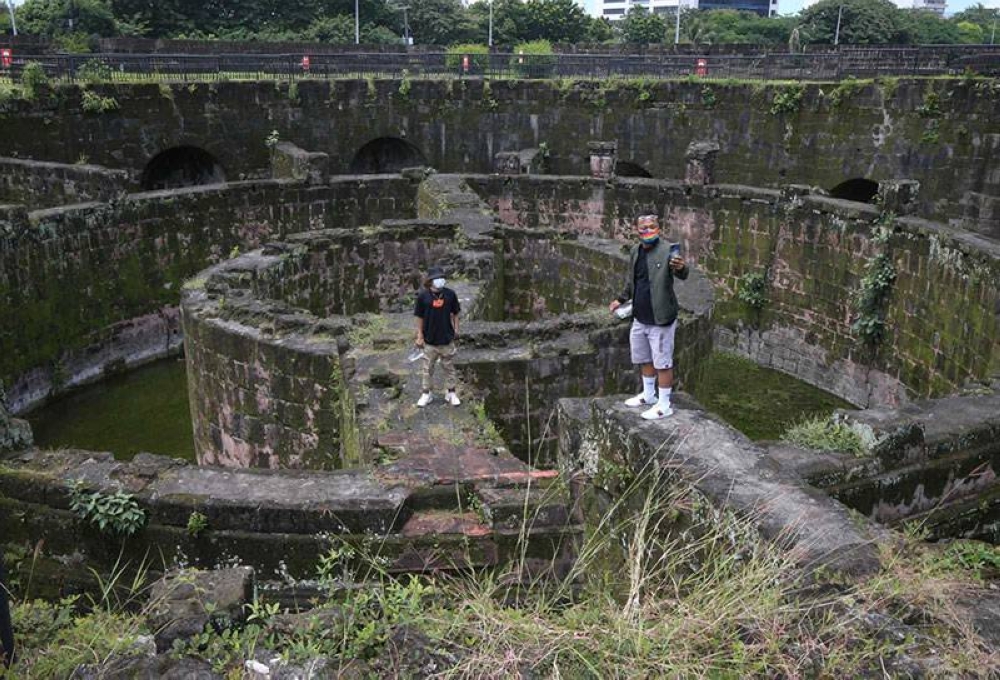
By: Jillian Dionela
Casa Manila
6. ride a bambike, types of accomodation:, history of intramuros.
The Walled City of Intramuros in Manila City is located south of the Pasig River and east of Manila Bay. It was constructed by Spanish colonizers in the mid 1500s after their arrival to serve to establish their military and political bases in Asia.
Intramuros was constructed as a city with a privileged status with churches, schools and government structures. These walls were later built to safeguard Intramuros from natural disasters as well as intruders. Intramuros was the capital of power during Spanish rule.
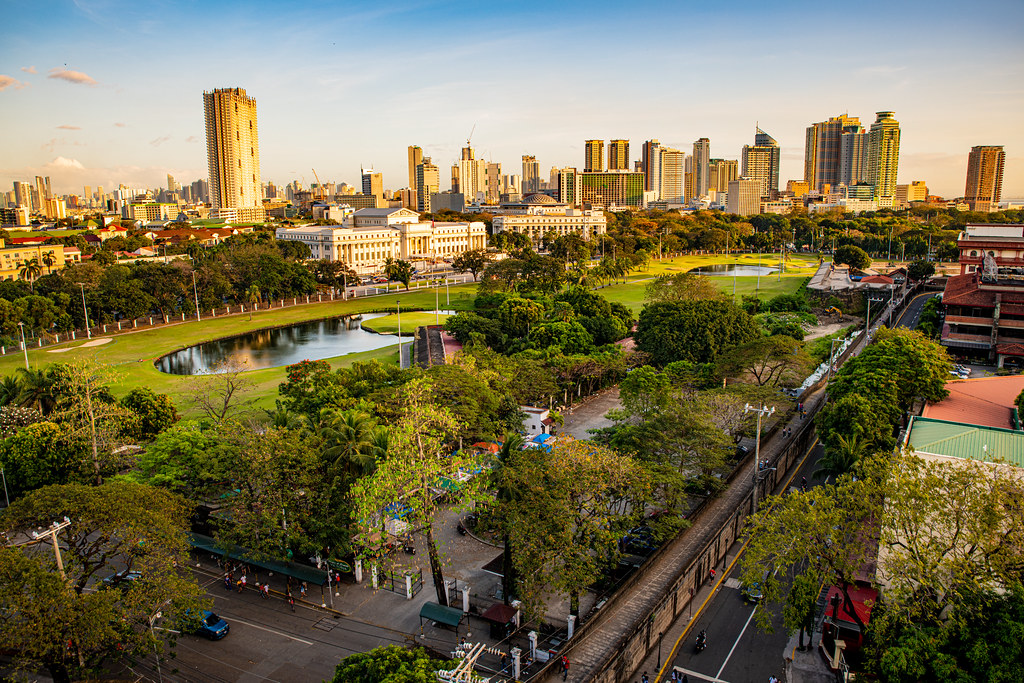
In addition to the 4.5-km. wall, which is where the name originated (“within within the wall”) there were other defensive structures were built to surround the city like moats, cannons, bulwarks and javelins. The wall not only protected Intramuros from natural disasters, but it also deterred the threat of Chinese pirates, Dutch force, Chinese pirates, Dutch forces and other intruders.
While heavily inspired by Spanish architecture (think extravagant baroque church designs) Renovations have also exposed the Chinese influences. In the 80s, government officials facilitated an enormous restoration effort that restored Intramuros to the present condition.
The fact that it is no longer an eye-sore, however. The history behind the ruin is what makes it an important place to visit in Manila even today despite the changes it has seen.
Additionally to that, fortresses, ramparts and gates of the past remain open and are the mainstay of walks and cultural events for tourists who want to know more about the country’s history. In the present, Intramuros is a prominent tourist attraction where you are able to experience the Spanish-era Manila through the city’s walls, restaurants, churches and museums.
How to go to Intramuros
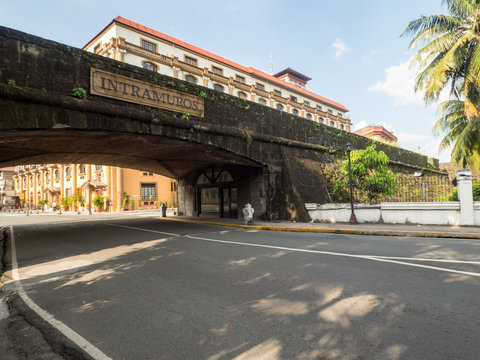
At Quezon Avenue in Quezon City take a jeepney, or van that is bound to Buendia. The driver may request to drop the passengers on Liwasang Bonifacio (also widely known as its previous designation, Plaza Lawton). If you’re at Liwasang Bonifacio, it’s just one short stroll to Intramuros.
If there are no Buendia-bound vehicles on the road then you could opt for either a jeepney or a van that goes to Quiapo. From Quiapo you can take a jeepney to Pier 15 that passes within Intramuros.
If this is your first time visiting Intramuros and you’re a bit unsure concerning public transportation then you could take a taxi or utilize the mobile app of Grab.
What to see and do in the Intramuros
The city’s walls aren’t very large, and when compared to other tourist spots located in Metro Manila, there are very few activities and sights are accessible inside the walled city.
The best part about visiting the Walled City is that each place you visit is rich in historical significance and is just an easy walk from one another. Here are a few of the structures and landmarks that you should definitely visit in Intramuros:
1. Fort Santiago

A trip to Intramuros can’t be complete without getting close to the things that were the reason it became so famous–the brick wall, garrison and fortifications that protected the elites and colonizers who used to reside in the area. The strongholds remain in the city to this day, leaving just a few stretches of land in the vicinity of Pasig River. Pasig River.
The most well-known among the forts would have been Fort Santiago in the northwestern northern part of the city. Fort Santiago is the primary fortification of Intramuros constructed in the 1500s. It’s located on Pasig River; being a defense fortress, it’s strategically placed to protect against pirates and other invaders.
2. Marvel at the architectural design and the faith that is reflected in the churches.

The Spaniards are responsible for the growth of Christianity in the Philippines It also was logical to Intramuros to be home to a handful of churches so that the colonizers within can continue to practice their religion. The two most prominent include Manila Cathedral and San Agustin Church.
The Grand Manila Cathedral, founded in 1571, is one the most easily recognized structures within Intramuros. The present structure is the fifth church built following the earlier ones that were destroyed by natural disasters and the Second World War. The Manila Cathedral is also a well-known wedding location. The cathedral was dedicated to Immaculate Conception.
The San Agustin Church, founded in 1571, has been classified as an World Heritage Site by UNESCO as well as a National Historical Landmark by the Philippine Government. San Agustin Church is the oldest church built of stone located in the Philippines. The present structure constructed out of stones, was the 3rd church to be constructed in the area after the two first timber structures had been destroyed in a fire.
3. The time to pass is in public squares and important structures
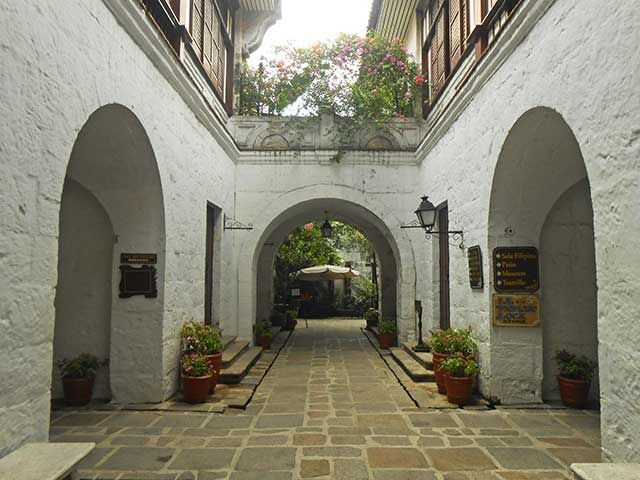
As it used to be home to the elite at the time It’s not a surprise that there are numerous public squares in Intramuros that people can use to spend their time in leisure. Since then, Plaza de Roma has been one of the town squares. Plaza de Roma, located right across Manila Cathedral, was the principal public square in Intramuros. It was the site of many gatherings and celebrations before it was turned into an outdoor garden by the Governor-General in the late 17th century.
Plaza San Luis took its name from one of the old barrios of Intramuros. It’s now an urban and cultural complex that includes museums, restaurants and a venue for events. Plaza San Luis is located close to San Agustin Church.
4. Visit a museum
A trip to an art museum is a good idea if you love admiring antiques and other historical artifacts. If you are in Intramuros you are essential to know the most about the rich past of the city’s walled walls, but also about Manila as a whole. There is nothing better to learn than these Intramuros museums.
- San Agustin Church Museum
- Rizal Shrine Museum
- Rizaliana Furniture Exhibit
Bahay Tsinoy
- Archdiocesan Museum of Manila
Light and Sound Museum
- Fr. George J. Willmann, SJ Museum
- The Bonsai Library and Museum
- The Silahis Center
- Baluarte de San Diego
- Likha-an sa Intramuros
- Destileria Limtuaco Museum
- iMake History Fortress LEGO Education Center
- Instituto Cervantes de Manila
- Museo de Intramuros
- The Attic Museum
- Colegio de San Juan de Letran
San Agustin Museum

The museum houses an assortment of Spanish colonial-era ecclesiastical clothes as well as manuscripts, sacred vessels as well as ivory and wooden statues, Dominican paintings and sculptures and a variety of other sacred objects.

In this interactive museum visitors can explore Philippine history during the Spanish rule and the lifestyle of Rizal by way of images, sounds and animatronics.
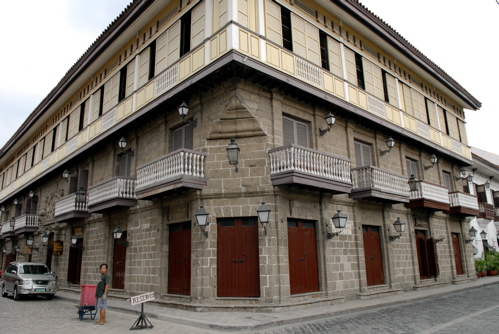
In this site, you can discover the past and achievements of China-Filipino communities, which includes those who supported the Filipinos’ revolution against Spaniards.
It also houses galleries as well, such as Batang Tiaong, Bahay na Bato (Chinese settlement in Manila), Ching Ban Lee Ceramics Gallery, Martyrs Hall along with Batang Tiaong.
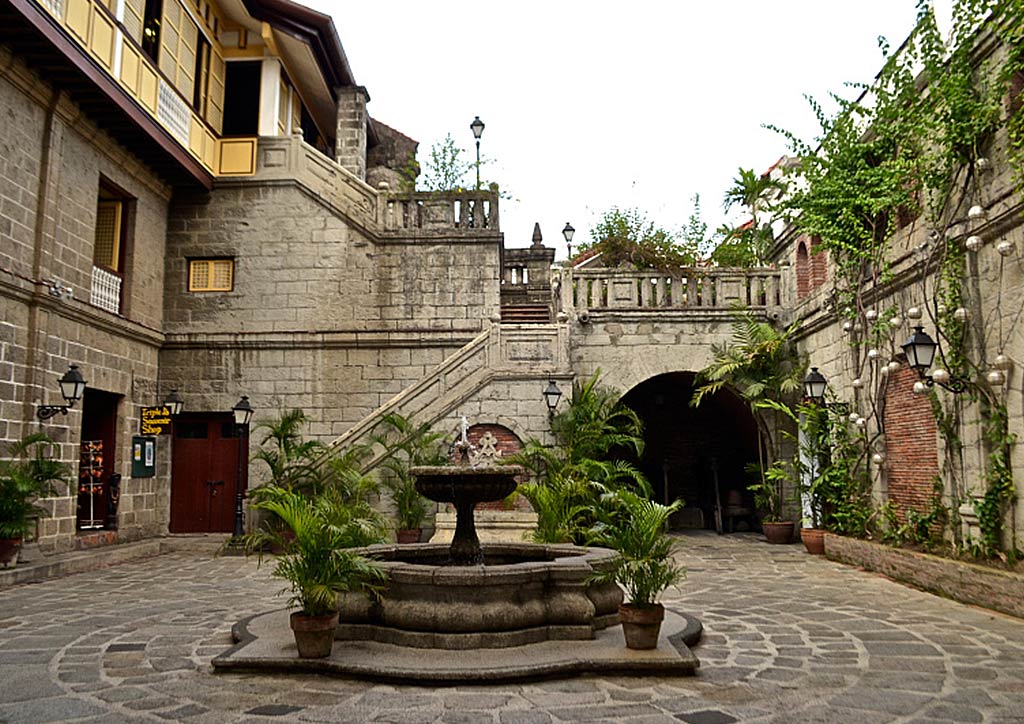
The location can be described as a recreation of residence of a wealthy family from the 18th century or the Ilustrados.
These are the educated and wealthy classes that held immense influence in both the state and among the people. The homes are full of furniture, art and other objects that date back to the colonial age.

In Intramuros eating out is about the ambience and overall experience, not the diversity and variety of food options. There’s nothing really unique about eating in a restaurant, but when you’re in Intramuros located in the midst of historical buildings, the dining experience gets a new level. The majority of restaurants located in Intramuros provide Filipino cuisine , so if that is what you want, then make your way to the city that is walled.
There are some restaurants that serve international cuisines (after all, Manila is a melting pot of different kinds of cultures) which foreigners may be familiar with but the best method to take pleasure in your Intramuros food tour is to stick to local favorites that serve traditional Filipino food and a cultural experience.

The most well-known thing to do in Intramuros is exploring Intramuros on bicycles. These aren’t your typical bicycles, they are eco-friendly , sustainable, and bamboo bicycles that are made by hand. If you’d like to experience this, you must look into Bambike’s website. The price for this tour is P1,747.98.
Where can you stay
The space within Intramuros is small, it is only sensible to have only a handful of accommodation options available to people who wish to stay inside these walls during the duration of their stay. Some are quite expensive. But, there are plenty of alternatives beyond the walls.

There’s a lot of activity taking place within Intramuros, Manila, or almost any city or district within the Metro. But, the capital city doesn’t let tourism down and, therefore, whatever type of traveler you’re: someone who backpacks with money in the bag or an experienced traveler who’s had saved for a week of adventure, there’s going to be a perfect accommodation option both inside and out of Intramuros.
Budget and luxury Hotels of all kinds are found in Manila. In actuality, Manila Hotel, one of the most well-known brands in luxury hotels, is within Intramuros. But, as one of the most popular tourist destinations in the Philippines, Manila caters to penny-pinchers and budget-conscious travelers too.
Apartment and Condominium Units for Rent
Rental properties around Intramuros are usually available on Airbnb. There are many apartments and condominiums in Manila mostly due to the recent growth of the real estate sector. A lot of these rooms can be rented out for various reasons, which makes it a reasonable option for accommodation for tourists.
What to Pack
Other than your basic necessities (i.e. passport, ID cards, cash and other ID cards. ) In addition, you might need your smartphone along with pocket Wi-Fi (or purchase local SIM to use data) to help you navigate if you need to. Unfortunately there aren’t all public spaces in the Philippines offer free Wi-Fi, so it’s best to have your own.
As we’ve mentioned before, pack lightweight clothing and shoes that are comfortable for walking. If you’re anticipating rain, make sure you have an umbrella, raincoat or jacket to safeguard yourself. If it’s going to be warm, a new set of clothing, towels as well as plenty of water are essential.
Things to Remember
- Intramuros is a public space therefore there is no entrance cost for visitors who would like to go there.
- Intramuros is the best place to explore during the dry time that runs from January to May.
- Dress in comfortable shoes and clothes while walking through Intramuros. If you’re traveling on your own and you are traveling on your own, it might be beneficial to carry an extra selfie stick to capture memorable images as you wander around Intramuros.
- You can take as many photographs as you like of the iconic landmarks of Intramuros.
- Intramuros is usually a secure location, particularly since there are security guards in numerous corners and structures. But, be cautious and ensure your possessions are secured, especially in case you’re exploring unfamiliar territory.
- Intramuros is easily accessible by vehicle.
- Always seek permission before you want to visit a structure or square.
- There are a lot of dark places in Intramuros and it is scary in certain places. Actually, some of the most frightening locations in Manila are located in Intramuros.
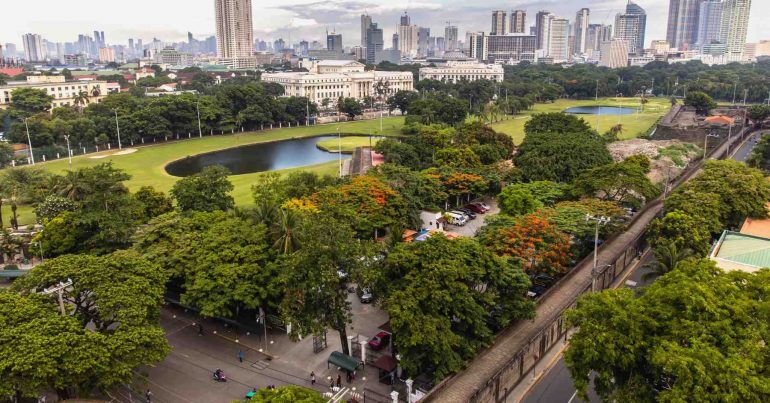
At present, upgrades and enhancements are being carried out to preserve the appearance and timeless appeal of Intramuros. It’s always good to visit again and discover the latest developments if you’re looking for.
Intramuros is an ongoing reminder to Filipinos to remember that beauty exists even in the chaos. Maybe not necessarily in terms of appearance however, the fact that they are able to endure the harsh realities of time and the past and improve from them is still something to be celebrated.
It is an extremely secure city, protected by fortifications, however its rich past must be displayed at the forefront for the world to experience. This is the reason Intramuros is one of the most well-known destinations on Manila tours.
Take a trip back in time to discover for yourself the things that make Intramuros an exceptional destination. Intramuros tours , activities and excursions are available throughout the year for you to experience.
- intramuros , intramuros tourist spots , philippines , philippines tourist destination , philippines tourist spots , tourist spots
Leave a Comment Cancel reply
Save my name, email, and website in this browser for the next time I comment.
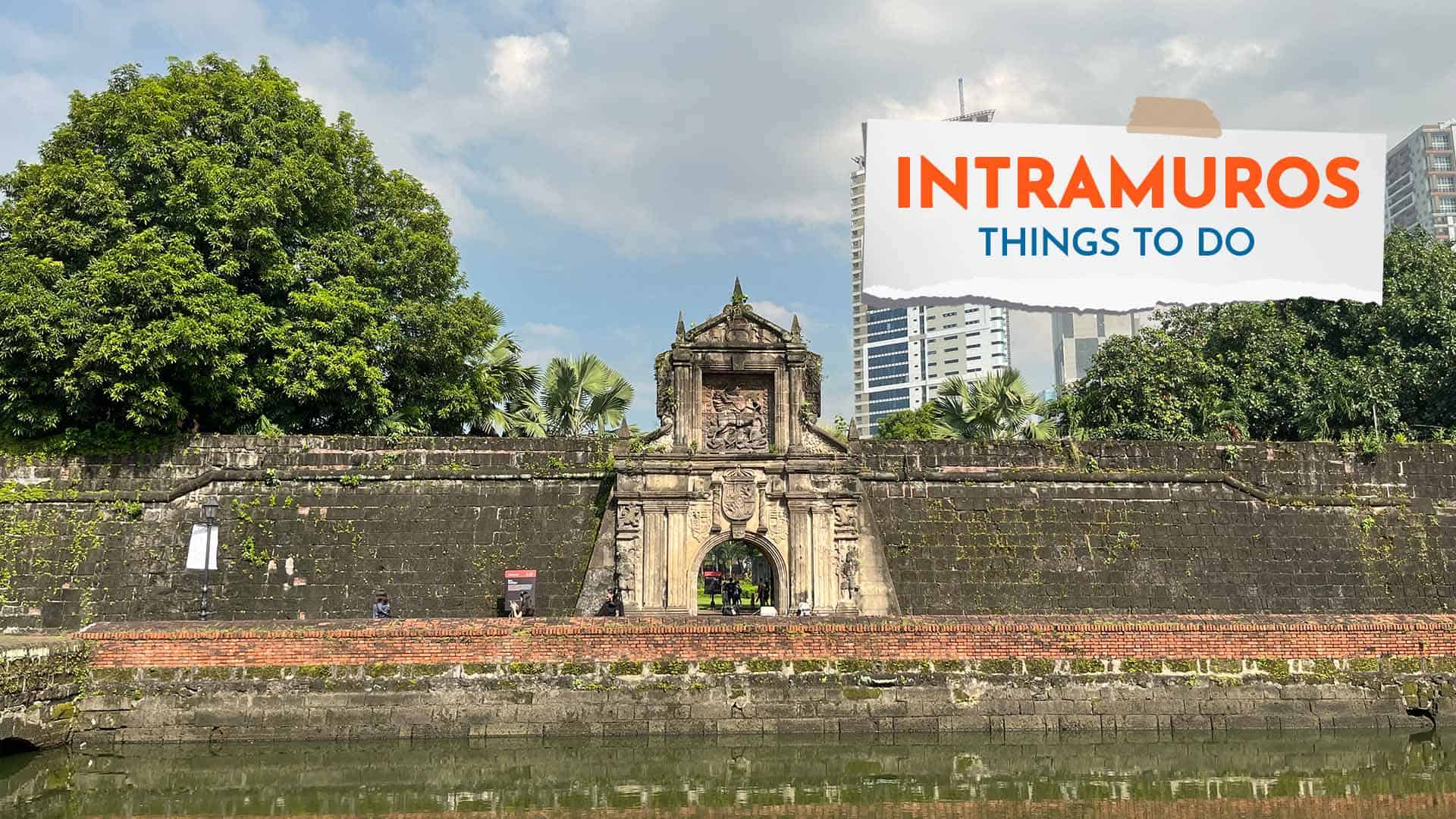
Top 12 Things to Do & Tourist Spots in Intramuros

Intramuros is one of, if not the most, historic places in Manila, the capital city of the Philippines. Its name literally translates to “ within the walls ” in Spanish, which is why it’s also referred to as the walled city.
Situated by the mouth of the Pasig River, its walls and other fortifications protected Manila from foreign invaders during the Spanish colonial period. Its construction began in the late 16th century and concluded in the beginning of the 19th century.

Today, Intramuros carries the old-world charm of Manila in the historical buildings and landmarks that decorate its (mostly) cobblestone streets. You won’t go far into the walled city without catching sight of a historical marker greeting you at every corner. Visitors can check out the thick stone walls, gates, and other defense structures that protected what was once considered the entire City of Manila. Museums, old churches, and other historical buildings are also sprinkled all over its map.
Whether you’re a history buff or you’re simply looking for something to do in Manila, add Intramuros to your itinerary and allot a day to get lost within its walls. In this post, you’ll find some of the best things to do and historic spots to visit as you walk along the streets of old Manila.
WHAT'S IN THIS GUIDE?
Intramuros Pass
If you’re touring Intramurous, you could save a few bucks by availing the Intramuros Pass , which will give you access to up to five (5) activities and attractions. This is perfect for those planning to visit multiple attractions within the historic walled city. We highly recommend availing the pass to save on entrance fees.
Don’t forget to activate your pass by reserving a date and a time slot for at least one attraction within 30 days from booking confirmation date. You can choose from any of these attractions:
Fort Santiago
Museo de intramuros.
- Casa Manila Museum
Baluarte de San Diego
✅ GET YOUR INTRAMUROS PASS HERE!
Fort Santiago, the primary fortress in Intramuros, is one of the city’s oldest forts. Initially built as a palisaded fort by Rajah Soliman, it was later reconstructed with stone by Miguel Lopez de Legazpi between 1590 and 1593. Throughout history, it served as the headquarters for various occupying forces, including the Americans, British, and Japanese, as well as functioning as a prison.
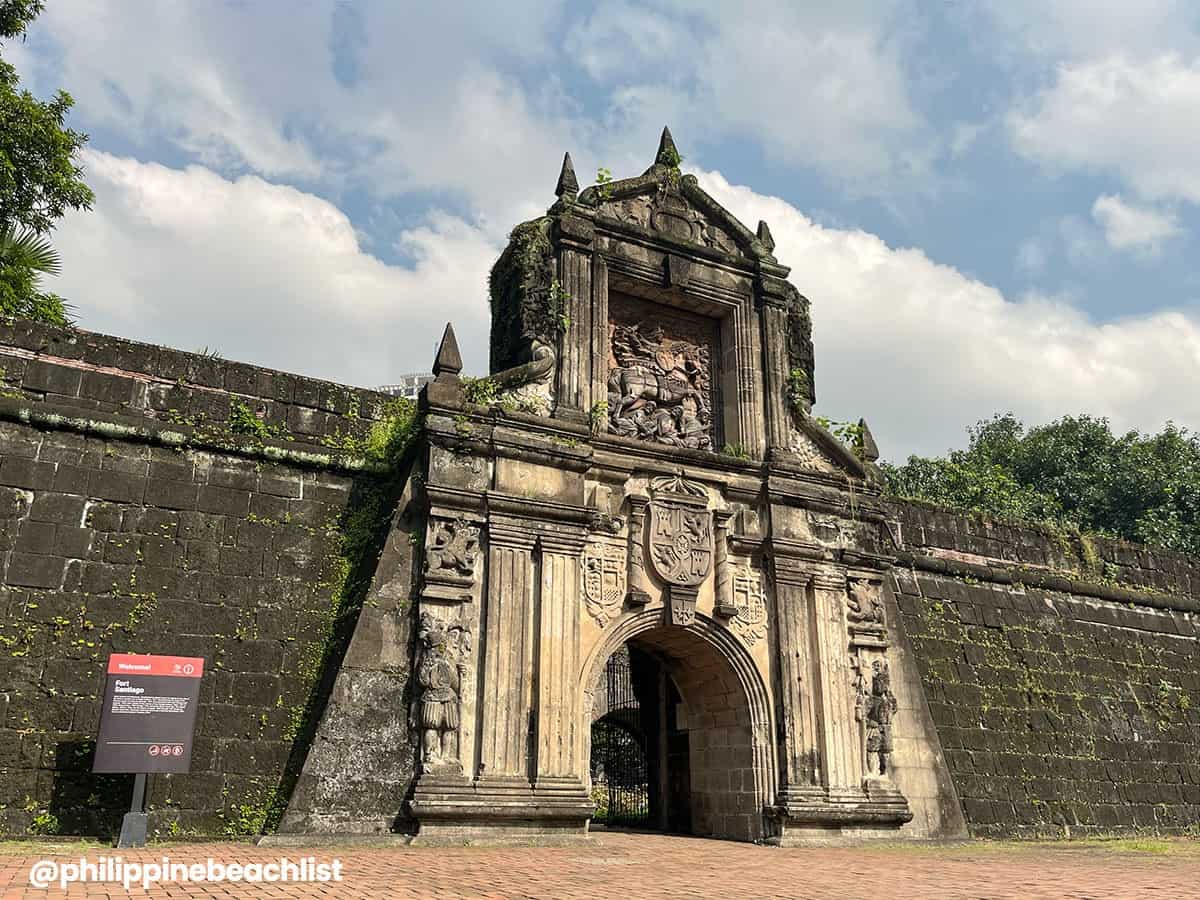
Before his execution in 1896, Jose Rizal, the country’s national hero, spent his last days at this fort. Eagle-eyed guests will spot his final footsteps marked on the floor from his prison cell. Museo ni Rizal , dedicated to the revolutionary, is also located inside Fort Santiago, specifically in the building where Rizal’s prison cell once stood.
Aside from the Museo ni Rizal, Fort Santiago boasts several points of interest, including barracks ruins, numerous bastions, the Rajah Sulayman Theatre, Plaza Armas, a memorial cross, and more. Near the entrance, a visitor center offers maps of the fort, refreshments, and souvenirs.
During our visit, we found a gem of a coffee shop towards the back of Fort Santiago, past Plaza Armas. Papa Kape sits inside Aljibe de la Fuerza, a 400-year-old water cistern. Nowadays, the only water you’ll find is in the machines brewing local coffee. They offer hot and iced coffee drinks, some featuring Filipino delicacies, such as their Tahoat, inspired by the local snack “taho” made with silken tofu.
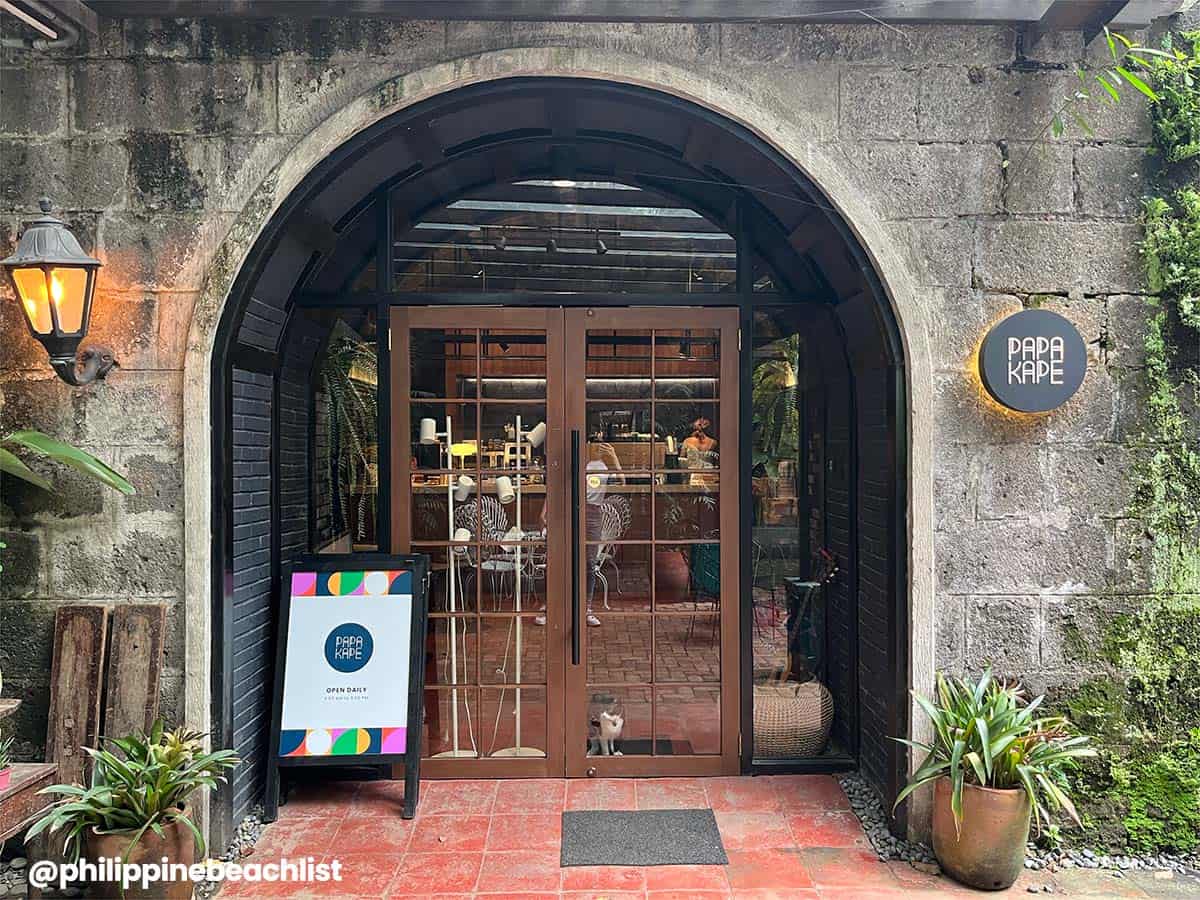
Grab your tickets at the entrance or purchase online! Fort Santiago is also covered by the Intramuros Pass.
✅ GET YOUR FORT SANTIAGO TICKET HERE!
Opening Hours : Monday to Friday, 8:00 AM – 10:00 PM (last entry at 8:00 PM); Saturday to Sunday, 6:00 AM – 10:00 PM (last entry at 8:30 PM). Schedule might change without prior notice. Make sure to visit their website or official Facebook page for updates. Entrance Fee : Regular, P75; Children, Student, Senior Citizen, PWD, P50 Location : Main Entrance, Sta. Clara Street, Intramuros, Manila City
Identified by its circular fort, Baluarte de San Diego is another bastion in Intramuros. Its unassuming entrance hides the Torre de Nuestra de Señora de Guia , tower-turned-bulwark following the demolition of its upper portion after suffering from cracks. This spade-shaped structure is what we call Baluarte de San Diego today.
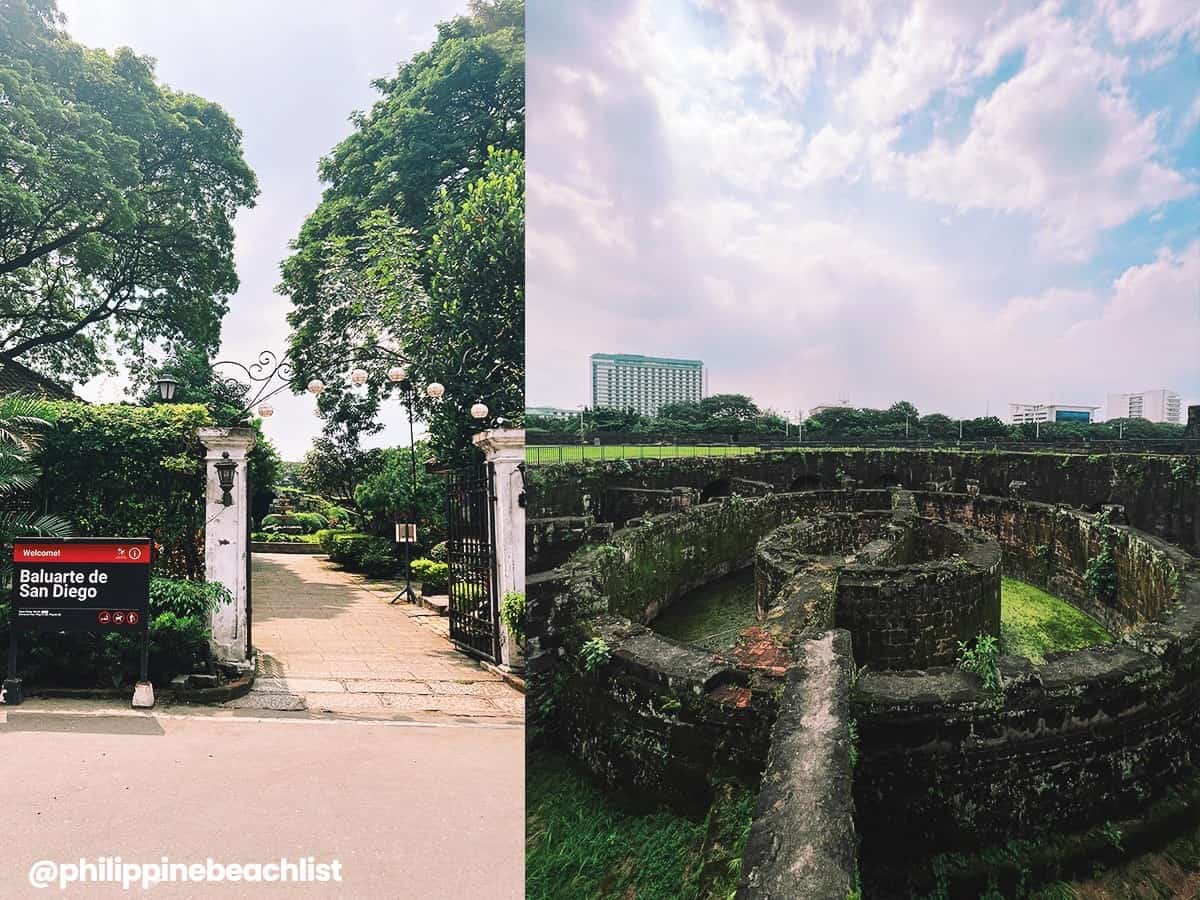
In 1863, it was destroyed by an earthquake and was subsequently abandoned. This effectively buried the circular fort under layers of soil during the country’s American colonization. In 1979, it resurfaced after excavation. Today, the restored baluarte is surrounded by a garden, placing it among the top rentals for events.
While the garden itself is perfect for pictures, most Google searches will bring up the pictures of the baluarte’s remains. And for good reason! Seeing it in person gives you a better grasp of how this adobe structure protected Intramuros.
On days without events, Baluarte de San Diego is open to visitors for a small entrance fee. You can buy your tickets at the entrance or book it online. Baluarte de San Diego is also covered by the Intramuros Pass.
✅ GET YOUR BALUARTE TICKET HERE!
Opening Hours : Daily, 8:00 AM – 5:00 PM (last entry at 4:00 PM). Schedule might change without prior notice. Make sure to visit their website or official Facebook page for updates. Entrance Fee : Regular, P75; Children, Student, Senior Citizen, PWD, P50 Location : Sta. Lucia Street corner Muralla Street, Intramuros, Manila City
Casa Manila
Located across San Agustin Church, Casa Manila is a museum that represents the life of an affluent Filipino family during the Spanish colonial period. It sits within the Plaza San Luis Complex . Casa Manila’s facade takes inspiration from a house that stood in the Chinese district of Binondo in the 1850s.
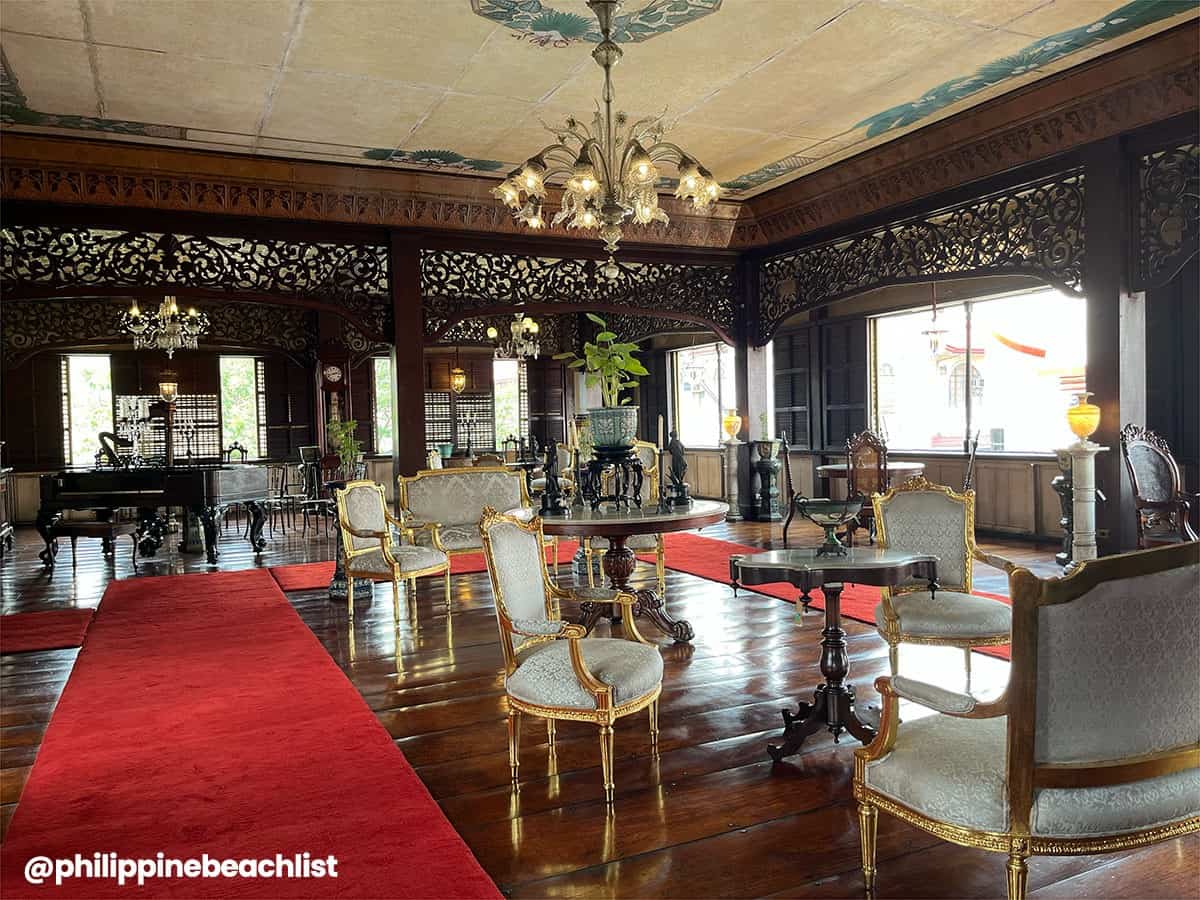
In the museum, you’ll observe 19th-century elegance in the form of hardwood floors, furniture, and chandeliers. Museum goers must keep their feet within the carpeted area, except at the accessible kitchen or cocina . Despite these restrictions, it’s a captivating glimpse into Spanish-period housing. The well-preserved furniture takes you back in time, allowing you to envision life in that era.
When you visit, you can buy tickets at their ticket booth located inside Plaza San Luis Complex. However, you can also purchase your tickets in advance online. Casa Manila is also covered by the Intramuros Pass.
✅ GET YOUR CASA MANILA TICKET HERE!
Opening Hours : Tuesday to Sunday, 9:00 AM – 6:00 PM; Monday, CLOSED. Schedule might change without prior notice. Make sure to visit their website or official Facebook page for updates. Entrance Fee : Regular, P75; Children, Student, Senior Citizen, PWD, P50 Location : Real Street corner General Luna Street, Intramuros, Manila City
Bambike Ecotours Intramuros
There are multiple ways to do a tour of the walled city: walking, a pedicab tour, or a guided bike tour. If you are more into cycling, Bambike Ecotours Intramuros offers another fun way to go around Intramuros. Bambike has guided bike tours which will take you to the historic spots in the area while riding a bamboo bike .
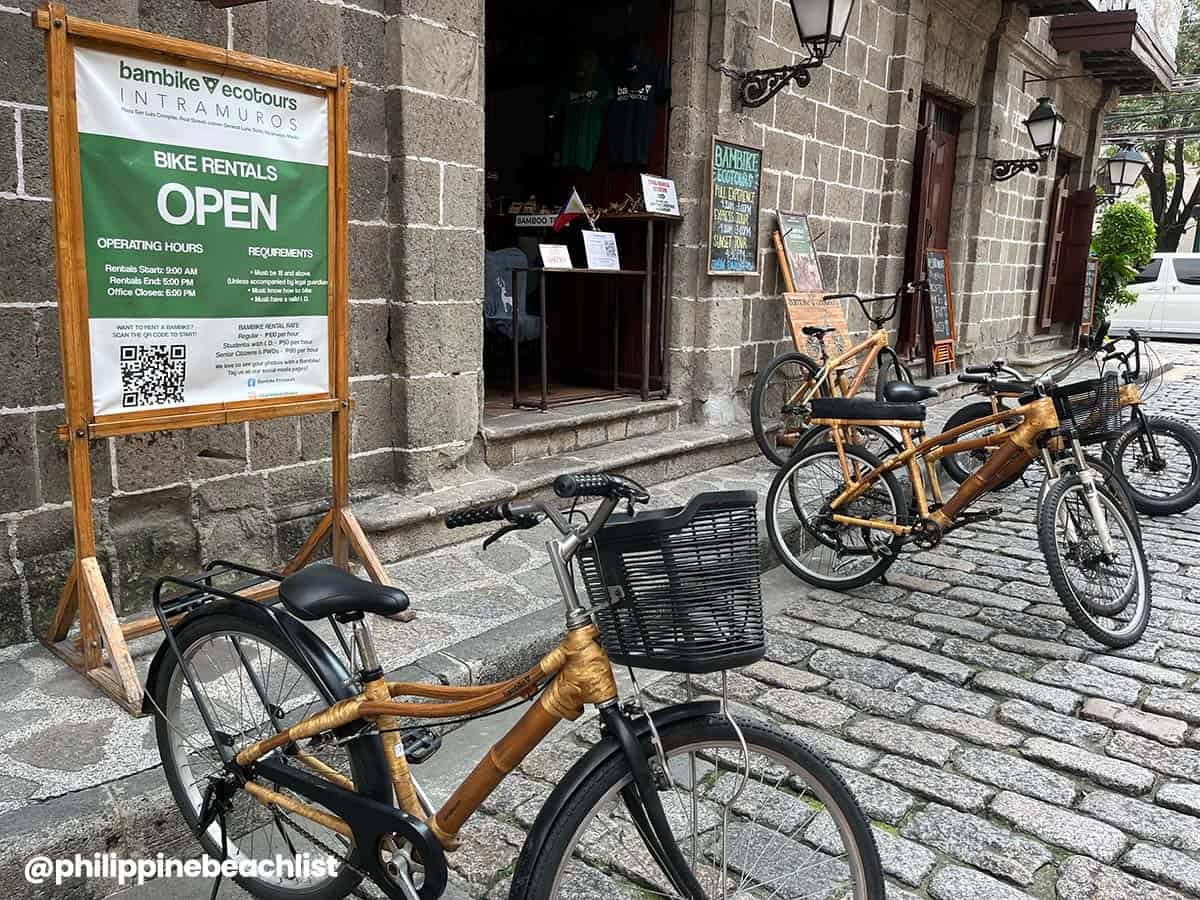
Bambike Ecotours offers 3 types of tours:
- Intramuros Experience: This is a two and a half hour tour of Intramuros.
- Intramuros Express Tour: This lasts for one and a half hours.
- Intramuros Sunset Tour: This is a late afternoon tour that ends at the rooftop of the Bayleaf Hotel where guests can enjoy a complimentary drink while watching the sunset.
All three tours come with guides so you can learn about each stop and have a deeper appreciation for them. Alternatively, you can also rent bambikes per hour if you want to explore Intramuros on your own.
Walk-ins are welcome for both the bike rentals and the tours. Just make sure to arrive before the scheduled tour you want to avail. However, it is best to book a tour in advance since they have limited bicycle units available. You can book your Bambike Intramuros Tour in advance online. You can choose to book just the bambike tour alone, but you can also bundle it with the Intramuros Pass.
✅ BOOK INTRAMUROS BAMBIKE TOUR HERE!
Opening Hours : Daily, 9:00 AM – 6:00 PM. Schedule might change without prior notice. Make sure to visit their website or official Facebook page for updates. Tour Schedules : Full Experience: 9:30 AM & 3:00 PM Express Tour: 9:30 AM & 3:00 PM Sunset Tour: 4:30 PM Rates: Rental: Regular, P100/hr; Student, P50/hr; Senior Citizen & PWD, P80/hr Full Experience: P1,700/person Express Tour: P1,000/person Sunset Tour: P1,800/person Location : Real Street corner General Luna Street, Intramuros, Manila City
White Knight E-Chariot Tours
If you’re not looking forward to walking or biking across Intramuros, White Knight Hotel’s E-Chariot Tours may catch your eye. “E-chariot” is just a fancy term for electric scooters (Think: Segway). Its wide chariot-like wheels will have you rolling around Intramuros through their 30-minute or 60-minute tours. Some of the sites included in this tour are the Manila Cathedral, Fort Santiago, and San Agustin Church.
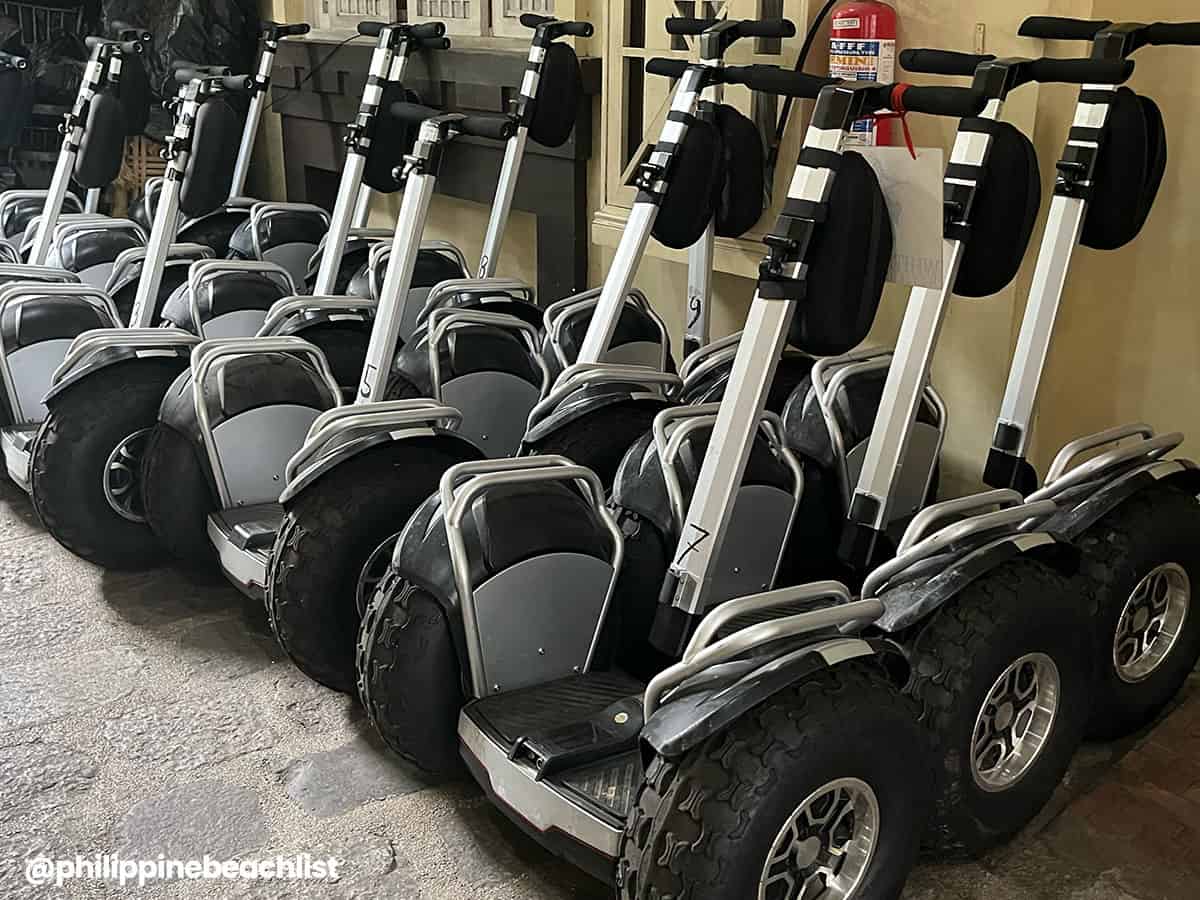
You will find White Knight E-Chariot Tours at White Knight Hotel located within Plaza San Luis Complex. Walk-ins are welcome, but you can also book in advance online, where you’ll also find discounted rates so you can save a little bit when you book through them. If you’re interested in booking an E-Chariot Tour, you can click the link below. You can also choose to bundle your E-Chariot tour with the Intramuros Pass which will give you access to multiple attractions in the walled city.
✅ BOOK E-CHARIOT TOUR HERE!
Opening Hours : Daily, 8:00 AM – 5:30 PM. Schedule might change without prior notice. Make sure to visit their website or official Facebook page for updates. Rates : P1,000/hr per person Location : General Luna Street, Intramuros, Manila City
Housed in the reconstructed San Ignacio Church and the Mission House of the Society of Jesus, Museo de Intramuros displays the ecclesiastical collection of the Intramuros Administration. Aside from the collection exhibited here, the building itself is historical. San Ignacio Church is one of the two churches that the Jesuits built in honor of St. Ignatius of Loyola.
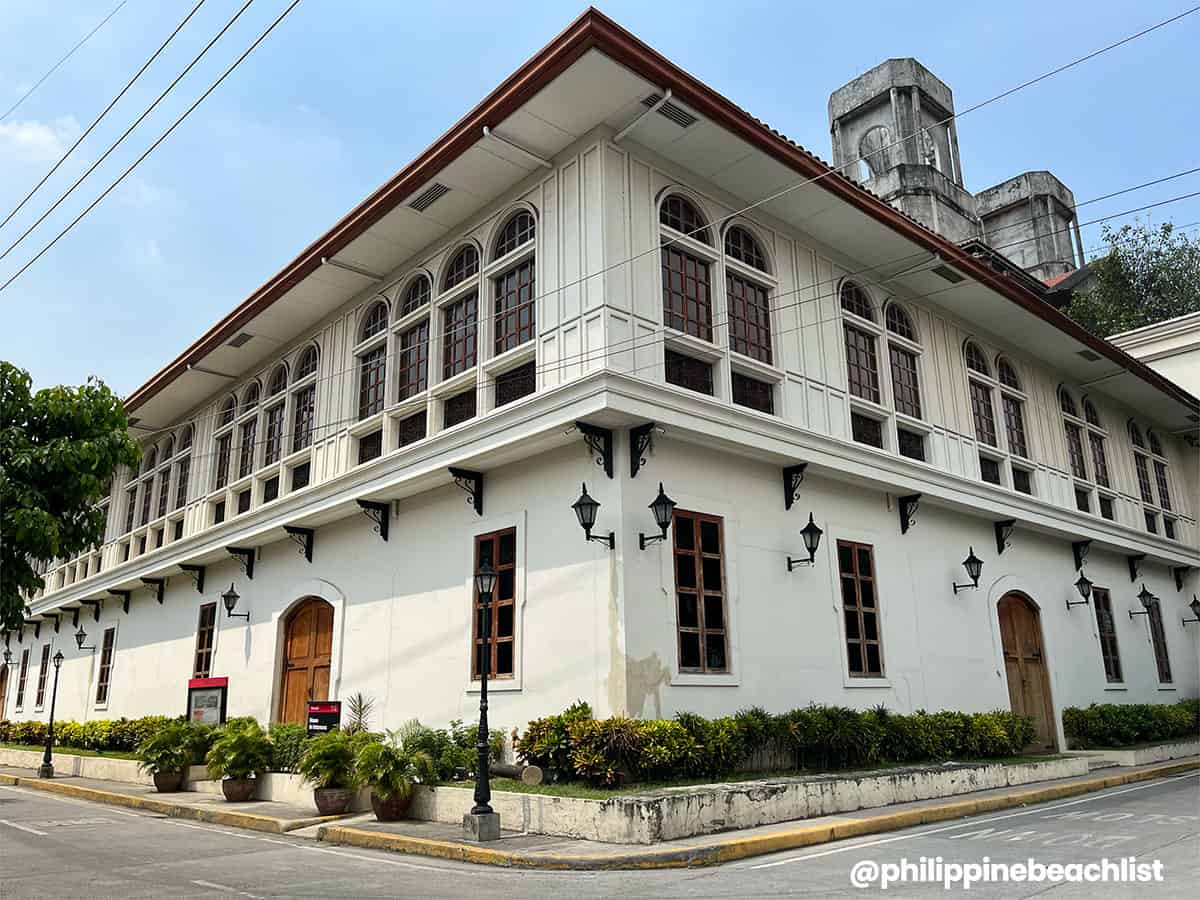
The second San Ignacio Church broke ground in 1878, guided by the designs of Don Felix Roxas, a renowned architect during that time. This church wowed with its carved wood interiors, but much like most of the landmarks in Intramuros, World War II leveled the church. It wasn’t until the creation of the Intramuros Administration in 1979 that the plan to reconstruct the church materialized.
If you’re planning a weekday visit, you may want to exclude Museo de Intramuros from your plans, unless you’re a group with a minimum of 10 participants. These Exclusive Tours must be reserved at least 2 days in advance. For inquiries, you may send an email to [email protected] or call 0915 717 4115, 0936 840 3225, or 0915 599 4483.
For regular weekend visits, tickets are available at the entrance. However, you can also purchase tickets in advance online. Museo de Intramuros is also covered by the Intramuros Pass .
✅ GET YOUR MUSEO DE INTRAMUROS TICKET HERE!
Opening Hours : Saturday to Sunday, 9:00 AM – 5:00 PM; Monday, CLOSED; Tuesday to Friday, for exclusive tours ONLY. Schedule might change without prior notice. Make sure to visit their website or official Facebook page for updates. Entrance Fee : Regular, P75; Children, Student, Senior Citizen, PWD, P50 Location : Arzobispo Street corner Anda Street, Intramuros, Manila City
The Manila Cathedral
Formally called Minor Basilica and Metropolitan Cathedral of the Immaculate Concepcion , the Manila Cathedral is the cathedral church of the Archdiocese of Manila. First established in 1571, it was initially a parish church under the Archdiocese of Mexico established by Fray Juan de Vivero. Then, in 1579, the Diocese of Manila was erected and the church was acknowledged as a cathedral.
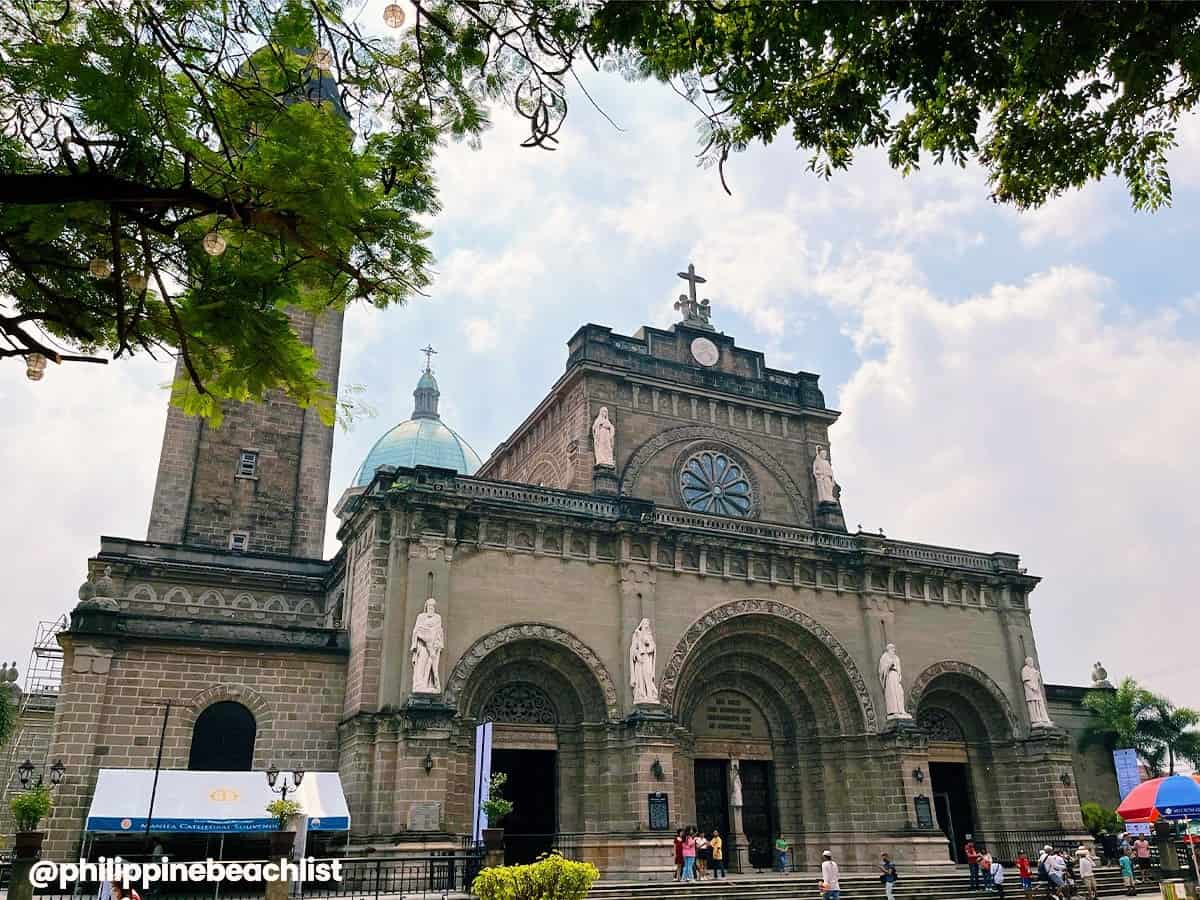
The cathedral, initially built in 1581, succumbed to fire in 1583. Reconstructed with stone in 1592, the cathedral eventually collapsed due to an earthquake in 1600. From then on, it developed a history of reconstructions due to earthquakes, typhoons, and the second world war. Pope John Paul II elevated the cathedral to a minor basilica in 1981, shortly after his visit and mass celebration, marked by a medallion with the papal arms beneath the cross on the facade and above the high altar.
For first timers, the security protocols at the entrance may surprise you, but these are just necessary precautions due to the high volume of visitors to the church. These contemporary additions honestly match the Neo-Romanesque architecture of the current reconstruction of the church. As “revival” architecture, Neo-Romanesque structures hoped to bring the past into the more modern present. Seems very fitting for this deeply historic yet oddly modern-looking church!
Location : Cabildo Street corner Beaterio Street, Intramuros, Manila City
San Agustin Church
San Agustin Church is the oldest stone church in the Philippines . Built from 1586 to 1607, the church took on the name “Church of St. Paul of Manila.” Today, it also called the Immaculate Concepcion Parish or the Archdiocesan Shrine of Our Lady of Consolacion and Cincture. In 1976, it became a National Historical Landmark . San Agustin Church is also one of the churches designated as a UNESCO World Heritage Site in 1993 under the collective title Baroque Churches of the Philippines .
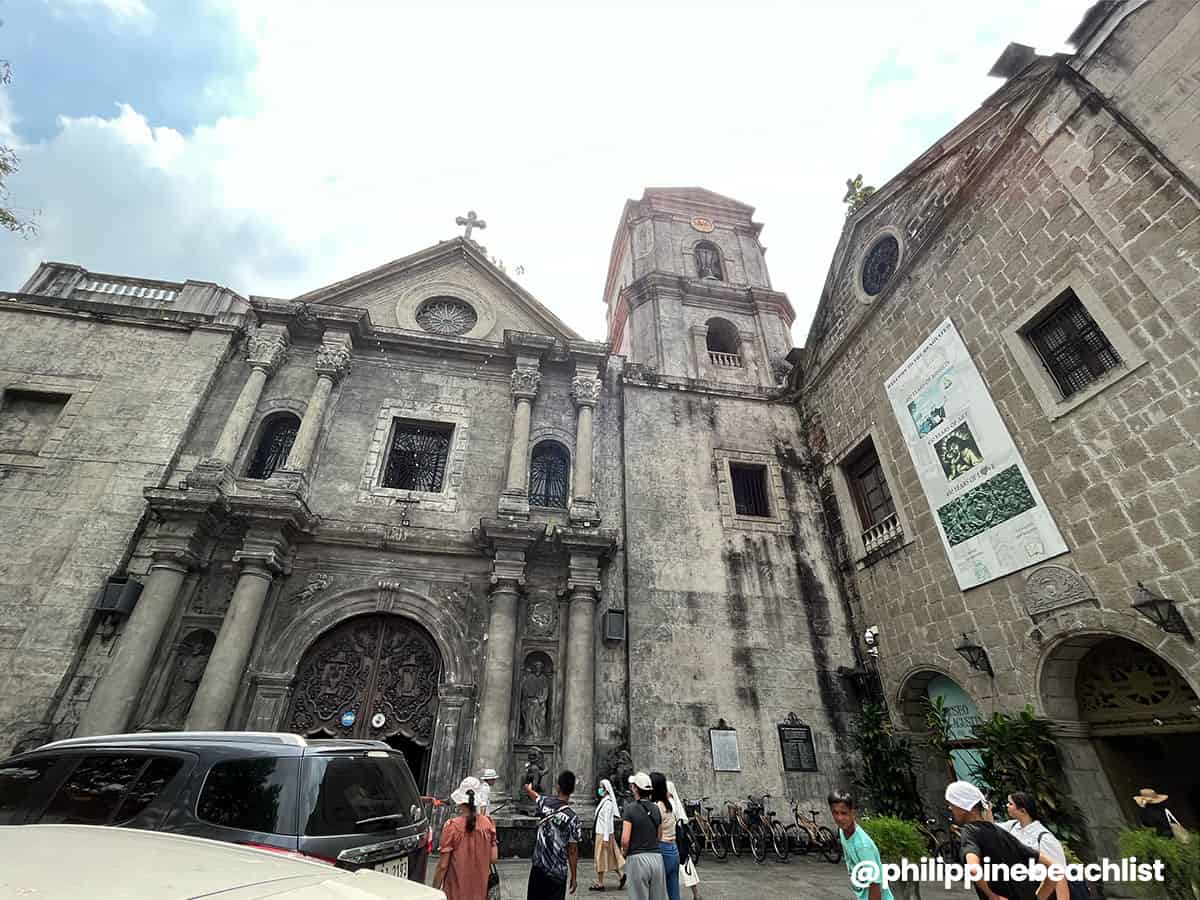
After the Battle of Manila, the original stone church underwent renovation in 1854. Despite enduring multiple major earthquakes, one of which necessitated the permanent removal of its left tower, San Agustin Church has also functioned as a hospital and served as a concentration camp during the second world war under Japanese occupation. At present, the church is under the Augustinian friars of the Province of the Most Holy Name of Jesus of the Philippines. Its monastery is now a museum adjacent to it, which tourists can also visit.
Do yourself a favor and look up when you enter the church. I honestly wouldn’t have known that the carvings on the ceiling weren’t even carvings at all, but rather trompe-l’œil paintings ! This mind-boggling view alone made this a must-see for us.
Location : General Luna Street, Intramuros, Manila City
Museo de San Agustin
Located next to San Agustin Church, Museo de San Agustin houses religious artifacts, carvings, books, and more. It occupies two floors and features several galleries. When you enter the museum, massive religious paintings will greet you at the door. A replica of the Sto. Niño de Cebu that was gifted by Ferdinand Magellan to Rajah Humabon’s wife, Juana, also sits in the hallowed halls of this museum.
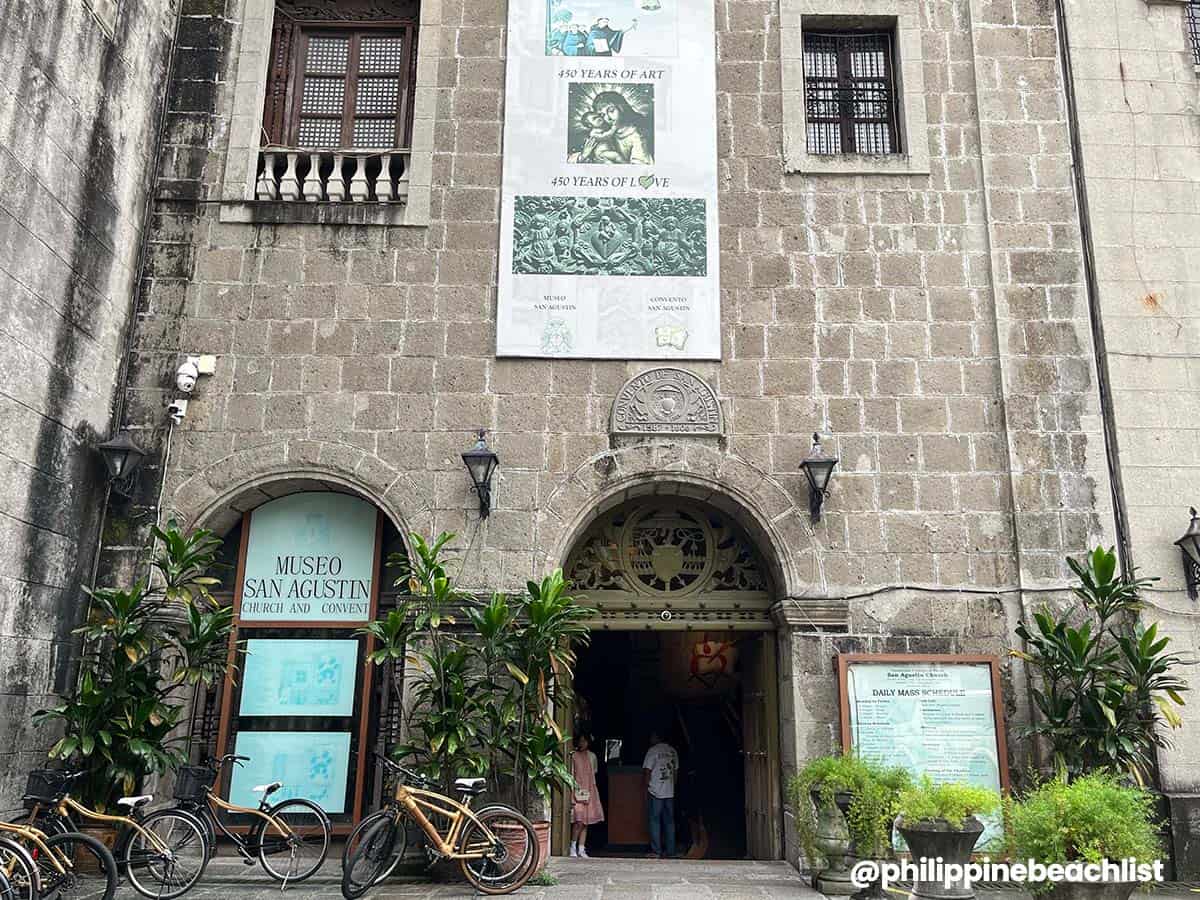
Inside the museum, a section includes a library exhibiting books and manuscripts dating from the 16th century to the present. Displays of medicinal plants used as remedies in the past are also featured. Art and history enthusiasts can explore the crypt, the final resting place of Juan Luna. Visitors can access the inner garden of the church from the museum, making it an extensive exploration that merits at least an hour’s visit.
Opening Hours : Monday to Sunday, 8:00 AM – 12:00 PM; 1:00 PM – 5:00 PM. Schedule might change without prior notice. Make sure to visit their website or official Facebook page for updates. Entrance Fee : Regular, P200; Children, Student, Senior Citizen & PWD, P160 Location : General Luna Street corner Real Street, Intramuros, Manila City
Bahay Tsinoy

Bahay Tsinoy or Museum of Chinese in Philippine Life is another museum situated within the walls of Intramuros. It is home to the Kaisa-Angelo King Heritage Center, which documents and showcases the life of the ethnic Chinese in the Philippines over the years.
Since 1999, the museum has stood on the corner of Anda and Cabido street. Inside, the museum features multiple sections including The Parian, Colonial Culture, Emergence of the Chinese Community, and Life in the 1800s. You will also find a gallery of rare prints and photographs and Martyr’s hall. A collection of ceramics and rare Philippine shells also make an appearance in the museum.
Opening Hours : Tuesday to Sunday, 10:00 AM – 5:00 PM; Monday, CLOSED. Schedule might change without prior notice. Make sure to visit their website or official Facebook page for updates. Entrance Fee : P100 Location : Anda Street corner Cabildo Street, Intramuros, Manila City
Destileria Limtuaco Museum
Destileria Limtuaco is the oldest distillery in the Philippines. Along San Juan de Letran Street in Intramuros, you will find their museum in a stone house. Opened in 2018, Distileria Limtuaco Museum tells the history of the company and their products. When you visit, you have the option to just pay the entrance fee to enter the museum or pay an additional P100 for a liquor tasting at the end of your museum tour.
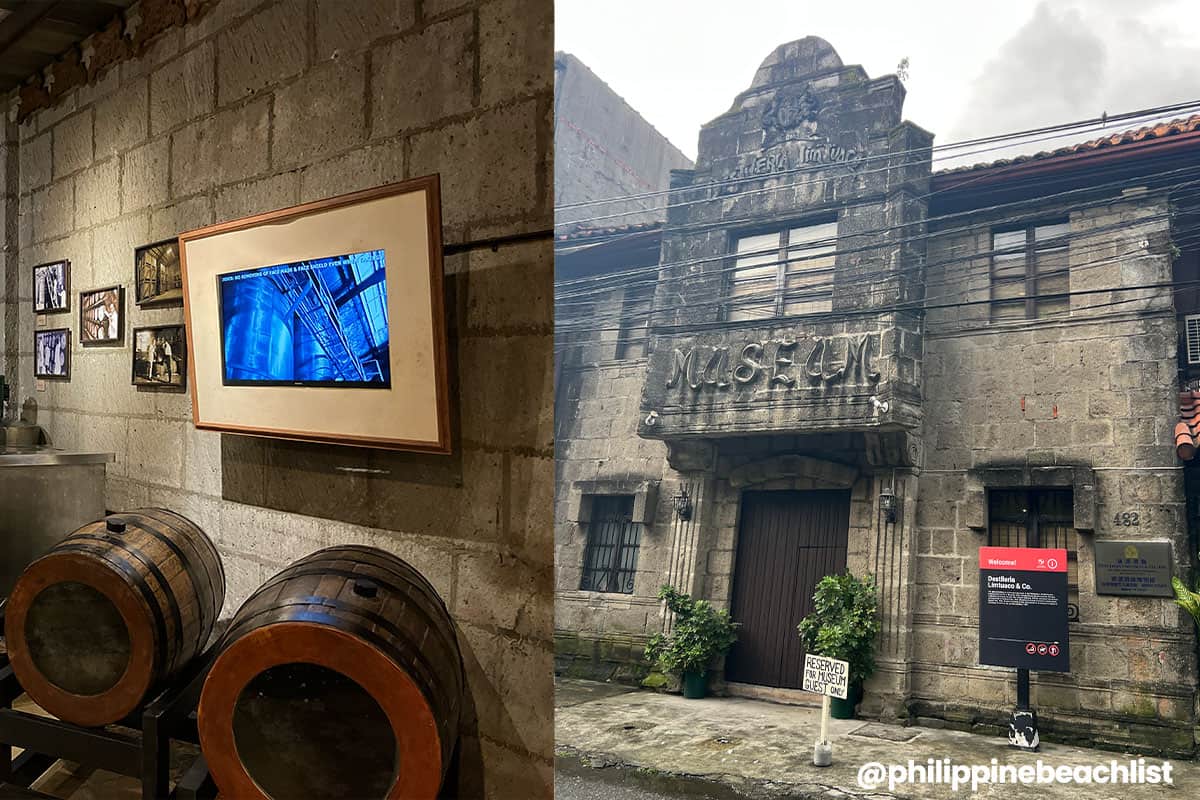
Our visit at the Destileria Limtuaco Museum is easily topped our Intramuros itinerary. When we entered, their friendly staff greeted us at the entrance. Then, their museum guides — whom we later found out were student-interns from nearby universities! — toured us around the two floors of the museum. They told us about the history of the company and ran us through the process of making different types of liquor. We appreciated how fleshed out this tour was, considering how most attractions in Intramuros don’t really have in-house guides. It’s perfect for D-I-Y-ers who aren’t accompanied by hired guides.
Proudly displayed in the Destileria Limtuaco Museum are the countless products under the brand, starting from their very first product, a Chinese herbal wine commonly known as sioktong , to their most popular product, the White Castle Whiskey . Their craft spirits also made quite the impression, with Filipino flavors like mango, calamansi, dalandan, coffee, and cacao, and their unique packaging.
We’re telling you now: avail the liquor tasting! You’ll get to try 6 of their products, four of which you can choose for yourself. Personally, we went for their craft spirits and the Intramuros or Liqueur de Cacao turned out to be our favorite!
Opening Hours : Tuesday to Sunday, 9:00 AM – 5:00 PM; Monday, CLOSED. Schedule might change without prior notice. Make sure to visit their website or official Facebook page for updates. Entrance Fee : Regular, P100; Children, Student, Senior Citizen, PWD, P50; Liquor Tasting, additional P100 Location : San Juan de Letran Street, Intramuros, Manila City
Walk Around Intramuros
If we’re being honest here, this list barely covers the rich history of Intramuros. But the best tip we have to remedy this is simple: if you’re looking for more things to do and places to visit, just walk around the walled city!
Keep an eye out for historical markers that narrate the brief history of the buildings or areas you will come across. Most of the more classic markers (usually made of stone or metal, in a gray or brown shade with white font) will be accompanied by Intramuros Administration’s more modern markers in red and black. Better yet, you can grab a map from the Fort Santiago Information Center to see where exactly you can find these historical sites.
More fortifications, military installations, and gates can be seen around here. You will also come across monuments, public installations, and plazas. Government buildings, residences, and palaces are also all over the district, some of which are already reconstructed or harbor no existing structure at all. We will list some of these spots below.
Overall, it’s best to visit Intramuros early in the morning or late in the afternoon to avoid extreme heat, especially if you’re visiting during the dry months.
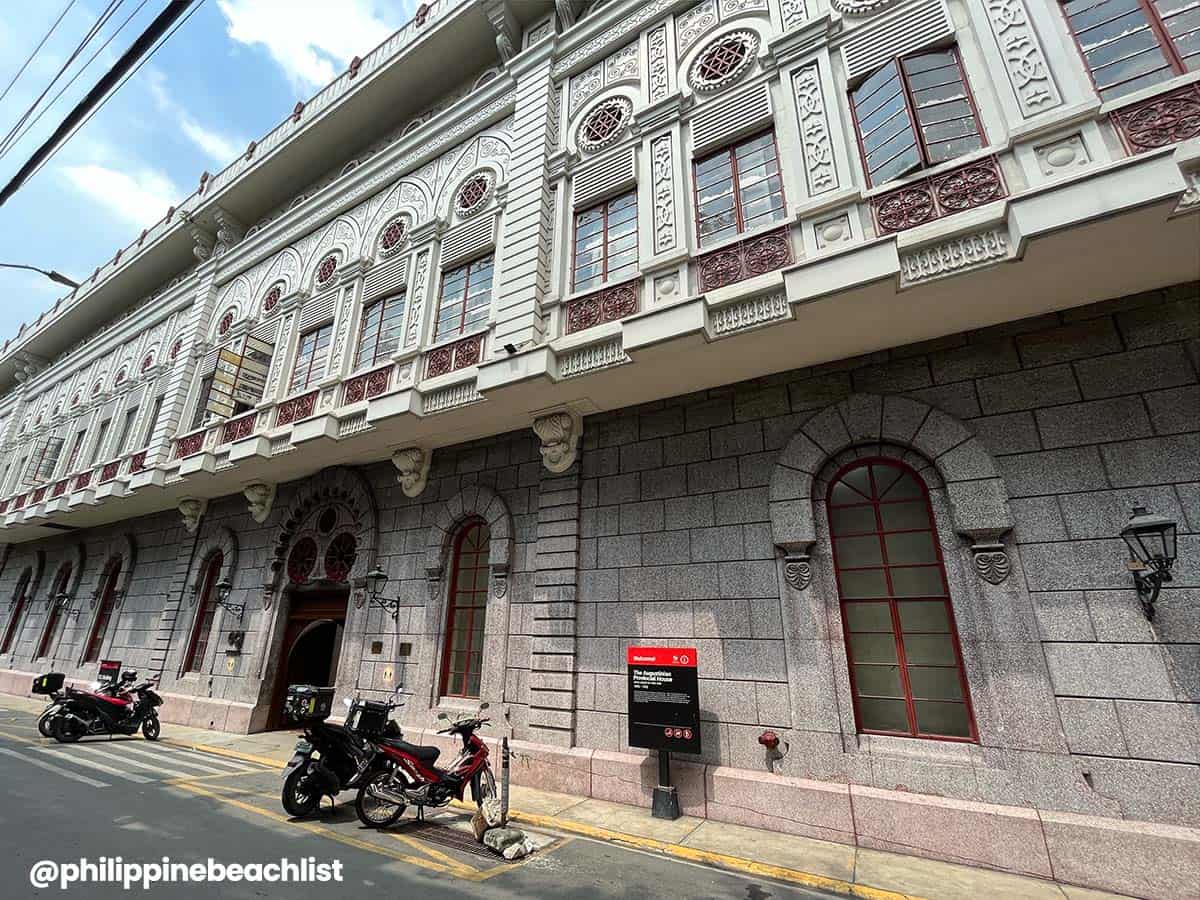
Other sites to see :
- Palacio del Gobernador
- ECJ Building
- Galleria de los Presidentes
- Baluartillo de San Jose
- Intendencia or Aduana Building
- Monument to Charles IV, King of Spain
If you’re interested in learning more about Intramuros and its historical sites, you can take a guided walking tour of the walled city. The Intramuros Walking Tour usually includes entrance fees and a DOT-accredited guide.
✅ CHECK ITINERARY & BOOK HERE!
Where to Stay in Intramuros
If you can’t get enough of Intramuros, you can actually book a stay with the two hotels within the historic city. However, there are more hotel options in other areas in the City of Manila. The area closest to Intramuros is Ermita where you will also find other attractions in the city like the National Museum Complex and Rizal Park. Malate, a popular food and nightlife district, is also a possible option. Below are some of the hotels you can book for your stay in Manila.
- THE BAYLEAF INTRAMUROS ✅ Booking.com | Agoda | Hotels.com
- WHITE KNIGHT HOTEL INTRAMUROS ✅ Booking.com | Agoda | Hotels.com
- THE MANILA HOTEL ✅ Booking.com | Agoda | Hotels.com
- RIZAL PARK HOTEL ✅ Booking.com | Agoda | Hotels.com
- ADMIRAL HOTEL MANILA – MGALLERY ✅ Booking.com | Agoda | Hotels.com
- SHERATON MANILA BAY ✅ Booking.com | Agoda | Hotels.com
You can also check out these posts for more hotel suggestions around Manila:
- Top 10 Hotels in Ermita
- Top 10 Hotels in Malate
- Top 10 Hotels Near Manila Bay
- Historic Hotels in Metro Manila
Find more Manila Hotels!

Updates Log
2024.01.06 – Updated opening hours
2023.12.29 – Updated Where to Stay section
2023.11.03 – First uploaded
More Tips on YouTube ⬇️⬇️⬇️

Related Posts
- Top 10 Things to Do & Tourist Spots Along LRT-1 in Manila
- Top 10 Hotels in Malate (Manila) 2023
- Top 10 Hotels in Ermita (Manila) 2023
- Top 12 Things to Do & Tourist Spots in Makati
- Top 20 Things to Do & Tourist Spots in BGC
- NAIA Coupon Taxi Rates for Metro Manila Areas
- NAIA 3: List of Shops and ATMs for Passengers & NON-PASSENGERS (Landside)
- Top 10 Best Batangas Beaches to Visit

Leave a Reply Cancel reply
Email address
This site uses Akismet to reduce spam. Learn how your comment data is processed .
- 1.5 MILLION Followers
- 11,400 Followers
- 5600 Followers

Intramuros Tourist Spots & Things to Do: How to Go To and Places to Visit
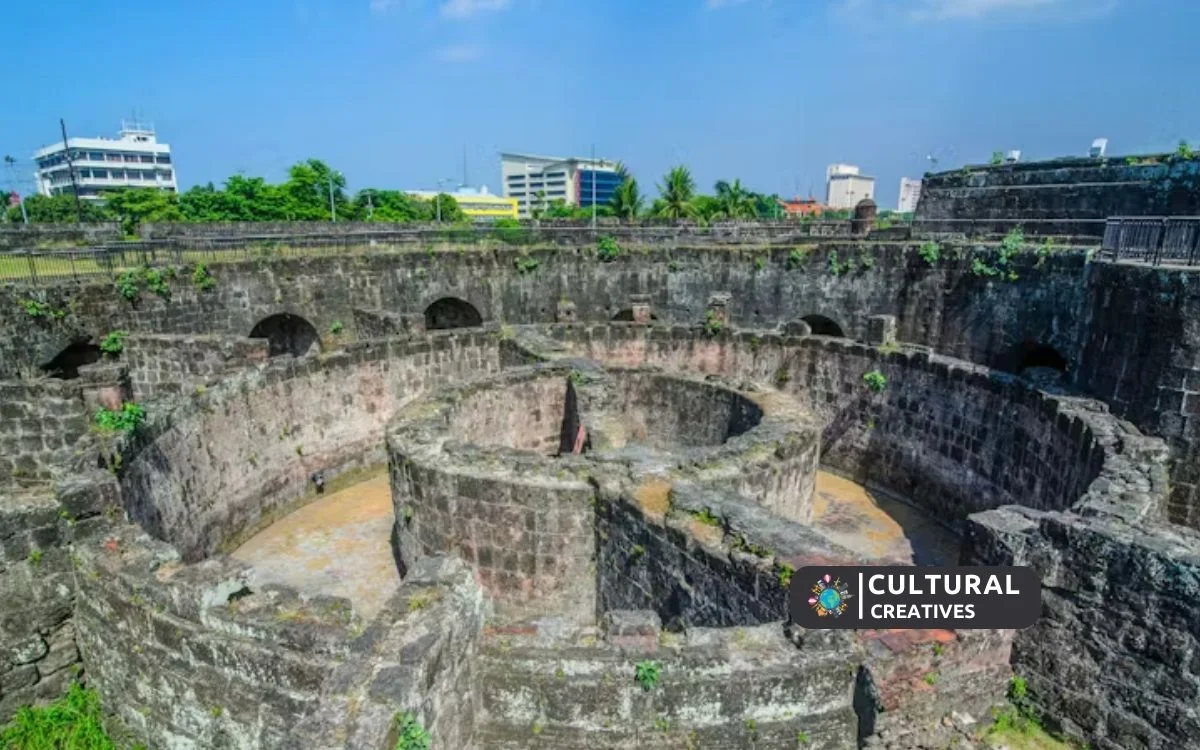
Intramuros, known as the Walled City, is a historical enclave in Manila, Philippines. It is a must-visit for history enthusiasts and tourists alike.
In the heart of Manila lies Intramuros, a rich tapestry of the Philippines’ colonial past and present. Enclosed by massive stone walls and moats built during the Spanish colonial period, this area is a timeless journey into a bygone era.
Explore the historic fortifications, such as Fort Santiago, and marvel at the old-world architecture of San Agustin Church, a UNESCO World Heritage Site. The cobbled streets and preserved ruins offer a unique glimpse into the city’s storied past, making it a perfect educational excursion for families and a picturesque backdrop for culture vultures. Embrace the cultural heritage as you stroll through museums, churches, and ancestral buildings, or opt for a kalesa ride for an authentic Filipino experience. Engaging guides abound, ensuring visitors not only see but also understand the significance of every site.
Best Time To Go To Intramuros
Selecting the optimal time for your visit to Intramuros can greatly enhance your experience of this historic walled city in the heart of Manila. Seasoned travelers often recommend planning your excursion between December and February, when the climate is most agreeable—cooler temperatures and a gentle breeze complement the walking tours.
This period, avoiding the intense heat of the Philippine summer and the peak of the rainy season, allows for comfortable exploration of Fort Santiago, San Agustin Church, and other notable landmarks. To witness Intramuros at its most consider aligning your trip with local festivities and cultural events, which add a unique flair to the already charming locale.
Early mornings during the weekdays present a quieter setting, perfect for those aiming to appreciate the sites without the crowd.
Dry Season | December – May
Exploring Intramuros during the dry season, particularly from December to May, presents the perfect opportunity for tourists to fully appreciate the historical beauty of this walled city under the blissful Manila sunshine. With the sky mostly clear, the grandeur of colonial architecture and cobbled streets stands out, inviting travelers to leisurely wander without the worry of sudden downpours.
This period is ideal for those keen on outdoor activities and photography, ensuring that the scenes of Fort Santiago, the magnificence of San Agustin Church, and the charming Plaza Roma are captured in perfect light. The warm weather also complements the many open-air cafes and restaurants, allowing visitors to relish local cuisine amidst the echoes of the past.
As the sun sets, the cooler evenings offer a comfortable ambiance to enjoy the roof deck views and cultural shows that make a trip to Intramuros truly memorable.
Holidays | September – December
Exploring Intramuros during the festive months from September to December offers a particularly enchanting experience. As Manila’s oldest district and a historical gem, the walled city takes on an extra layer of beauty with holiday decorations lighting up its colonial architecture.
Wander through the cobbled streets and you’ll stumble upon a multitude of cultural treasures that stand as a testament to the Philippines’ rich past. Whether it’s the storied Fort Santiago, the grand Manila Cathedral, or the charming Plaza Roma, each landmark is steeped in history and celebration.
Vendors and artisans line the pathways, selling craft goods and traditional snacks that perfectly complement the atmosphere of the season. This time of year, the air is filled with a sense of anticipation and revelry, making a visit to Intramuros more than just a tour—it’s a festive journey through the heart of Filipino heritage.
Climate And Weather
Exploring the historic walls of Intramuros offers a glimpse into the past amidst the present of Manila. The walled city presents a tropical climate, consistent with the Philippines, ensuring warm weather year-round with seasonal rain patterns. Visitors planning their journey should consider the dry season from November to April, where outdoor excursions are most pleasant.
During these months, the likelihood of rain is minimal, allowing for uninterrupted tours through the cobbled streets and ancient fortifications. Conversely, the wet season from May to October sees significant rainfall, which can add a sense of drama to the already rich tapestry of sights but may require more flexible travel plans.
The weather in Intramuros plays a significant role in shaping the experience, a factor tourists should heed to make the most of their visit to this culturally and historically significant spot.
What To Wear
Deciding on appropriate attire can significantly enhance your experience in this historic walled city of Manila. Given the Philippine climate and the extensive walking you’ll likely be doing, comfort should be your top priority. Opt for breathable fabrics like cotton or linen to keep cool under the sun.
A hat and sunglasses would not only serve as fashionable accessories but also provide protection from the harsh rays. Shoes with proper support are essential, as cobblestone streets await to test your endurance. Remember, a day exploring Intramuros is as much about cultural immersion as it is about personal convenience – dressing smartly ensures you enjoy each moment without any undue distractions.
How To Go To Intramuros
Navigating your way to Intramuros, the historic walled city within Manila, is an exciting experience steeped in cultural heritage. One can easily reach this iconic destination by utilizing various modes of transportation available in the capital. Public transportation, such as jeepneys and taxis, offers an affordable option and provides a glimpse into the everyday life of locals.
Meanwhile, travelers seeking comfort may opt for ride-hailing services, which conveniently offer direct access to Intramuros’ gates. For those feeling adventurous, a scenic walk from neighboring districts gives a leisurely approach, allowing visitors to absorb the atmosphere of Manila as they make their way to the city’s historic core.
With each route presenting its own unique narrative, your journey to Intramuros becomes an integral part of the adventure, setting the stage for the wonders that await within its ancient walls.
Navigating through the historic streets of Intramuros can be effortlessly accomplished by hailing a taxi. With a simple flag-down, visitors are soon on their way to witness the storied past encapsulated within the walled city. Taxis provide a direct route to this cultural hub, offering convenience and comfort for those eager to explore the blend of Spanish colonial architecture and local heritage.
As the taxi meanders through the narrow cobblestone lanes, passengers get an intimate view of the fortifications, churches, museums, and ruins that speak volumes about Manila’s rich history. Opting for a taxi also allows tourists the flexibility to visit specific attractions at their own pace, making it an ideal choice for a personalized Intramuros experience.
Intramuros is made effortless with the accessibility of train services in the area. The convenience of rail transportation brings the rich tapestry of the walled city’s history into easy reach for enthusiasts and casual tourists alike.
Vividly imagine stepping off the train and being immediately transported back in time, as you wander through cobblestone streets, past centuries-old structures that whisper tales of a bygone era. Each corner of Intramuros offers a new discovery, from the imposing fortress of Fort Santiago to the stunning Baroque architecture of San Agustin Church, ensuring that your journey is as educational as it is exhilarating.
The train’s rhythmic chug serves as the perfect prelude to a day spent exploring the heart of Philippine history, setting the tempo for a truly memorable excursion.
Journey to Intramuros by bus offers an immersive peek into the Philippines’ historical core. Convenient and cost-effective, the public transport system connects adventurers to this walled city’s splendors. Tourists are greeted by the cobblestone streets and Spanish-era edifices that tell tales of a bygone era.
A sense of timelessness envelops visitors as they explore storied structures like Fort Santiago and Manila Cathedral. Each corner of Intramuros reveals layers of Filipino history, culture, and artistry, making the trip not just a physical journey but a voyage through the rich tapestry of the nation’s past.
With every step, the enchantments of this treasured locale unfold, offering a tapestry of experiences to those who arrive with a curious mind and a thirst for exploration.
By Car Booking App
Exploring the historic walls of Intramuros becomes a breeze when opting for the convenience of a car booking app. Visitors can effortlessly tour the grandeur of this fortified area at their own pace, allowing for a personalized journey through time.
Not to be missed are the iconic sites such as Fort Santiago, an old military prison under Spanish rule, and the stunning Baroque architecture of San Agustin Church. Relishing the old-world charm amidst the hustle of Manila, tourists can indulge in the blend of history, culture, and modernity.
A car at one’s disposal means spontaneous stops at hidden gems and the luxury of air-conditioned comfort—a perfect complement to any Intramuros adventure.
By Private Car
Visitors can explore the rich historical tapestry of this tourist spot from the comfort of their private vehicle. With walls that whisper tales of the past, a drive around the area allows for an intimate encounter with the heart of Philippine history.
The blend of cobblestone paths and modern-day thoroughfares makes navigating the storied city both an adventure and a seamless experience. Carefully preserved buildings and structures stand in eloquent testimony to a bygone era, inviting tourists to gaze upon and reflect upon the resilience of culture through time.
This private car tour around Intramuros offers not only convenience but an exceptional vantage point from which to absorb the soul of a city that has stood the test of time.
Getting Around Intramuros: Tourist Spots
Whether you opt for a leisurely walk or a ride on a traditional horse-drawn carriage, known as ‘calesa’, the charm of this town is inescapable. Bicycles and pedicabs provide an active yet intimate way to take in the sites, fitting perfectly into the narrow lanes and allowing visitors to absorb the atmosphere at their own pace.
With a map in hand, tourists can navigate from fortress to church to museum, immersing themselves in a unique blend of Spanish colonial history and Filipino culture. Every turn introduces a new vista, a different slice of history, and an unexpected perspective on old Manila.
1. Pedicabs
Exploring the historic walls of Intramuros, visitors often encounter charming pedicabs, ready to whisk them away on a nostalgic journey through cobblestone streets. These three-wheeled wonders serve as both transport and tour guide, offering a leisurely pace perfect for soaking in the surrounding architecture and ambiance.
Drivers, commonly locals with a wealth of knowledge, are typically eager to share stories and trivia about the area, turning an ordinary commute into an enriching cultural experience. With their colorful canopies fluttering in the breeze, these pedicabs add a touch to the already picturesque scenery of Manila’s famous walled city, making them a unique and practical way to uncover the hidden gems of Intramuros.
The historic streets of Intramuros can’t help but be transported back in time, especially when taking a ride on a traditional Kalesa. These horse-drawn carriages offer a unique vantage point for appreciating the walled city’s old-world charm.
As the clip-clop of the horse’s hooves reverberates against the cobblestone paths, visitors are treated to a leisurely tour of the area’s notable landmarks and architecture, each telling its own story of the Philippines’ colonial past. Opting for a Kalesa ride not only enhances the touring experience but also supports the local carriage drivers, who are often well-versed in the tales and secrets of Intramuros, ready to share them with curious travelers.
Exploring the historic walls of Intramuros can be an invigorating experience, particularly when you choose an environmentally-friendly e-trike as your mode of transportation. These electric tricycles offer a convenient and sustainable way to navigate the cobbled streets while soaking in the rich cultural heritage of this famed tourist spot.
They are readily available for hire, allowing visitors to cover more ground without adding to the pollution within this ancient walled city. Each e-trike ride becomes a journey through time, as the quiet hum of the motor contrasts with the echoes of centuries-old stories etched into the very stones of Intramuros.
Whether you’re a history buff or simply someone who appreciates the charm of old cities, an e-trike tour within the storied walls of Intramuros promises an experience like no other.
4. Bamboo Bike
Exploring the historic walls of Intramuros by bamboo bike offers a unique and eco-friendly experience that combines the nostalgia of the past with sustainable modernity. As you pedal through the cobbled streets, enigmatic remnants of Spanish colonial architecture provide a scenic backdrop.
Imagine the gentle clicking sound of bamboo wheels on stone echoing through ancient alleyways. This novel mode of sightseeing not only supports local craftsmanship but also adds a layer of authenticity to your adventure, taking you back in time within the walled city.
The bamboo bike stands out as an embodiment of Manila’s commitment to green tourism, presenting an intimate connection to the country’s cultural heritage while ensuring minimal impact on the environment. Each ride becomes a personal discovery, unveiling stories etched in every corner of this enduring citadel.
Intramuros offers a deep dive into the heart of Manila’s history. This walled city, once the seat of government during the Spanish era, now stands as a testament to the Philippines’ colonial past. Meandering along the cobblestone streets takes visitors on a journey back in time.
It’s a showcase of historic sites and baroque architecture, where every corner tells a story. Strolling past centuries-old churches, fortresses, and monuments offers a palpable sense of the past, inviting tourists to ponder the tales of Filipino resilience. With every step, the charm of Intramuros unfolds, revealing museums, quaint shops, and local eateries perfect for indulging in authentic Filipino cuisine, creating an immersive experience that’s best enjoyed at one’s own pace.
Here, the legacy of a bygone era is preserved, providing a cultural and educational adventure unlike any other in the Philippine capital.
Where To Stay In Intramuros
Exploring Intramuros, the historic walled city of Manila, is like stepping back in time. A range of accommodation options is available for visitors wanting to immerse themselves in the area’s rich history. From quaint bed and breakfasts housed in restored colonial buildings to luxurious hotels that offer modern amenities while preserving the old-world charm, every traveler can find a place to suit their needs.
Proximity to iconic landmarks such as Fort Santiago, San Agustin Church, and the Manila Cathedral makes staying within the walls of Intramuros a convenient and culturally enriching experience. With cobblestone streets and horse-drawn carriages just outside your door, your stay in Intramuros will be as much about where you rest at night as the historical treasures you journey to by day.
Types Of Accommodations
Exploring Intramuros offers an enriching glimpse into the Philippines’ colonial past, but the adventure necessitates a comfortable place to rest.
Each option presents unique amenities tailored to diverse preferences and budgets. Those seeking an immersive experience might opt for heritage houses converted into lodgings, providing a taste of Filipino culture and hospitality. Alternatively, modern hotels situated in this district offer contemporary conveniences with the charm of old-world aesthetics.
Secure and inviting, accommodations in Intramuros cater to history buffs and casual tourists alike, ensuring a restful pause between excursions around the city’s storied nooks.
Neighborhoods And Areas
Delving into the historic heart of Manila, the walled city of Intramuros brims with cultural charm and centuries-old stories waiting to be discovered. This enclave serves as a living museum, with cobblestone streets and colonial houses painting a picture of the Philippine capital during Spanish rule.
Tourists can explore Fort Santiago, a citadel used as a military fortress by the Spaniards, and marvel at the architectural beauty of Manila Cathedral, a cornerstone of Filipino spirituality. The dungeons, now silent, once buzzed with the echoes of revolutionaries, while the lush gardens are ideal spots for introspective strolls or leisurely picnics.
Every corner of Intramuros has a tale to tell, inviting visitors to step back in time and experience the Philippines’ rich history firsthand. Each neighborhood within its walls offers a unique vibe, showcasing a blend of the country’s past influences and present ambitions.
Accommodation Highlights
A range of accommodations awaits, catering to diverse preferences and budgets. From charming boutique hotels echoing the Spanish colonial era to modern hostels offering a social vibe, visitors can find the perfect base for exploring the area’s rich heritage.
Cozy bed and breakfasts are sprinkled throughout, providing a homey touch amid the backdrop of cobbled streets and antique structures. Whether it’s the allure of classic architecture or the convenience of contemporary amenities, each lodging option promises a unique experience, with thoughtful services designed to enhance your stay and immerse you in the local culture.
What To See And Things to Do In Intramuros
Marvel at the centuries-old stone walls and fortifications that have withstood the test of time. Amble along cobblestone paths leading to iconic landmarks such as Fort Santiago, a bastion of history where stories of valor and hardship are etched in its storied chambers.
Discover the stunning beauty of San Agustin Church, a baroque masterpiece and UNESCO World Heritage site, alongside the fascinating treasures housed within the San Agustin Museum. Thriving within these ancient walls, lush gardens and quaint shops offer a respite from the city, while the aroma of traditional Filipino cuisine entices visitors, promising a sensory feast.
With each step, delve deeper into the rich tapestry of Filipino history, culture, and heritage that Intramuros proudly preserves within the heart of modern Manila.
The Stone Walls, Gates, And Forts
Intramuros invites history enthusiasts and culture vultures alike into a world molded by time and narratives of the past. As eyes roam across the formidable stone ramparts, each crevice tells its own story, whispering secrets of the days when Spanish galleons dominated the horizon.
Standing before the iconic gates and forts—these sentinels of history—visitors are transported to an era where every brick played a part in safeguarding a colonial city. Within this walled enclave, the fusion of old-world charm and the cacophony of modern-day Manila creates a tapestry of experiences that is both unique and captivating, offering a profound appreciation for the Philippines’ rich historical tapestry.
Through this exploration, the resilience and beauty of Intramuros are unveiled, cementing its status as a cherished cornerstone of Philippine heritage.
The Public Squares And Notable Structures
Exploring the historic heart of Manila, the captivating district of Intramuros offers a journey back to the Philippines’ Spanish colonial period through its enchanting public squares and architectural marvels. As visitors meander through cobblestone streets, the rich tapestry of history reveals itself in grandiose structures that have withstood the test of time.
Walled City wanderers can immerse themselves in the stories echoing off the ancient walls of storied fortifications and churches. Each plaza presents a unique snapshot of community life, inviting tourists to pause and soak in the atmosphere where the past seamlessly blends with the present.
With every step, the relics of yesteryears command awe, leaving an indelible mark on the hearts of those who roam this enduring symbol of Philippine heritage.
The Architecture And Faith Within The Churches
Delving into the heart of Intramuros reveals an array of stunning religious edifices, each resonating with historical resonance and spiritual sanctity. Visitors often find themselves enveloped by the serene ambience that pervades these hallowed halls. Sturdy stone foundations and sprawling stained glass windows testify to the enduring legacy of colonial Spanish architecture.
Each church stands as a testament to the profound faith that shaped, and continues to influence, the cultural fabric of the Philippines. A walk through these sacred spaces is not merely a step back in time but an immersion into a rich, storied past, where every structure tells its own tale of devotion and artistry.
Intramuros History At These Museums
These cultural havens offer a glimpse into the past where every artifact tells a story, and every exhibit brings a long-gone era to life.
Guests will find themselves transported back in time as they wander through halls that chronicle the nation’s journey, from pre-colonial times through Spanish occupation and toward modern-day independence. Each museum serves as a custodian of the Philippines’ storied heritage, allowing tourists to understand the profound impact of history on the country’s current identity.
What To Eat And Drink In Intramuros
Delving into the culinary treasures of Intramuros offers a delightful experience for your taste buds, blending history with the pleasure of good food. This historic walled city in the heart of Manila provides an array of traditional Filipino dishes that promise to tantalize your palate.
Local eateries and quaint cafes take pride in serving heirloom recipes passed down through generations, such as the savory adobo and the succulent lechon, each carrying the rich flavors of Filipino heritage. Thirsts are quenched with sips of “sago’t gulaman,” a beloved sweet drink, or a cup of thick, Spanish-inspired hot chocolate.
Street vendors abound, tempting you with street food staples like kwek-kwek and fish balls. Every meal in Intramuros is a chance to savor a piece of the Philippines’ history, and no visit is complete without indulging in the delicious cuisine that this district has to offer.
Local Cusine
Intramuros sets your senses alight with the aromatic blend of Spanish, Chinese, and Malay flavors, a testament to the district’s rich historical influences. Roaming the cobblestone streets will lead you to eateries serving up traditional Filipino dishes like adobo, a savory mix of meat marinated in soy sauce and vinegar, or sinigang, a tangy tamarind soup that entices with its complex sourness.
Food enthusiasts revel in sampling balut, a local delicacy, while the less adventurous can savor suman, sticky rice wrapped in coconut leaves. The warm, hospitable locals are always eager to share a plate and their stories, making meals in Intramuros much more than a feast for the palate—they become a tapestry of cultural connection and shared history.
Recommended Best Restaurants And Bars
Culinary enthusiasts eager to taste the fusion of Filipino-spanish cuisine will revel in the authentic dishes offered by local eateries, each brimming with flavors that tell tales of cultural amalgamation.
For those desiring a more casual vibe, quaint bars spill onto cobblestone streets, providing a backdrop for an evening of relaxation and conviviality. Visitors will find that both restaurants and bars in Intramuros exude an ambiance that’s as rich in history as it is in taste, creating a dining experience that is truly unique to this enchanting district of Manila.
Whether it’s enjoying a hearty meal or sipping on cocktails with a view of the iconic city walls, the options within the walled city cater to every taste and occasion.
Practical Information And Tips
Exploring Intramuros, the historic walled area of Manila, offers a journey into the Philippines’ colonial past. Arm yourself with a map, comfortable footwear, and ample water to stay hydrated throughout your excursion. The tropical climate can be quite unpredictable, making an umbrella a versatile accessory against sun and rain alike.
Buying tickets online for attractions like Fort Santiago and the Manila Cathedral in advance simplifies your visit and often grants skip-the-line privileges. For a truly immersive experience, consider hiring a licensed tour guide; their stories enrich the understanding of each site’s historical significance.
Budget-conscious travelers will appreciate the affordable entrance fees and easily accessible local cuisine from nearby vendors. Embrace the local culture by taking a calesa ride, but negotiate the price beforehand to avoid overpaying. Lastly, keeping an eye on personal belongings in crowded areas will let you enjoy the ancient city with peace of mind.
Exploring the historic core of Manila, Intramuros provides an immersive glimpse into the Philippines’ Spanish colonial past. Its cobbled streets echo stories of bygone days, resonating through the grand architecture that lines them. Language serves as a bridge in this enclave, with locals offering tales and trivia that enrich every visitor’s experience.
Tour guides often speak both Filipino and English fluently, ensuring travelers from across the globe can fully engage with the site’s rich history. Even the signage around the tourist spots offers bilingual information, indicating the city’s commitment to welcoming international guests and preserving its multicultural heritage.
Through conversations with artisans and the cadence of street performers, each word spoken within these resilient walls is a link to the past and a treasure for linguistic enthusiasts.
Exploring Intramuros, a historic walled area within the city of Manila, Philippines, offers travelers a chance to step back into the colonial era. As visitors navigate this cultural gem, understanding the local currency is vital. The Philippine Peso, denoted by the symbol ₱, is the official currency used throughout Intramuros and the rest of the country.
Tourists are encouraged to have some cash on hand as they roam the cobblestone streets and visit the numerous historical sites, although major credit cards are widely accepted at many establishments. Currency exchange facilities are accessible within the district, providing a convenient way for international visitors to convert their money to pesos, ensuring a seamless and enjoyable experience in this enchanting tourist spot.
Safety Tips
Exploring Intramuros can be a fascinating journey into the past, but visitors should prioritize their well-being while navigating its historic walls. Prior planning is essential; ensure you’re well-informed about the local climate to dress appropriately, helping you avoid heatstroke or discomfort during your tour.
Mindfulness is key in safeguarding valuables; pickpocketing can occur in tourist spots, so keeping belongings secure and within sight is crucial. It’s also wise to stay within designated areas and be cautious when venturing off the beaten path—old structures can be unstable, and it’s best to respect barriers put in place for your protection.
Remember, hydration is vital in the Philippine heat, so carry water to stay refreshed throughout your adventure. By adhering to these guidelines, your visit to Intramuros will not only be enriching but also secure.
Public Transportation Tips
Navigating the streets of Intramuros can be an adventure in itself, with jeepneys, tricycles, and pedicabs offering an authentic Manila experience. One convenient option is to grab a colorful, horse-drawn calesa ride, a throwback to the Spanish colonial period, delivering a historical ambiance you can’t find anywhere else.
Always have small bills ready for transportation fares; exact change shortens transactions and gets you on your way more efficiently. Remember to check the latest travel advisories, as routes and available transport modes may vary. Embrace local advice on travel times to avoid the rush hour, ensuring you make the most out of your visit to this historic enclave within the Philippine capital.
Keep an eye out for the local transit app options—they’re incredibly handy for real-time updates and navigating Intramuros like a pro.
What To Pack
You’ll want to ensure your backpack contains essentials that accommodate the tropical climate and historical exploration. Lightweight, breathable clothing will keep you cool in the warm weather, while a sturdy pair of walking shoes is crucial as you meander along the cobblestone streets.
Remember to bring a refillable water bottle to stay hydrated and a hat or umbrella for shade. Capturing the sights of the walled city calls for a fully charged camera or smartphone. To protect against the sun’s rays, pack sunscreen with a high SPF.
Keep a physical map or downloaded guide app handy, as GPS signals can be unpredictable within the thick fortress walls. Lastly, space for souvenirs should not be overlooked; you’ll find unique artisan crafts that serve as perfect mementos of your visit.
Sample Itinerary In Intramuros
Imagine stepping back in time as you wander along cobbled streets lined with Spanish-era buildings.
From the storied Fort Santiago to the grand Manila Cathedral, your path leads you to a series of sites steeped in historical significance. Meander through the lush gardens of Casa Manila Patio and perhaps pause at Bahay Tsinoy to gain insight into the Chinese influences in Filipino culture.
As the day unfolds, take a leisurely kalesa ride, ensuring to admire the intricate artistry of San Agustin Church along the way. With each stop meticulously planned to enrich your understanding and appreciation of this unique city, your Intramuros experience promises to be a vivid tapestry of the Philippines’ rich colonial legacy.
Day 1: Intramuros Church And History
The ancient churches stand as silent witnesses to bygone eras, their architecture a testament to the artistry and devotion of the past.
Visitors meander through cobbled streets, where the echoes of history mingle with the fervor of the present. Each step in this storied district reveals layers of heritage, with tales of valor and spirituality etched into its very stones. The heritage sites, with their meticulous preservation efforts, offer a glimpse into the colonial influences that have shaped the nation, inviting travelers to delve deeper into the history that continues to influence Filipino society to this day.
Day 2: A Tour Of The Wall And Dinner At Bayleaf Intramuros
Day two promises a captivating stroll atop the storied walls, where the echoes of the past blend seamlessly with the gentle whispers of the present.
Each step reveals panoramic views of the city and a clearer understanding of Manila’s rich heritage. As dusk approaches, the experience culminates with a delightful dining encounter at Bayleaf Intramuros. The restaurant offers a fusion of local flavors and breathtaking ambience, providing an impeccable way to savor the cultural journey and the mouthwatering cuisine Manila has to offer.
Day 3: Intramuros And Manila Tour
As you navigate the cobblestone streets, the rich tapestry of the nation’s storied past unfolds before you with every turn.
Sturdy fortifications and ancient churches stand as silent sentinels, testament to centuries of history. The area brims with activity; kalesas (horse-drawn carriages) offer leisurely tours, local artisans showcase their crafts, and each corner reveals yet another picturesque scene begging to be captured in a photograph.
Whether exploring the storied corridors of Fort Santiago or admiring the elegance of San Agustin Church, your day in Intramuros promises a memorable fusion of heritage and city life.
Exploring Intramuros offers a peek into the Philippines’ rich history. This walled city captivates with its timeless charm and array of cultural treasures. Whether it’s walking through Fort Santiago or marveling at Manila Cathedral, visitors leave with unforgettable memories.
Make your journey memorable; Intramuros awaits your discovery.
Leave a Comment Cancel reply
Save my name, email, and website in this browser for the next time I comment.
Most Recent

6 Hidden Dangers at the Million Dollar Highway

6 Hidden Dangers at Fall Foliage in Burlington City

6 Hidden Dangers at Fall Foliage Manchester

6 Tourist Traps to Avoid in Cherohala Skyway Drive

Avoid These 6 Overpriced Amenities at Alpine Pond Trail
Weekly Wrap
Subscribe now to receive my exclusive Weekly Wrap email every Friday. Dive into fresh updates, handy travel tips, exciting giveaways, and more.
Address 120 S 7th St, Las Vegas, NV 89101, USA
About Contact
© 2024 Culturalcreatives.org
Our Itinerary and Travel Guide to Intramuros and Binondo in Manila, Philippines
Travelling to Intramuros is a great way to appreciate the rich history of the Philippines . Intramuros was built 300 years ago by Spaniards when the Philippines was still a colony of Spain. It is the original Manila enclosed within the walls. While my friends and I are Filipinos, we’re glad that we hired a personal tour guide as it made our trip more convenient and informative. Otherwise, our trip will be merely sightseeing.
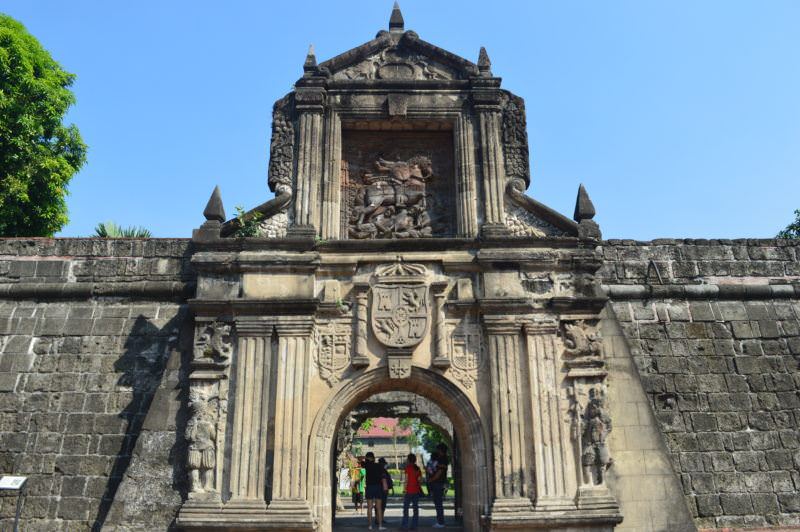
We started our trip at Fort Santiago . Entrance fee is Php 75.00 per head . Fort Santiago is the defense fortress of Intramuros and was used as a storage for gun powders and jail for prisoners. Jose Rizal, the Philippines national hero, was imprisoned here before he was executed. Normally, Fort Santiago can be explored less than 1 hour but it took us approximately 2 hours to explore it because our tour guide gave us lots of interesting stories. I felt like going back in the past. Lol!
- 10 Resorts Near Metro Manila for Team Building & Company Outings
- Metro Manila – 10 Weekend Getaways near Metro Manila
- 20 Towns and Cities You Must Visit in Mindanao [Philippines]
- Travel Guide to Popular Cities in the Philippines – 25 Day Trips That You Can Do in the Philippines
- Complete Guide to Car Rental & Driving in the Philippines (for Foreigners)

Inside the Fort Santiago is also Rizal Shrine , a museum displaying different memorabilia related to Jose Rizal.

After Fort Santiago, we went to Plaza de Roma and Manila Cathedral. During the Spanish times, the plaza was considered as the center of the city where public events are held. Now, a statue of King Charles IV of Spain can be seen in the middle of the plaza in honor of him sending the first smallpox vaccine to the Philippines.
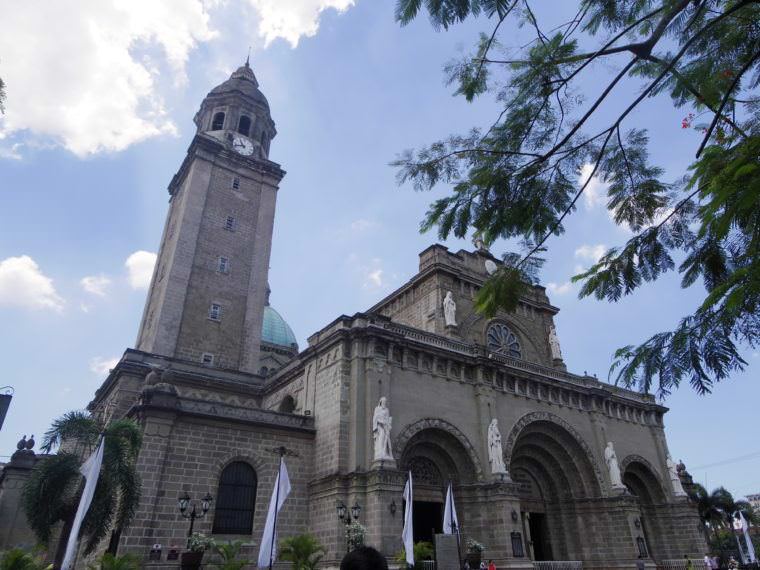
The Manila Cathedral is the premier church and the first cathedral of the Philippines. It was rebuilt multiple times after suffering from different natural disasters and being a victim of war. Note that you need to take off your hats before going inside the church as a sign of respect.

After Manila Cathedral, we went to San Agustin Church . It is the only church in Intramuros which survived World War II. Interestingly, at the entrance of the church are Foo dogs or Chinese guardian lions. According to our tour guide, the church was built by Chinese laborers which are the reason why certain features of the church show Chinese influences.

Part of the San Agustin Church is the San Agustin Museum where different artistic works of historical and cultural significance can be seen. Entrance fee is Php 200.00 per head . The museum is perfect for those who enjoys arts and/or other historical artifacts but can be boring for those looking for more active experiences.

My friend, Kisse, who loves going to churches had a good time here. We have to wait for her most of the times because she stays too long in one place before moving to the next room. Lol! Note that the museum closes during lunchtime at 12 PM – 1 PM.
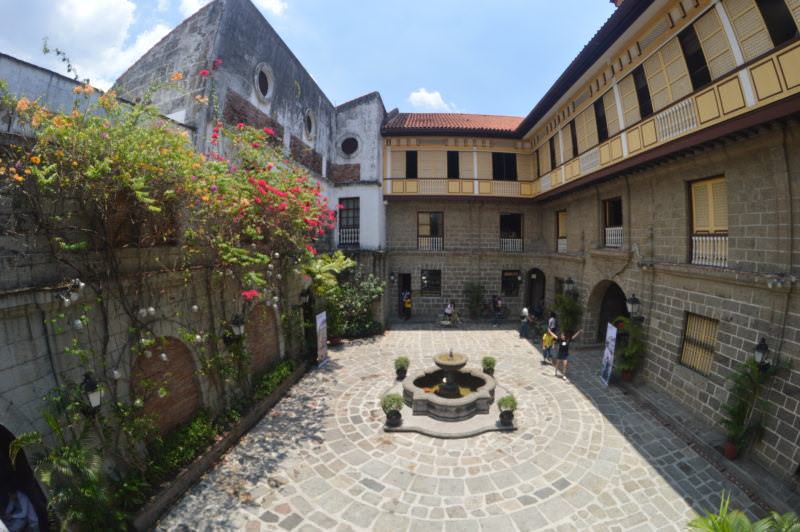
And to complete our trip, we also visited Casa Manila just across San Agustin Church. Entrance fee is Php 75.00 per head . Casa Manila is a museum depicting the lifestyle of the rich Filipino families in the past.
Although exhausted from the hot weather, we enjoyed traveling to Intramuros. To maximize our day, we also did a Binondo Food Trip after our Intramuros Tour. We had our lunch at Binondo, the World’s Oldest Chinatown, just across Intramuros.

If you’re planning to visit Intramuros, here is a copy of our itinerary for your reference:
8:30 AM – Meetup at Fort Santiago / Start of Intramuros Tour 10:30 AM – Plaza Roma 10:40 AM – Manila Cathedral 11:00 AM – San Agustin Church & Museum 12:00 AM – Casa Manila 12:30 PM – End of Intramuros Tour / To Binondo

After our Intramuros Tour, my friend and I decided to have a Binondo Food Trip as Binondo is just across Intramuros. Binondo is the World’s Oldest Chinatown. It was granted by the Spanish government, when the Philippines was still a colony of Spain, as a permanent settlement to the Chinese immigrants who converted to Catholicism.

We’re all hungry by this time (it was around 1PM already) so we had our lunch first at Quik Snack . Located along the narrow street of Carvajal, Quik Snack is a bit difficult to find. Luckily, we have a tour guide to navigate for us. The humble restaurant serves affordable home-cooked Chinese meals with huge servings.
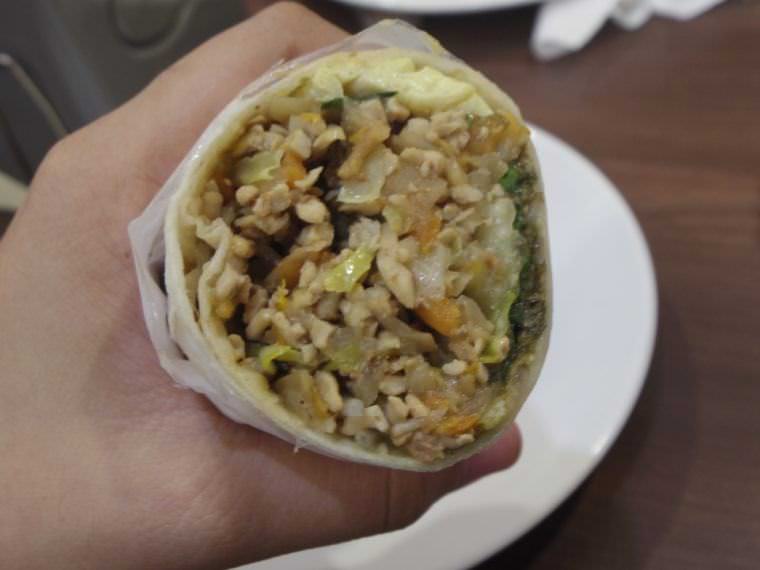
For appetizer, we had their Fresh Lumpia and Lumpia Quitos . Lumpia Quitos is almost similar in taste to Fresh Lumpia but it’s serve on a bite size crusty wrapper and is more juicy.

My favorite orders at Quick Snack are Amah’s Kiampong and the Indonesian Tauhu . The kiampong tastes authentic and the tofu is flavorful. They’re almost a perfect match. By the way, Amah is a Chinese term for grandmother on the father side.

On the other hand, my friends really enjoyed the spicy Sate Beef Noodles . But beware of its serving size as its really huge. One order of it can be good for like around 5 persons.
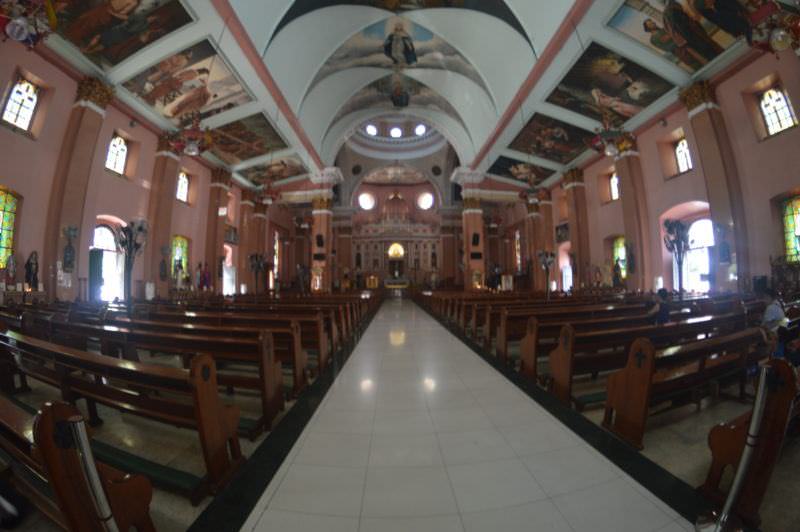
After eating lunch, we walked our way to Binondo Church to digest all the food we ate. Lol! The pagoda-like belfry of the Binondo church is an evidence of the Chinese influences to the Catholic church.

After visiting Binondo Church, we resumed our food trip and went to Dong Bei Dumplings . Dong Bei Dumplings served northern-style Chinese handmade dumplings. We were lucky to witness how the Kuchay Dumplings are made in action.

We also passed by to an altar where you can see how the different religions merged at Binondo. The altar is presented with a cross in the middle but you can use incense sticks to pray.

Our walk lead us to Po Chuan Tin Bakery , a traditional bakery which serves traditional hopia.

We also tried Shanghai Fried Siopao and it’s really good. The bottom part of its siopao is fried hence the name.
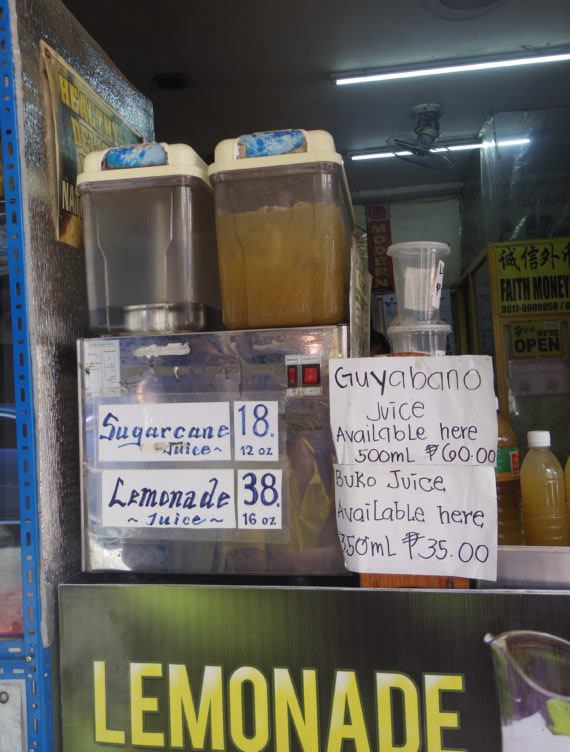
The long walk and the hot weather has made us thirsty. Fortunately, just on time, we reached the Sugarcane Vendor where we had a cold and sweet Sugarcane Juice . The juice is made from real sugarcane.

Since it’s almost time for an afternoon snack break, we ended our trip at Wai Ying Fastfood where we had some dim sums. Dim sum is a Chinese term for a snack.
While we have a list of target shops/restaurants to try at Binondo, we didn’t really have a fixed itinerary for our food trip as we just went along the flow with our tour guide.
Here’s a picture of our tour guide, Ms. Chit. Aside from being a Department of Tourism accredited tour guide, I learned that she is also a college professor. You can contact her through these numbers 09195854187/09228577027.
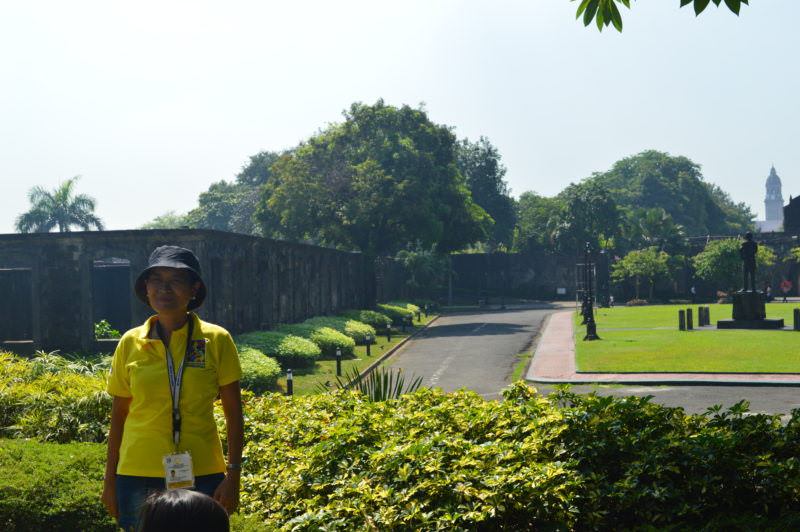
About the Writer

Are you on Pinterest? Pin these!
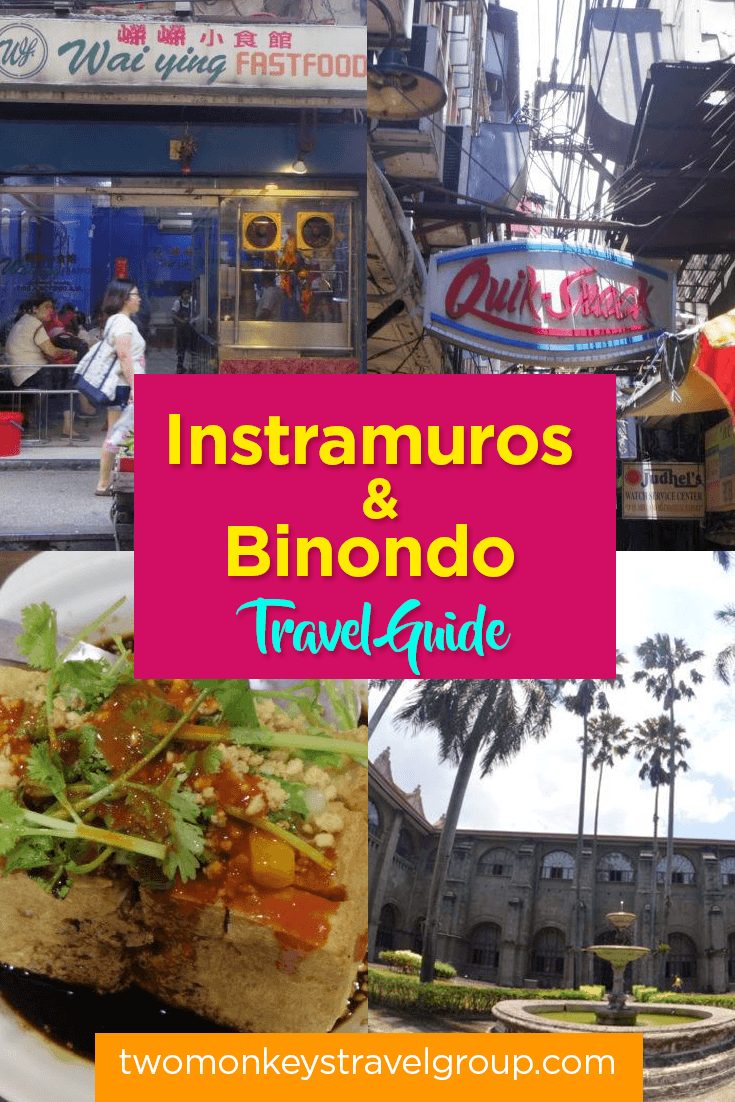
Leave a Reply Cancel reply
Your email address will not be published. Required fields are marked *
This site uses Akismet to reduce spam. Learn how your comment data is processed .
13 thoughts on “ Our Itinerary and Travel Guide to Intramuros and Binondo in Manila, Philippines ”
Thanks for the guide! These places serve a lot of cultural value for us Filipinos so it’s nice to go around and visit them every once in a while.
I have two visitors from the USA and would like to avail of the Intramuros and Binondo tours on 4 March 2020. In view of this, may I get your package and payment arrangements, please.
Thank you and hope to receive your response soonest. Chona
Nice one! May I know how did you guys went around the intramuros? I mean, is the tour guide include transport? Thank you.
This itinerary sounds perfect for my kids, 20 & 17, who will be traveling to Manila on their own later this year. How do I get in touch with this tour guide & how much did you pay for the tour you did with her? Eager to hear from you! Anna
Great itinerary. Very interested. My friends and I want to go on this tour. There are four of us, maybe more, around January 14, 2020. Can you give me how much this tour costs, with a good guide, of course! Thanks!
Hi there, do they provide tour guide upon registering in Fort Bonifacio? Or is there a tour guide readily available? We have a teammate from Costa Rica and have business trip here. After her 5-day training, she want’s to have a city our in Intramuros tomorrow. We are not prepared for this, hope there is readily available guide.
Interesting! Can you give us details of your guide for both tours and approximate costs?
Thankyou very much,
Jan McKeogh
Hi. Thank you for this very helpful write up! May I know the contact number of your tour guide? I plan to bring some friends to a tour of Intramuros next month. Thank you.
Hi! May we know how much was the tour guide fee, plus Ms. Chit’s contact number? Thanks!
how do i contact the owner of this blog? I tried the contact us link, but it doesn’t work
you can contact at [email protected]
Hi Regine! Helpful article. May I seek your help in booking a personal tour guide via SunnyTrip.ph?
Good article
COPYRIGHT DISCLAIMER: Many of the articles on Two Monkeys Travel Group are guest posts by a number of Approved Contributors and are hosted by Two Monkeys Travel Group. Approved Contributors control their own work and post freely to our site. This includes all text and images that they use within their own work. All contributors are instructed to follow internationally recognised copyright and intellectual property guidelines. Two Monkeys Travel Group takes its own responsibilities very seriously, so if you feel that any part of this work is abusive in any way, please send us an email so that we can investigate - [email protected]
DISCLOSURE: Please note that some of the links above are affiliate links. So when you make a purchase we sometimes make a small commission, at no extra cost to you. The cost to you remains the same, sometimes even cheaper if we have negotiated a special deal for our readers.We use all of the companies we have listed here and that’s why they are in this list, but of course we need to keep Two Monkeys Travel Group running as well as it can, which is exactly what you’re helping with if you do decide to buy or book something through an affiliate link! If you have any more questions about the companies we use or any other companies you’re looking at, just email us and we’ll be happy to help. Please see our full disclaimer page for more information.
Written by Two Monkeys Travel - Contributor
Two Monkeys Travel Group – Community Travel Blog is a travel blog and website. We quickly grew into a valuable source of inspiring travel stories, advice, itineraries and travel guides, with the aim of demonstrating how to live a sustainable life of travel, whilst living your own definition of success. If you'd like to contribute and write a guest post, contact us at [email protected]
11 Best Hiking Treks To Experience in Nepal
Getting the most out of your holiday in bali, 5 best things to do in canggu, bali, indonesia [diy travel guide to canggu], 10 awesome things to do in florence, italy, africa unveiled: discovering the continent’s hidden gems and iconic landmarks, related posts, diy travel guide to koh tao, thailand [with suggested tours], the top 4 uk luxury hotels for an autumn staycation, diy travel guide to camp netanya of batangas, philippines, tawi tawi travel guide – best diy things to do in tawi-tawi, philippines, previous post, experience south and western australia with a nullarbor roadtrip, the pottinger hotel – the most strategically located hotel in hong kong island, subscribe to our newsletter.
Receive tips on how you can live a sustainable long-term travel lifestyle!
- First Name *
- Email This field is for validation purposes and should be left unchanged.
Intramuros Manila Walking Tour with Guide | Fort Santiago, Rizal's Cell

Description
Travel back in time and learn more about the history of Manila and the Philippines when you book this Intramuros walking tour. This tour is perfect for those seeking a unique experience in the city, as it allows you to explore a historic site and learn more about it through a series of activities. This tour will last around two hours and comes with the assistance of a tour guide.
Make sure you dress appropriately for the experience. Note that this is a walking tour, so light and comfortable clothing is recommended.
On the day of your tour, meet with your tour guide at the plaza across the Manila Cathedral. Make sure to be there at least thirty minutes before the start of the tour to avoid delays. You will then begin your walking tour of Intramuros.
Your first stop is the time capsule . Located in Plaza de Sta. Isabel, behind the Memore Manila 1945 monument, the time capsule has this simple inscription: To be opened on February 18, 2045. This date is a hundred years after the Battle of Manila, which the monument commemorates
Next, you’ll head to the President’s Gallery . This outdoor installation along Sta. Lucia Street features plaques of all the past presidents in the country, starting from its first president, Emilio Aguinaldo. As you walk past each plaque, you will learn a bit about how these leaders helped shape the country into what it is today.
Afterward, you’ll head to Fort Santiago , one of the oldest fortifications in Manila. It was built in 1571 during the Spanish period. Although it has been damaged by war and an earthquake, it has been repaired and restored several times and now serves as a memorial to the Filipino people who fought for independence.
Finally, you’ll visit Jose Rizal’s prison cell , which is located in Museo ni Rizal . This is where Rizal was imprisoned for 56 days. While the building was destroyed during the Battle of Manila in 1945, it was reconstructed and turned into a museum dedicated to the national hero. Learn more about the country's past with this Intramuros walking tour. Check the availability by choosing a date.
Attractions
What to bring
Good to know.
Tour Information: This activity is subject to availability.
Meet-up Information: Guide to the Philippines will send tour reminders at least (1) day before the tour date through your registered email address. Make sure to have the electronic copy of your confirmed tour voucher ready. On the day of the tour, your assigned Tour Guide will meet you at the Plaza across Manila Cathedral at least thirty (30) minutes prior to start of the tour. Strictly no latecomers or tour reservation might be forfeited. To arrange for a private hotel pick-up and drop-off, please email [email protected]. Additional transportation fees apply.
Tour Proper: Please be reminded also to dress appropriately. All guests are expected to do their share in ensuring their safety and security as well as that of their personal belongings. Guide to the Philippines and Tour Operators are not liable for the loss or damage to any personal belongings left unattended during the tour.
Children Friendly: Yes!
Pet Friendly: No.
Senior Citizen/PWD Friendly: Yes. However, please be advised that this tour includes mostly walking tours and may not be suitable for PWDs or individuals with existing cardiovascular ailments.
Cancellation Policy: The operator may cancel the activity in case of force majeure or unforeseen circumstances like weather conditions. In this case, you will be given the option to reschedule or request a full refund. Schedule cancellation requests must be made 48 hours before your original subject to approval. No shows are not entitled to reschedule and refund.
Similar tours

Download the Philippines’ biggest travel marketplace to your phone to manage your entire trip in one place
Scan this QR code with your phone camera and press the link that appears to add the Philippines’ biggest travel marketplace into your pocket. Enter your phone number or email address to receive an SMS or email with the download link.
Top things to do in the Philippines
Discover all the adventures you can experience in the Philippines

Philippines Tour Packages

Boracay Island

Bohol Island

Cebu Island

Coron Palawan

El Nido Palawan

Siargao Island

Iloilo City and Nearby


IMAGES
VIDEO
COMMENTS
Make sure, though, to allot at least an hour for traveling to your next destination, especially if you have to take public transportation—and don't forget your Intramuros map! Day 1: Intramuros Church and History. 08:00 AM - Fort Santiago and Rizal Shrine. 10:00 AM - Plaza Roma: Manila Cathedral, Ayuntamiento, and Palacio del Gobernador
Go here to get a hi-res copy of this map.. Go here to get a hi-res copy of this map.. 1987 Cadastral Map. No hi-res available. Go here for more information.. Go here to download our Intramuros tour map. Maps also available for Fort Santiago, Casa Manila, and Baluarte de San Diego.
Beginning Your Intramuros Walking Tour. Gate into Fort Santiago, Philippines. bugking88/Getty Images. Begin at the Intramuros Visitors' Center at the restored Baluartillo de San Francisco Javier in Fort Santiago (Google Maps). This is an ideal jumping-off point for many walking tours through Intramuros, or independent visits to Intramuros' top ...
However, Intramuros has so much more to offer, which one can glimpse with the help of their newly released walking tour brochures. Vibrant as they are educational, these five-fold brochures are updated versions of the existing ones distributed by the Intramuros Administration. All four maps were designed by The Public School Manila who manages ...
6. Casa Manila. Next on the list is probably one of the most aesthetically pleasing locations you can ever witness in Intramuros. Casa Manila is a popular museum within the Walled City depicting the classy colonial lifestyle of Filipinos during the golden era of the Spanish government. Credit: Wikimedia Commons.
This Intramuros travel guide will help you navigate the streets of the 64-hectare walled city with historical sites, churches, monuments, and museums. It's a travel guide for kids (and the kids at heart too!). Most, if not all, of the attractions have free admission fee. Download and print this Intramuros Map so you can plan your tour easily.
Intramuros Meaning. Intramuros is a Latin word which literally translates to "within the walls". Measuring 3 kilometers long and 6 meters high, its massive strong walls were built to protect the area from intruders. It is a significant historical site that served as the center of government, religion, economy, education and power during the ...
The Intramuros tour is a historical walking tour around the famous fort built by the Spanish. The tour will focus on the greatest and darkest moments during the long history of Intramuros, with details of what transpired within the walls of Intramuros during the Battle of Manila and beyond. You can enjoy learning something about this historical ...
4. Baluarte de San Diego: This well-preserved bastion showcases the military architecture of Intramuros. Visitors can explore its ramparts and enjoy a panoramic view of the surrounding area. 5. Plaza de Roma: Located in front of the Manila Cathedral, Plaza de Roma is a historic square surrounded by important structures like the Ayuntamiento and the Palacio del Gobernador.
Experience and learn Intramuros's rich history and culture on this guided walking tour. Discover Manila with a local guide by your side and marvel at the San Augustine Church, Manila Cathedral, and Fort Santiago, to name a few. Intramuros is known as the walled city because it was mainly built as a defensive curtain to defend the occupant from ...
Contributed by The Wandering Roomies. Intramuros Map which I got from the Internet. Intramuros, also known as the 'Walled City', is a place rich in history. Based from the meaning of the name itself, 'within the walls', one can assume that the place is built with strong stone walls which surround and fortify the district.
The best outdoor activities to do in Intramuros are: Manila: Historical Bamboo Bike Tour in Intramuros. Manila: Guided Sunset Bamboo Bike Tour in Intramuros. Full-Day Manila City, Tagaytay Taal Volcano and Lake Tour. Manila and Mt. Pinatubo: 3-Day Package. See all outdoor activities in Intramuros on GetYourGuide.
The Budget Tour (30 minutes) costs Php 300 and the Grand Intramuros Tour (1 hour) costs Php 900. BOOK via KLOOK White Knight Electric Chariot Intramuros Day Tour. 2. Hop on a bamboo bike - Bambike. A guided tour costs Php 999. You can also rent a bike on-site for Php 200 per hour.
Tour Guide: Arsen Quijano; Schedule of Events and Activities for August 2024; Schedule of Events and Activities for July 2024; Join us for another Intramuros Learning Session on 27 June 2024, 10AM at Teatro, Fort Santiago. Intramuros unveils Centro de Turismo: A gateway to the past, present, and future
Unpick the historical threads of Philippine culture as you stroll Manila's 16th-century walled city, Intramuros, with a guide. Hear how Manila evolved through Malay, Spanish, American, and Japanese eras; learn about pre-colonization peoples and the national hero Dr. José Rizal; and see colonial-era sights including San Agustin Church and Museum, a UNESCO World Heritage Site. Enjoy bottled ...
The Walled City of Intramuros in Manila City is located south of the Pasig River and east of Manila Bay. It was constructed by Spanish colonizers in the mid 1500s after their arrival to serve to establish their military and political bases in Asia. Intramuros was constructed as a city with a privileged status with churches, schools and ...
There are multiple ways to do a tour of the walled city: walking, a pedicab tour, or a guided bike tour. If you are more into cycling, Bambike Ecotours Intramuros offers another fun way to go around Intramuros. Bambike has guided bike tours which will take you to the historic spots in the area while riding a bamboo bike.
Exploring the historic walls of Intramuros, visitors often encounter charming pedicabs, ready to whisk them away on a nostalgic journey through cobblestone streets. These three-wheeled wonders serve as both transport and tour guide, offering a leisurely pace perfect for soaking in the surrounding architecture and ambiance.
Itinerary: San Agustin Church, Barrio San Luis, Baluarte de San Diego, Fort Santiago. Tour duration: 4 hours. Rates: PHP 800.00 per head. Reservation required. Call 09277281367 (Globe) or 09311726585 (Smart).
If you're planning to visit Intramuros, here is a copy of our itinerary for your reference: 8:30 AM - Meetup at Fort Santiago / Start of Intramuros Tour. 10:30 AM - Plaza Roma. 10:40 AM - Manila Cathedral. 11:00 AM - San Agustin Church & Museum. 12:00 AM - Casa Manila. 12:30 PM - End of Intramuros Tour / To Binondo.
This shared tour is perfect for those who want to learn more about Filipino-Chinese culture and check out both Binondo and Intramuros tourist spots. It is inclusive of a DOT-accredited tour guide, entrance fees, coordinator and photographer assistance, a disposable raincoat (if it rains), and premium van transfers with pick-up and drop-off.
On the day of your tour, meet with your tour guide at the plaza across the Manila Cathedral. Make sure to be there at least thirty minutes before the start of the tour to avoid delays. You will then begin your walking tour of Intramuros. Your first stop is the time capsule. Located in Plaza de Sta. Isabel, behind the Memore Manila 1945 monument ...
By continuing to use this directory you understand the following: That the rates may vary depending on the tour guide, duration of tour, time of the day, or season. That the tour guides listed in this directory are free-lance, private tour providers. They have no employer-employee relationship with the Intramuros Administration or the ...